SpringBoot2雷神视频学习笔记
- 一、SpringBoot 是什么
- 二、基础入门
- 三、容器功能
- 四、日志
- 五、Web 开发
- 六、Docker
- 七、数据访问
- 八、单元测试
- 九、指标监控
- 十、原理解析
一、SpringBoot 是什么
1、为什么要用 SpringBoot
-
Spring Boot makes it easy to create stand-alone, production-grade Spring based Applications that you can "just run".
- 能快速创建出生产级别的 Spring 应用。
2、SpringBoot 优点
-
Create stand-alone Spring applications
- 创建独立 Spring 应用
-
Embed Tomcat, Jetty or Undertow directly (no need to deploy WAR files)
- 内嵌 Web 服务器(默认使用 Tomcat)
-
Provide opinionated 'starter' dependencies to simplify your build configuration
- 自动starter依赖,简化构建配置
-
Automatically configure Spring and 3rd party libraries whenever possible
- 自动配置 Spring 以及第三方功能
-
Provide production-ready features such as metrics, health checks, and externalized configuration
- 提供生产级别的监控、健康检查及外部化配置
-
Absolutely no code generation and no requirement for XML configuration
- 无代码生成、无需编写 XML
SpringBoot 是整合 Spring 技术栈的一站式框架。
SpringBoot 是简化 Spring 技术栈的快速开发脚手架。
3、SpringBoot 缺点
- 迭代快,需要时刻关注版本变化。
- 封装太深,内部原理复杂,不容易精通。
4、微服务
James Lewis and Martin Fowler (2014) 提出微服务完整概念。
In short, the microservice architectural style is an approach to developing a single application as a suite of small services, each running in its own process and communicating with lightweight mechanisms, often an HTTP resource API. These services are built around business capabilities and independently deployable by fully automated deployment machinery. There is a bare minimum of centralized management of these services, which may be written in different programming languages and use different data storage technologies.-- James Lewis and Martin Fowler (2014)
- 微服务是一种架构风格
- 一个应用拆分为一组小型服务
- 每个服务运行在自己的进程内,也就是可独立部署和升级
- 服务之间使用轻量级 HTTP 交互
- 服务围绕业务功能拆分
- 可以由全自动部署机制独立部署
- 去中心化,服务自治。服务可以使用不同的语言、不同的存储技术
5、分布式
分布式的困难
- 配置管理
- 服务发现
- 远程调用
- 负载均衡
- 服务容错
- 服务监控
- 链路追踪
- 日志管理
- 任务调度
- ......
分布式的解决
- SpringBoot + SpringCloud
6、云原生(Cloud Native)
原生应用如何上云。
上云的困难
- 服务自愈
- 弹性伸缩
- 服务隔离
- 自动化部署
- 灰度发布
- 流量治理
- ......
上云的解决
- Docker 容器化技术
- Kubernetes 容器编排,简称 k8s
- DevOps,企业 CI/CD,构建企业云平台
- 拥抱新一代架构 Service Mesh 与 Serverless
二、基础入门
1、环境准备
参照官方帮助文档配置:
-
Java 8 及以上。
-
Maven 3.3+:项目管理工具,可以对 Java 项目进行构建、依赖管理。
- pom.xml 按照官方帮助文档设定。
-
Gradle 6.x:基于 Apache Ant 和 Apache Maven 概念的项目自动化构建开源工具。它使用一种基于 Groovy 的特定领域语言(DSL)来声明项目设置,目前也增加了基于 Kotlin 语言的 kotlin-based DSL,抛弃了基于 XML 的各种繁琐配置。
-
SpringBoot CLI:命令行工具,用于使用 Spring 进行快速原型搭建。它允许你运行 Groovy 脚本,这意味着你可以使用类 Java 的语法,并且没有那么多的模板代码。
-
IntellIJ IDEA: 微云上下载。
1.1 Maven 设置
给 Maven 的 settings.xml 中添加默认 JDK 版本以及默认 UTF-8 编码。
<profiles>
<profile>
<id>JDK1.8</id>
<activation>
<activeByDefault>true</activeByDefault>
<jdk>1.8</jdk>
</activation>
<properties>
<maven.compiler.source>1.8</maven.compiler.source>
<maven.compiler.target>1.8</maven.compiler.target>
<maven.compiler.compilerVersion>1.8</maven.compiler.compilerVersion>
<!--编译编码-->
<project.build.sourceEncoding>UTF-8</project.build.sourceEncoding>
</properties>
</profile>
</profiles>
1.2 IDEA 设置
将 Maven 整合进来,IDEA 中 设置 和 新项目设置 中的 Maven 都要设定。
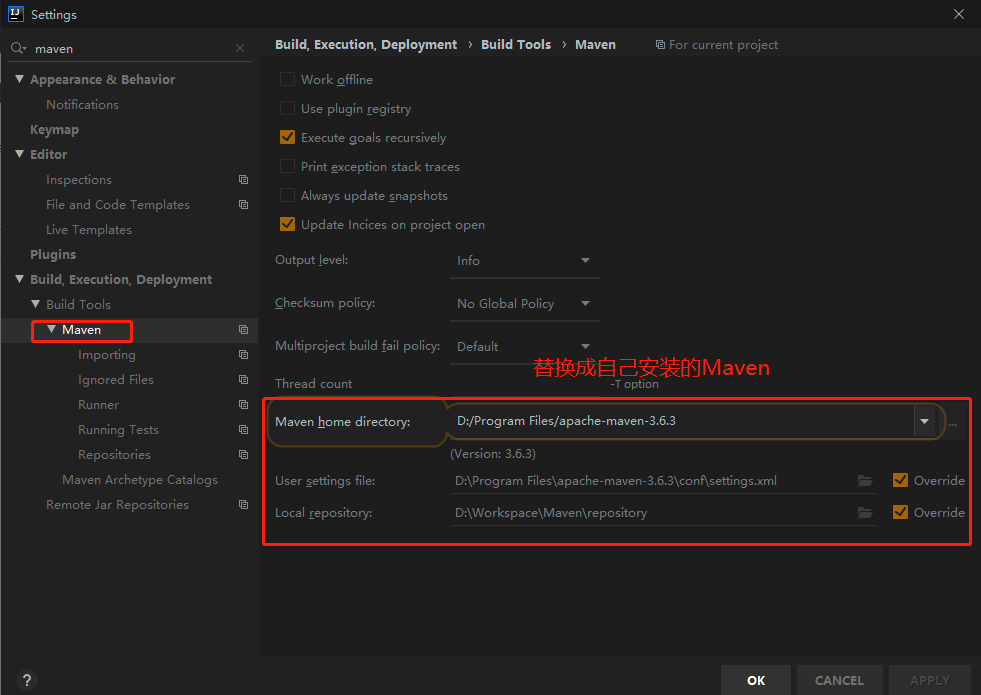
2、HelloWorld
功能:浏览器发送/hello请求,服务器接受请求并处理,响应 Hello World 字符串。
2.1 创建一个 Maven 工程
新建一个名为 spring-boot-01-helloworld 的 Maven 工程。
2.2 导入 SpringBoot 相关的依赖
pom.xml 中加入 SpringBoot 依赖。
<parent>
<groupId>org.springframework.boot</groupId>
<artifactId>spring-boot-starter-parent</artifactId>
<version>2.2.6.RELEASE</version>
<!-- 一般依赖最新版本 -->
</parent>
<dependencies>
<dependency>
<groupId>org.springframework.boot</groupId>
<!-- Web 应用开发场景 -->
<artifactId>spring-boot-starter-web</artifactId>
</dependency>
</dependencies>
2.3 编写主程序 MainApplication
src\main\java 下新建一个 com.atguigu.HelloWorldMainApplication类。
/**
* SpringBootApplication 标注一个主程序类,说明这是一个SpringBoot应用
*/
@SpringBootApplication
public class HelloWorldMainApplication {
public static void main(String[] args) {
// 启动Spring应用
SpringApplication.run(HelloWorldMainApplication.class,args);
}
}
2.4 编写 Controller、Service
src\main\java 下新建一个 controller.HelloController 类。
@Controller // 作为控制器组件注册到容器中
public class HelloController {
@ResponseBody // 返回结果(json或xml)直接写入 HTTP response body 中,一般在Ajax异步获取数据时使用
@RequestMapping("/hello") // 映射/hello请求,即该方法处理/hello请求
public String hello(){
return "Hello World!";
}
}
2.5 运行主程序测试
Ctrl+F5 运行 HelloWorldMainApplication。
2.6 简化部署
<build>
<plugins>
<plugin>
<groupId>org.springframework.boot</groupId>
<!-- Maven 插件,可以将应用打包成一个可执行的 jar 包 -->
<artifactId>spring-boot-maven-plugin</artifactId>
<configuration>
<!-- 打包时跳过测试 -->
<skipTests>true</skipTests>
</configuration>
</plugin>
</plugins>
</build>
将这个应用打成 jar 包,直接使用java -jar的命令进行执行。
3、Hello World探究
3.1 POM文件
3.1.1 父项目
项目下的 pom.xml:
<parent>
<groupId>org.springframework.boot</groupId>
<!-- SpringBoot 的版本仲裁中心 -->
<artifactId>spring-boot-starter-parent</artifactId>
<version>2.2.6.RELEASE</version>
</parent>
spring-boot-starter-parent 包下的 spring-boot-starter-parent-a.b.c.pom(a.b.c 就是上面 pom.xml 中的版本号,本文是 2.2.6):
<!-- 管理SpringBoot应用里面的所有默认依赖版本 -->
<parent>
<groupId>org.springframework.boot</groupId>
<artifactId>spring-boot-dependencies</artifactId>
<version>2.2.6.RELEASE</version>
<relativePath>../../spring-boot-dependencies</relativePath>
</parent>
以后我们导入默认依赖是不需要写版本号的(没有在 dependencies 里面管理的依赖需要声明版本号)。
3.1.2 启动器
<dependency>
<groupId>org.springframework.boot</groupId>
<!-- Web 应用开发场景 -->
<artifactId>spring-boot-starter-web</artifactId>
</dependency>
spring-boot-starter-*:SpringBoot 官方场景启动器,会导入相关开发场景所需的所有依赖。
*-spring-boot-starter:自定义的场景启动器。
SpringBoot 将所有的功能场景都抽取出来,做成一个个的 starter(启动器),只需要在项目里面引入这些 starter,相关场景的所有依赖都会导入进来。要用什么功能就导入什么场景的启动器,引入之后记得点击编辑区右上角的 m 图标,来下载这些依赖。
SpringBoot 支持的所有场景。
3.2 主程序类
/**
* SpringBootApplication 标注一个主程序类,说明这是一个SpringBoot应用
*/
@SpringBootApplication
public class HelloWorldMainApplication {
public static void main(String[] args) {
// 启动Spring应用
SpringApplication.run(HelloWorldMainApplication.class, args);
}
}
@SpringBootApplication:标注在某个类上说明这个类是 SpringBoot 的主配置类,SpringBoot 就应该运行这个类的 main() 方法来启动 SpringBoot 应用。
4、快速创建 SpringBoot 项目
4.1 IDEA:使用 Spring Initializer 快速创建项目
项目类型选择 Spring Initializr,修改完组(公司名)、工件(项目名)和Java版本后,选择我们需要的模块(如 Spring Web),向导会联网创建 SpringBoot 项目并下载到本地。
- 主程序已经生成好了,只需编写自己的业务代码。
- resources文件夹中目录结构
- static:静态资源, js、css、images。
- templates:模板页面(SpringBoot 默认默认不支持 jsp 页面),可以使用模板引擎(FreeMarker、Thymeleaf)。
- application.properties:配置文件,可以修改一些默认设置。
4.2 Eclipse:使用 STS 快速创建项目
三、容器功能
1、配置文件
SpringBoot 使用一个全局的配置文件,配置文件名是固定的。
- application.properties
- application.yml 或 application.yaml(建议使用)
配置文件的作用:修改 SpringBoot 自动配置的默认值。
YAML(YAML Ain't Markup Language)
YAML A Markup Language:是一种标记语言
YAML isn't Markup Language:不是一种标记语言
Yet another Markup Language:仍是一种标记语言
优点:没有额外的定界符,更轻量,更易读。
2、YAML语法
2.1 基本语法
key: value-> value 前面一定要有空格- 大小写敏感
- 使用缩进表示层级关系
- 缩进不允许使用tab,只允许空格
- 缩进的空格数不重要,只要相同层级的元素左对齐即可
#表示注释
server:
port: 8081
path: /hello
2.2 值的写法
2.2.1 字面量
普通的值(数字,字符串,布尔值)
k: v
字符串默认不用加上单引号或者双引号。
"":双引号。不会转义字符串里面的特殊字符,特殊字符会作为本身想表示的意思。
name: "zhangsan \n lisi" 输出:zhangsan 换行 lisi
'':单引号。会转义特殊字符,特殊字符最终只是一个普通的字符串数据。
name: 'zhangsan \n lisi' 输出:zhangsan \n lisi
2.2.2 对象、Map
(属性和值、键值对)
k: v 在下一行来写对象的属性和值的关系,注意缩进。
对象还是 k: v 的方式:
friends:
lastName: zhangsan
age: 20
行内写法:
friends: {lastName: zhangsan,age: 18}
2.2.3 数组(List、Set)
用 - 值 表示数组中的一个元素:
pets: - cat - dog - pig
行内写法:
pets: [cat, dog, pig]yaml
3、配置文件值注入
配置文件 application.yml:
person: userName: zhangsan boss: false birth: 2019/12/12 20:12:33 age: 18 pet: name: tomcat weight: 23.4 interests: [篮球,游泳] animal: - jerry - mario score: english: first: 30 second: 40 third: 50 math: [131,140,148] chinese: {first: 128,second: 136} salarys: [3999,4999.98,5999.99] allPets: sick: - {name: tom} - {name: jerry,weight: 47} health: [{name: mario,weight: 47}]
JavaBean:
/**
* @ConfigurationProperties:告诉SpringBoot将本类中的所有属性和配置文件中相关的配置进行绑定。
*/
@Component // 只有将组件注册到容器中,才能使用容器提供的ConfigurationProperties功能。
@ConfigurationProperties(prefix = "person") // 映射到配置文件中的person属性。
@Data
public class Person {
private String userName;
private Boolean boss;
private Date birth;
private Integer age;
private Pet pet;
private String[] interests;
private List<String> animal;
private Map<String, Object> score;
private Set<Double> salarys;
private Map<String, List<Pet>> allPets;
}
@Data
public class Pet {
private String name;
private Double weight;
}
自定义的类和配置文件绑定一般没有提示,我们可以导入配置文件处理器。
<!-- 导入配置文件处理器,配置文件进行绑定就会有提示 --><dependency> <groupId>org.springframework.boot</groupId> <artifactId>spring-boot-configuration-processor</artifactId> <optional>true</optional></dependency>
3.1 配置文件的坑
3.1.1 中文乱码
application.properties 配置中文值的时候,读取出来的属性值会出现乱码问题。但是 application.yml 不会出现乱码问题。原因是,Spring Boot 是以 ISO-8859-1 的编码方式读取 application.properties 配置文件。
3.1.2 加载顺序
Java 的 Properties 加载属性文件后是无法保证输出的顺序与文件中一致的,因为 Properties 是继承自 Hashtable 的, key/value 都是直接存在 Hashtable 中的,而 Hashtable 是不保证进出顺序的。
所以如果需要属性保持有序,请使用 application.yml。
3.1.3 用户名
如果定义一个键值对 user.name=xxx , 这里会读取不到对应写的属性值。为什么呢?SpringBoot 的默认 StandardEnvironment 首先将会加载 systemEnvironment 作为首个 PropertySource。而 source 即为 System.getProperties(),按照读取顺序,返回 systemEnvironment 的值即 System.getProperty("user.name"),Mac 电脑会读取自己的登录账号。
3.3 @Value和@ConfigurationProperties比较
| 项目 | @ConfigurationProperties | @Value |
|---|---|---|
| 功能 | 批量注入配置文件中的属性 | 分别指定 |
| 松散绑定(松散语法) | 支持 | 不支持 |
| SpEL | 不支持 | 支持 |
| JSR-303数据校验 | 支持 | 不支持 |
| 复杂类型封装 | 支持 | 不支持 |
无论配置文件是 yml 还是 properties 他们都能获取到值。
如果说,我们只是在某个业务逻辑中需要获取一下配置文件中的某项值,使用 @Value。
如果说,我们专门编写了一个 JavaBean 来和配置文件进行映射,我们就直接使用@ConfigurationProperties。
4、输入数据校验
@Component
@ConfigurationProperties(prefix = "person")
@Validated // 启用数据校验
public class Person {
/**
* <bean class="Person">
* <property name="lastName" value="字面量/${key}从环境变量、配置文件中获取值/#{SpEL}"></property>
* <bean/>
*/
// lastName必须是邮箱格式
@Email
// @Value("${person.last-name}")
private String lastName;
// @Value("#{11*2}")
private Integer age;
// @Value("true")
private Boolean boss;
private Date birth;
private Map<String,Object> maps;
private List<Object> lists;
private Dog dog;
5、加载配置文件
5.1 @PropertySource
加载指定的 properties 配置文件。
/**
* @ConfigurationProperties:告诉SpringBoot将本类中的所有属性和配置文件中相关的配置进行绑定。
*/
@Component // 只有将组件注册到容器中,才能使用容器提供的ConfigurationProperties功能。
@PropertySource(value = {"classpath:person.properties"}) // 指定加载配置文件person.properties。
@ConfigurationProperties(prefix = "person") // 映射到配置文件中的person属性。
//@Validated
public class Person {
/**
* <bean class="Person">
* <property name="lastName" value="字面量/${key}从环境变量、配置文件中获取值/#{SpEL}"></property>
* <bean/>
*/
//lastName必须是邮箱格式
// @Email
//@Value("${person.last-name}")
private String lastName;
//@Value("#{11*2}")
private Integer age;
//@Value("true")
private Boolean boss;
5.2 @ImportResource
为了兼容 Spring 应用,导入 Spring 的 xml 配置文件,让配置文件里面的内容生效。
@ImportResource(locations = {"classpath:beans.xml"}) // 导入Spring的配置文件@SpringBootApplicationpublic class SpringBoot02ConfigApplication {
beans.xml:
<?xml version="1.0" encoding="UTF-8"?><beans xmlns="http://www.springframework.org/schema/beans" xmlns:xsi="http://www.w3.org/2001/XMLSchema-instance" xsi:schemaLocation="http://www.springframework.org/schema/beans http://www.springframework.org/schema/beans/spring-beans.xsd"> <bean id="helloService" class="com.atguigu.springboot.service.HelloService"></bean></beans>
SpringBoot 推荐给容器中添加组件的方式。推荐使用全注解的方式:
1、配置类 @Configuration Spring 配置文件
2、使用 @Bean 给容器中添加组件
3、组件注解:@Component、@Controller、@Service、@Repository
/**
* @Configuration指明当前类是一个配置类,替代Spring配置文件。
* 在配置文件中是使用<bean></bean>标签添加组件。
*/
@Configuration
public class MyAppConfig {
// 将方法的返回值添加到容器中,容器中这个组件默认的ID就就是方法名
@Bean
public HelloService helloService() {
System.out.println("配置类使用@Bean给容器中添加组件");
return new HelloService();
}
}
6、配置文件占位符
6.1 随机数
${random.uuid}、${random.value}、${random.int}、${random.long}${random.int(10)}、${random.int[1024,65536]}
6.2 使用占位符
占位符获取之前配置的值,可以使用 : 指定默认值。
person.last-name=王五${random.uuid}person.age=${random.int}person.birth=2020/04/18person.boss=falseperson.maps.k11=v11person.maps.k22=v22person.lists=a,b,cperson.dog.name=${person.hello:hello}_小黑person.dog.age=2
7、Profile
7.1 多 Profile 文件
我们在主配置文件编写的时候,文件名可以是 application-{profile}.properties/yml/yaml。
默认使用 application.properties 的配置。
7.2 yml 支持多文档块方式
server: port: 8081spring: profiles: active: dev---# 文档块2server: port: 8083spring: profiles: dev---# 文档块3server: port: 8084spring: profiles: prod
7.3 激活指定 Profile
1、在 application.properties 配置文件中指定:
spring.profiles.active=dev
2、命令行:
java -jar spring-boot-02-config-0.0.1-SNAPSHOT.jar --spring.profiles.active=dev
可以直接在测试的时候,配置传入命令行参数。
3、虚拟机参数:
-Dspring.profiles.active=dev
8、配置文件加载位置
SpringBoot 启动会扫描以下位置的 application.properties 或者 application.yml 文件作为 SpringBoot 的默认配置文件。
当前工程根目录和 resources 文件夹下:
/config/
/
优先级由高到底,高优先级的配置会覆盖低优先级的配置。
SpringBoot 会从这四个位置全部加载主配置文件,共同起作用形成互补配置。
我们还可以通过 spring.config.location 来改变默认的配置文件位置。
项目打包好以后,我们可以使用命令行参数的形式,启动项目的时候来指定配置文件的新位置。
指定配置文件和默认加载的这些配置文件共同起作用形成互补配置。
java -jar spring-boot-02-config-02-0.0.1-SNAPSHOT.jar --spring.config.location=D:/application.properties
多个配置用空格分开,--配置项=值。
SpringBoot 也可以从外部加载配置。
9、自动配置原理
9.1 引导加载自动配置类
SpringBoot 启动的时候加载主配置类,主配置类上的 @SpringBootApplication 注解开启了自动配置功能 @EnableAutoConfiguration。
@SpringBootConfiguration
@EnableAutoConfiguration // 开启自动配置
@ComponentScan(excludeFilters = { @Filter(type = FilterType.CUSTOM, classes = TypeExcludeFilter.class),
@Filter(type = FilterType.CUSTOM, classes = AutoConfigurationExcludeFilter.class) })
public @interface SpringBootApplication {
9.1.1 @SpringBootConfiguration
标注在某个类上,表示这是一个 SpringBoot 的配置类。
@Configuration:配置类上使用这个注解。
配置类 → 配置文件,配置类也是容器中的一个组件(@Component)。
9.1.2 @ComponentScan
指定扫描哪些包,默认扫描主程序 MainApplication 所在的包及其子包。
9.1.3@EnableAutoConfiguration
开启自动配置功能。
以前我们需要配置的东西,SpringBoot 帮我们自动配置。
@AutoConfigurationPackage
@Import({AutoConfigurationImportSelector.class})
public @interface EnableAutoConfiguration {
@AutoConfigurationPackage:自动配置包。
@Import({Registrar.class})
public @interface AutoConfigurationPackage {
Spring 的底层注解 @Import,给容器中导入一个 Registrar.class 类型的组件。
然后利用 Registrar 将主程序 MainApplication 所在的包及其子包里面的所有组件扫描并配置到 Spring 容器。
-
@Import({AutoConfigurationImportSelector.class}):导入组件。-
利用
AutoConfigurationImportSelector.getAutoConfigurationEntry(AnnotationMetadata annotationMetadata)给容器中导入一些组件; -
可以查看
AutoConfigurationImportSelector.selectImports(AnnotationMetadata annotationMetadata)方法的内容; -
获取候选的配置项。
List<String> configurations = getCandidateConfigurations(annotationMetadata, attributes); -
加载配置
List<String> configurations = SpringFactoriesLoader.loadFactoryNames(this.getSpringFactoriesLoaderFactoryClass(), this.getBeanClassLoader());
-
扫描所有 jar 包类路径下 META-INF/spring.factories,把扫描到的这些文件的内容包装成 properties 对象。
从 properties 中获取到 EnableAutoConfiguration 属性下的类全限定名列表,然后把他们添加到容器中。
# Auto Configure
org.springframework.boot.autoconfigure.EnableAutoConfiguration=\
org.springframework.boot.autoconfigure.admin.SpringApplicationAdminJmxAutoConfiguration,\
org.springframework.boot.autoconfigure.aop.AopAutoConfiguration,\
...
每一个这样的 xxxAutoConfiguration 类都是容器中的一个组件,都加入到容器中,用他们来做自动配置。
9.2 按需开启自动配置项
9.2.1 @Conditional
作用:必须是 @Conditional 指定的条件成立,才给容器中添加组件,配置里面的所有内容才生效。
| @Conditional扩展注解 | 作用(判断是否满足当前指定条件) |
|---|---|
| @ConditionalOnJava | 系统的java版本是否符合要求 |
| @ConditionalOnBean | 容器中存在指定Bean; |
| @ConditionalOnMissingBean | 容器中不存在指定Bean; |
| @ConditionalOnExpression | 满足SpEL表达式指定 |
| @ConditionalOnClass | 系统中有指定的类 |
| @ConditionalOnMissingClass | 系统中没有指定的类 |
| @ConditionalOnSingleCandidate | 容器中只有一个指定的Bean,或者这个Bean是首选Bean |
| @ConditionalOnProperty | 系统中指定的属性是否有指定的值 |
| @ConditionalOnResource | 类路径下是否存在指定资源文件 |
| @ConditionalOnWebApplication | 当前是web环境 |
| @ConditionalOnNotWebApplication | 当前不是web环境 |
| @ConditionalOnJndi | JNDI存在指定项 |
自动配置类必须在一定的条件下才能生效。
我们怎么知道哪些自动配置类生效?
我们可以通过启用 debug=true 属性,来让控制台打印自动配置报告,这样我们就可以很方便地知道哪些自动配置类生效。
=========================
AUTO-CONFIGURATION REPORT
=========================
Positive matches: // 自动配置类启用的
-----------------
DispatcherServletAutoConfiguration matched:
- @ConditionalOnClass found required class 'org.springframework.web.servlet.DispatcherServlet'; @ConditionalOnMissingClass did not find unwanted class (OnClassCondition)
- @ConditionalOnWebApplication (required) found StandardServletEnvironment (OnWebApplicationCondition)
Negative matches: // 没有启动,没有匹配成功的自动配置类
-----------------
ActiveMQAutoConfiguration:
Did not match:
- @ConditionalOnClass did not find required classes 'javax.jms.ConnectionFactory', 'org.apache.activemq.ActiveMQConnectionFactory' (OnClassCondition)
AopAutoConfiguration:
Did not match:
- @ConditionalOnClass did not find required classes 'org.aspectj.lang.annotation.Aspect', 'org.aspectj.lang.reflect.Advice' (OnClassCondition)
9.3 Spring MVC 自动配置
以下是 SpringBoot 对 SpringMVC 的默认配置(WebMvcAutoConfiguration):
-
Inclusion of
ContentNegotiatingViewResolverandBeanNameViewResolverbeans.- 自动配置了
ViewResolver(视图解析器):根据方法的返回值得到视图对象(View),视图对象决定如何渲染(转发?重定向?). ContentNegotiatingViewResolver:组合所有的视图解析器的。- 可以自己给容器中添加一个视图解析器(
@Bean,@Component),SpringBoot 会自动地将其组合进来。
- 自动配置了
-
Support for serving static resources, including support for WebJars (see below).
- 静态资源文件夹路径,包括
webjars。
- 静态资源文件夹路径,包括
-
Static
index.htmlsupport.- 静态首页访问(欢迎页)。
-
Custom
Faviconsupport (see below).- 网站图标支持,即 favicon.ico。
-
自动注册了 of
Converter,GenericConverter,Formatterbeans.-
Converter<S, T>:转换器接口,将源类型S转换为目标类型T。 -
GenericConverter:通用转换器接口,用于两个以上类型之间的转换。 -
Formatter<T>格式化器接口,格式化成目标类型T。@Bean @ConditionalOnProperty(prefix = "spring.mvc", name = "date-format") // 在文件中配置日期格式化的规则 public Formatter<Date> dateFormatter() { return new DateFormatter(this.mvcProperties.getDateFormat()); // 日期格式化组件 }可以自己给容器中添加一个格式化器转换器。
-
-
Support for
HttpMessageConverters(see below).HttpMessageConverter:SpringMVC 用来转换HTTP请求和响应的。HttpMessageConverters是从容器中确定的,获取所有的HttpMessageConverter,然后看哪一个转换器能处理。- 可以自己给容器中添加一个
HttpMessageConverter。
-
Automatic registration of
MessageCodesResolver(see below).- 定义错误代码生成规则。
-
Automatic use of a
ConfigurableWebBindingInitializerbean (see below).- 可以自己给容器中添加一个
ConfigurableWebBindingInitializer来替换默认的。
- 可以自己给容器中添加一个
9.4 扩展SpringMVC
编写一个配置类(@Configuration),是 WebMvcConfigurer 类型。不能标注@EnableWebMvc 。
既保留了所有的自动配置,也能用我们扩展的配置。
// 使用 WebMvcConfigurer 可以扩展 SpringMVC 的功能
@Configuration
public class MyMvcConfig implements WebMvcConfigurer {
@Override
public void addViewControllers(ViewControllerRegistry registry) {
// 浏览器发送 /atguigu 请求来到 success 页面
registry.addViewController("/atguigu").setViewName("success");
}
}
原理:
WebMvcConfigurer是 SpringMVC 的自动配置类;- 在做其他自动配置时会导入;
@Import(EnableWebMvcConfiguration.class)
@Configuration
public static class EnableWebMvcConfiguration extends DelegatingWebMvcConfiguration {
父类 DelegatingWebMvcConfiguration:
@Configuration(proxyBeanMethods = false)
public class DelegatingWebMvcConfiguration extends WebMvcConfigurationSupport {
private final WebMvcConfigurerComposite configurers = new WebMvcConfigurerComposite();
// 从容器中获取所有的 WebMvcConfigurer。
@Autowired(required = false)
public void setConfigurers(List<WebMvcConfigurer> configurers) {
if (!CollectionUtils.isEmpty(configurers)) {
this.configurers.addWebMvcConfigurers(configurers);
// 一个参考实现:将所有 WebMvcConfigurer 相关配置一起调用。
// @Override
// protected void addViewControllers(ViewControllerRegistry registry) {
// this.configurers.addViewControllers(registry);
// }
}
}
- 容器中所有的
WebMvcConfigurer都会同时起作用; - 我们的配置类也会被调用。
效果:SpringMVC 的自动配置和我们的扩展配置都会起作用。
9.5 全面接管 SpringMVC
不使用 SpringBoot 对 SpringMVC 的自动配置,而是使用自定义配置。
只要配置类中添加 @EnableWebMvc 即可:
// 使用 WebMvcConfigurerAdapter 可以来扩展 SpringMVC 的功能
@EnableWebMvc
@Configuration
public class MyMvcConfig extends WebMvcConfigurerAdapter {
@Override
public void addViewControllers(ViewControllerRegistry registry) {
// super.addViewControllers(registry);
//浏览器发送 /atguigu 请求来到 success 页面
registry.addViewController("/atguigu").setViewName("success");
}
}
原理:
为什么使用 @EnableWebMvc 自动配置就失效了。
@EnableWebMvc导入了DelegatingWebMvcConfiguration组件;
@Import(DelegatingWebMvcConfiguration.class)
public @interface EnableWebMvc {
DelegatingWebMvcConfiguration继承了WebMvcConfigurationSupport类;- 把所有系统中的
WebMvcConfigurer拿过来,所有功能的定制都是这些WebMvcConfigurer合起来一起生效的; - 自动配置了一些非常底层的组件,
RequestMappingHandlerMapping、这些组件依赖的组件都是从容器中获取。
- 把所有系统中的
@Configuration
public class DelegatingWebMvcConfiguration extends WebMvcConfigurationSupport {
WebMvcAutoConfiguration只有当容器中没有WebMvcConfigurationSupport组件的时候才生效;
@Configuration(proxyBeanMethods = false)
@ConditionalOnWebApplication(type = Type.SERVLET)
@ConditionalOnClass({ Servlet.class, DispatcherServlet.class, WebMvcConfigurer.class })
// 容器中没有这个组件的时候,这个自动配置类才生效。
@ConditionalOnMissingBean(WebMvcConfigurationSupport.class)
@AutoConfigureOrder(Ordered.HIGHEST_PRECEDENCE + 10)
@AutoConfigureAfter({ DispatcherServletAutoConfiguration.class, TaskExecutionAutoConfiguration.class,
ValidationAutoConfiguration.class })
public class WebMvcAutoConfiguration {
-
而第 2 步中,
@EnableWebMvc已经将WebMvcConfigurationSupport组件导入进来了。 -
导入的
WebMvcConfigurationSupport只是 SpringMVC 最基本的功能。
9.6 修改默认配置
可配置的属性列表。
- SpringBoot 在自动配置很多组件的时候,先看容器中有没有用户自己配置的(
@Bean、@Component)如果有就用用户配置的,如果没有,才自动配置。如果有些组件可以有多个(ViewResolver)将用户配置的和自己默认的组合起来。 - 在 SpringBoot 中会有非常多的
xxxConfigurer帮助我们进行扩展配置; - 在 SpringBoot 中会有非常多的
xxxCustomizer帮助我们进行定制配置。
9.7 总结
-
SpringBoot 先加载所有的自动配置类
xxxAutoConfiguration。 -
每个自动配置类按照条件生效,默认都会绑定
xxxProperties类,xxxProperties类和对应配置文件进行了绑定。 -
定制化配置:
- 用户直接使用
@Bean、@Component替换底层的组件; - 用户去看这个组件是获取的配置文件什么值就去修改。
- 用户直接使用
场景 starter -> xxxAutoConfiguration -> 导入 xxx 组件 -> 绑定 xxxProperties -> 绑定配置文件项(application.properties)
9.8 最佳实践
-
引入场景依赖;
-
查看自动配置了哪些(选做);
- 自己分析,引入场景对应的自动配置一般都生效了;
- 配置文件中
debug=true开启自动配置报告:Negative(不生效) \ Positive(生效)。
-
是否需要修改配置项;
- 参照文档修改配置项。
- Common Application Properties;
- 自己分析,
xxxProperties配置类绑定了哪个配置文件;
- 参照文档修改配置项。
-
自定义加入或者替换组件;
-
编写自定义的配置类
xxxConfiguration+@Bean、@Component替换、增加容器中默认组件。- Web应用:编写一个配置类实现
WebMvcConfigurer即可定制化 Web 功能 +@Bean给容器中再扩展一些组件。
@Configuration public class AdminWebConfig implements WebMvcConfigurer { @Bean public MybatisPlusInterceptor mybatisPlusInterceptor() { MybatisPlusInterceptor interceptor = new MybatisPlusInterceptor(); // 分页拦截器 PaginationInnerInterceptor paginationInnerInterceptor = new PaginationInnerInterceptor(DbType.MYSQL); // 跳回首页 paginationInnerInterceptor.setOverflow(true); // 每页不受限制 paginationInnerInterceptor.setMaxLimit(-1L); interceptor.addInnerInterceptor(paginationInnerInterceptor); return interceptor; } } - Web应用:编写一个配置类实现
-
-
自定义器
xxxCustomizer; -
......
9.9 示例
以 HttpEncodingAutoConfiguration(Http 编码自动配置)为例解释自动配置原理。
@Configuration(proxyBeanMethods = false) // 表示这是一个配置类,关闭 bean 代理(每次获取一个新的 bean,相当于 prototype)
@EnableConfigurationProperties(HttpProperties.class) // 将配置文件中对应的值和HttpProperties绑定起来,并把HttpProperties加入到容器中。
@ConditionalOnWebApplication(type = ConditionalOnWebApplication.Type.SERVLET) // 仅对 Web 应用生效。
@ConditionalOnClass(CharacterEncodingFilter.class) // CharacterEncodingFilter 类存在时生效。SpringMVC中进行乱码解决的过滤器。
@ConditionalOnProperty(prefix = "spring.http.encoding", value = "enabled", matchIfMissing = true)
// 判断配置文件中是否存在某个配置 spring.http.encoding=enabled。
// 即使我们不配置,pring.http.encoding.enabled=true,也是默认生效的。
public class HttpEncodingAutoConfiguration {
// 它已经和SpringBoot的配置文件映射了。
private final HttpProperties.Encoding properties;
// 只有一个有参构造器的情况下,参数的值就会从容器中拿。
public HttpEncodingAutoConfiguration(HttpProperties properties) {
this.properties = properties.getEncoding();
}
@Bean // 给容器中添加一个组件,这个组件的某些值需要从 properties 中获取。
@ConditionalOnMissingBean // 容器中没有这个组件时才生效。
public CharacterEncodingFilter characterEncodingFilter() {
CharacterEncodingFilter filter = new OrderedCharacterEncodingFilter();
filter.setEncoding(this.properties.getCharset().name());
filter.setForceRequestEncoding(this.properties.shouldForce(Type.REQUEST));
filter.setForceResponseEncoding(this.properties.shouldForce(Type.RESPONSE));
return filter;
}
四、日志
1、日志框架
小张要开发一个大型系统。
-
System.out.println("")。将关键数据打印在控制台。去掉?写在一个文件?
-
框架来记录系统的一些运行时信息。日志框架 。zhanglogging.jar。
-
高大上的几个功能?异步模式?自动归档?xxx?zhanglogging-good.jar。
-
将以前框架卸下来?换上新的框架,重新修改之前相关的API。zhanglogging-prefect.jar。
-
JDBC---数据库驱动。
写了一个统一的接口层,日志门面(日志的一个抽象层):logging-abstract.jar。
给项目中导入具体的日志实现就行了。我们之前的日志框架都是实现的抽象层。
市面上的日志框架。
JUL、JCL、Jboss-logging、logback、log4j、log4j2、SLF4j...
| 日志门面 (日志的抽象层) | 日志实现 |
|---|---|
| JCL(Jakarta Commons Logging) 、SLF4j(Simple Logging Facade for Java)、Jboss-logging | Log4j、JUL(java.util.logging)、Log4j2、Logback |
左边选一个门面(抽象层)、右边来选一个实现。
Spring 框架默认是用 JCL。
SpringBoot 选用 SLF4j 和 logback。
2、SLF4j 使用
2.1 如何在系统中使用 SLF4j
以后开发的时候,日志记录方法的调用,不应该来直接调用日志的实现类,而是调用日志抽象层里面的方法。
给系统里面导入 slf4j 的抽象层 jar 和 logback 的实现层 jar。
import org.slf4j.Logger;
import org.slf4j.LoggerFactory;
public class HelloWorld {
public static void main(String[] args) {
Logger logger = LoggerFactory.getLogger(HelloWorld.class);
logger.info("Hello World");
}
}
图示:

每一个日志的实现框架都有自己的配置文件。
2.2 遗留问题
A系统(slf4j + logback): Spring(commons-logging)、Hibernate(jboss-logging)、MyBatis...
统一日志记录,即使是别的框架和我一起统一使用 slf4j 进行输出?
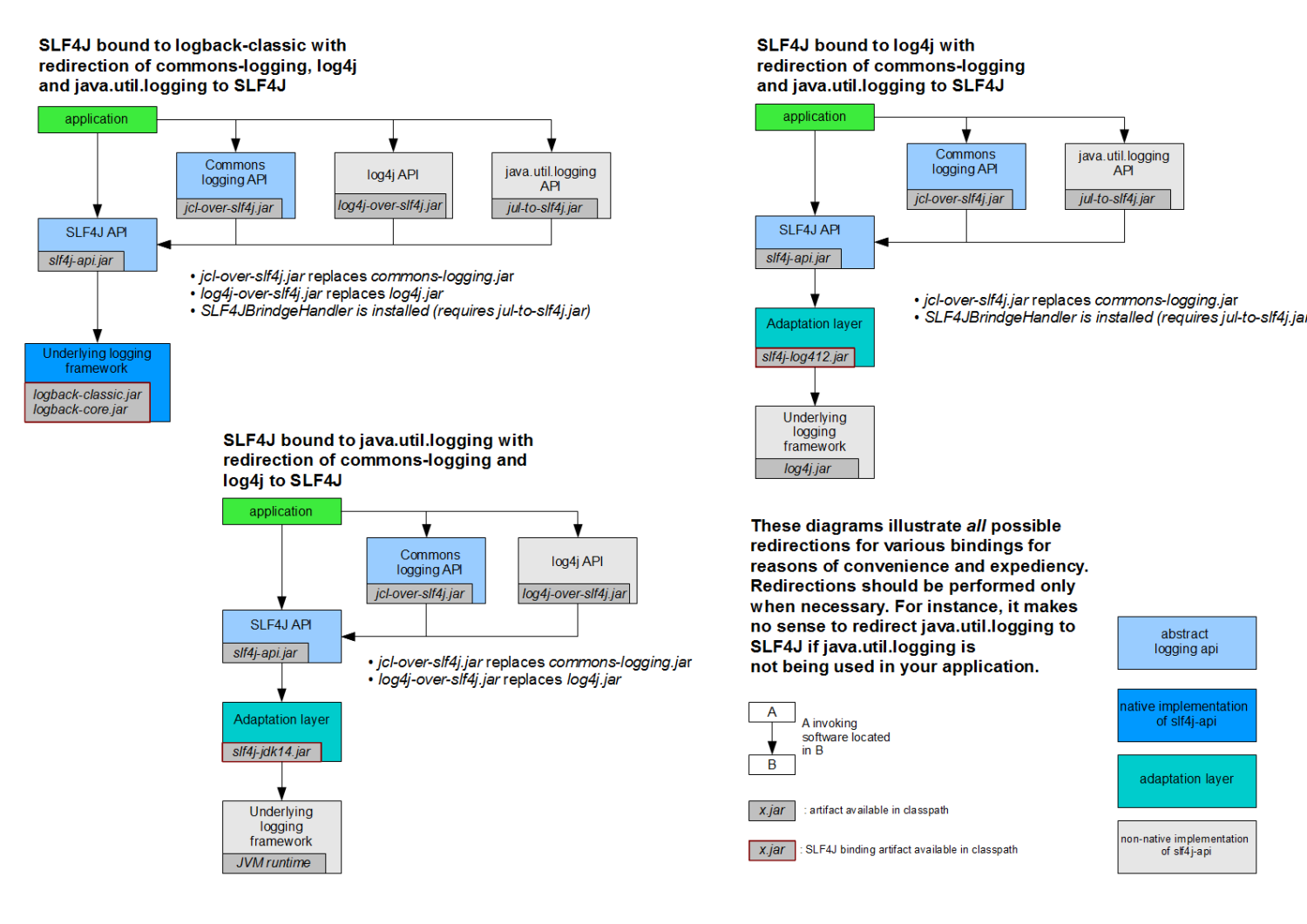
如何让系统中所有的日志都统一到 slf4j?
- 将系统中其他日志框架先排除出去。
- 用中间包来替换原有的日志框架。
- 我们导入 slf4j 其他的实现。
3、SpringBoot 日志关系
SpringBoot 使用它来做日志功能。
<dependency>
<groupId>org.springframework.boot</groupId>
<artifactId>spring-boot-starter-logging</artifactId>
</dependency>
底层依赖关系:
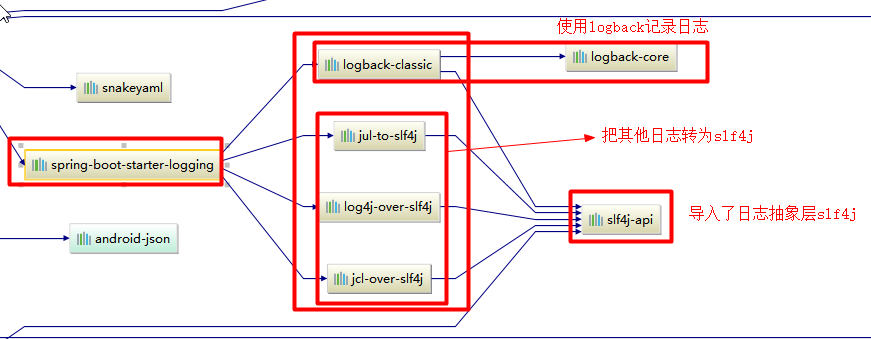
总结:
1. SpringBoot 底层也是使用 slf4j + logback 的方式进行日志记录。
2. SpringBoot 也把其他的日志都替换成了slf4j。
3. 中间转换包?
@SuppressWarnings("rawtypes")
public abstract class LogFactory {
static String UNSUPPORTED_OPERATION_IN_JCL_OVER_SLF4J = "http://www.slf4j.org/codes.html#unsupported_operation_in_jcl_over_slf4j";
static LogFactory logFactory = new SLF4JLogFactory();
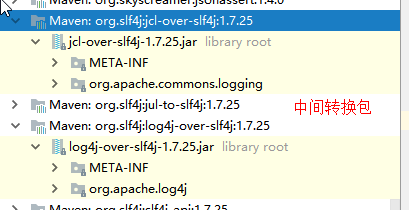
4. 如果我们要引入其他框架,一定要把这个框架的默认日志依赖移除掉。
Spring 框架用的是 commons-logging(JCL)。
<dependency>
<groupId>org.springframework</groupId>
<artifactId>spring-core</artifactId>
<exclusions>
<exclusion>
<groupId>commons-logging</groupId>
<artifactId>commons-logging</artifactId>
</exclusion>
</exclusions>
</dependency>
SpringBoot 能自动适配所有的日志,而且底层使用 slf4j + logback 的方式记录日志,引入其他框架的时候,只需要把这个框架依赖的日志框架排除掉即可。
4、日志使用
4.1 默认配置
SpringBoot 默认帮我们配置好了日志。
// 记录器
Logger logger = LoggerFactory.getLogger(getClass());
@Test
public void contextLoads() {
// System.out.println();
// 日志的级别。
// 由低到高:trace < debug < info < warn < error
// 可以调整输出的日志级别,日志就只会在这个级别以以后的高级别生效
logger.trace("这是trace日志...");
logger.debug("这是debug日志...");
// SpringBoot 默认给我们使用的是 info 级别的
logger.info("这是info日志...");
logger.warn("这是warn日志...");
logger.error("这是error日志...");
}
日志输出格式:
%d表示日期时间,
%thread表示线程名,
%-5level:级别从左显示5个字符宽度
%logger{50} 表示logger名字最长50个字符,否则按照句点分割。
%msg:日志消息,
%n是换行符
-->
%d{yyyy-MM-dd HH:mm:ss.SSS} [%thread] %-5level %logger{50} - %msg%n
SpringBoot 修改日志的默认配置:
logging.level.com.atguigu=trace
# 不指定路径,在当前项目下生成 springboot.log 日志。
#logging.file.path=
# 可以指定完整的路径。
#logging.file.name=D:/springboot.log
# 在当前磁盘的根路径下创建 /spring/log 文件夹,使用 spring.log 作为日志文件。
logging.file.path=/spring/log
# 在控制台输出的日志格式
logging.pattern.console=%d{yyyy-MM-dd} [%thread] %-5level %logger{50} - %msg%n
# 指定文件中输出的日志格式
logging.pattern.file=%d{yyyy-MM-dd} === [%thread] === %-5level === %logger{50} === %msg%n
| logging.file | logging.path | Example | Description |
|---|---|---|---|
| (none) | (none) | 只在控制台输出 | |
| 指定文件名 | (none) | my.log | 输出日志到 my.log 文件 |
| (none) | 指定目录 | /var/log | 输出到指定目录的 spring.log 文件中 |
4.2 指定配置
给类路径下放上每个日志框架自己的配置文件即可,SpringBoot 就不使用它默认配置的了。
| Logging System | Customization |
|---|---|
| Logback | logback-spring.xml, logback-spring.groovy, logback.xml or logback.groovy |
| Log4j2 | log4j2-spring.xml or log4j2.xml |
| JDK (Java Util Logging) | logging.properties |
logback.xml:直接就被日志框架识别了。
logback-spring.xml:日志框架就不直接加载日志的配置项,由 SpringBoot 解析日志配置,可以使用 SpringBoot 的高级 profile 功能。
<springProfile name="dev">
<!-- 可以指定某段配置只在某个环境下生效 -->
</springProfile>
如:
<appender name="stdout" class="ch.qos.logback.core.ConsoleAppender">
<!--
日志输出格式:
%d表示日期时间,
%thread表示线程名,
%-5level:级别从左显示5个字符宽度
%logger{50} 表示logger名字最长50个字符,否则按照句点分割。
%msg:日志消息,
%n是换行符
-->
<layout class="ch.qos.logback.classic.PatternLayout">
<springProfile name="dev">
<pattern>%d{yyyy-MM-dd HH:mm:ss.SSS} ----> [%thread] ---> %-5level %logger{50} - %msg%n</pattern>
</springProfile>
<springProfile name="!dev">
<pattern>%d{yyyy-MM-dd HH:mm:ss.SSS} ==== [%thread] ==== %-5level %logger{50} - %msg%n</pattern>
</springProfile>
</layout>
</appender>
如果使用 logback.xml 作为日志配置文件,还要使用 Profile 功能,会有以下错误
no applicable action for [springProfile]
5、切换日志框架
可以按照 slf4j 的日志适配图,进行相关的切换。
slf4j + log4j 的方式:
<dependency>
<groupId>org.springframework.boot</groupId>
<artifactId>spring-boot-starter-web</artifactId>
<exclusions>
<exclusion>
<artifactId>logback-classic</artifactId>
<groupId>ch.qos.logback</groupId>
</exclusion>
<exclusion>
<artifactId>log4j-over-slf4j</artifactId>
<groupId>org.slf4j</groupId>
</exclusion>
</exclusions>
</dependency>
<dependency>
<groupId>org.slf4j</groupId>
<artifactId>slf4j-log4j12</artifactId>
</dependency>
切换为 log4j2:
<dependency>
<groupId>org.springframework.boot</groupId>
<artifactId>spring-boot-starter-web</artifactId>
<exclusions>
<exclusion>
<artifactId>spring-boot-starter-logging</artifactId>
<groupId>org.springframework.boot</groupId>
</exclusion>
</exclusions>
</dependency>
<dependency>
<groupId>org.springframework.boot</groupId>
<artifactId>spring-boot-starter-log4j2</artifactId>
</dependency>
五、Web 开发
1、简介
-
创建 SpringBoot 应用,选中我们需要的 starter 模块。
-
SpringBoot 已经默认将这些场景配置好了,只需要在配置文件中指定少量配置就可以运行起来
-
自己编写业务代码。
2、简单功能分析
2.1 静态资源访问
静态资源:
css、jss、html、jpg等资源文件,用户多次访问都是获取同样的资源,可以被浏览器缓存。
2.1.1 静态资源访问目录
只要静态资源放在类路径下: called /static (or /public or /resources or /META-INF/resources
"classpath:/META-INF/resources/",
"classpath:/resources/",
"classpath:/static/",
"classpath:/public/"
"/":当前项目的根路径
访问当前项目根路径 / + 静态资源名 ,就可以获取到对应的静态资源。
访问地址:http://localhost:8080/hello.jpg,去静态资源目录下找 hello.jpg。
原理: 静态映射/**。
请求进来,先去找 Controller 看能不能处理。不能处理的所有请求又都交给静态资源处理器。静态资源也找不到则响应 404 页面。
2.1.2 静态资源访问前缀
默认无前缀。
spring:
mvc:
static-path-pattern: /res/**
访问当前项目根路径 / + static-path-pattern + 静态资源名 ,就可以获取到对应的静态资源。
访问地址:http://localhost:8080/res/hello.jpg,去静态资源文件夹里面找 hello.jpg。
2.1.3 webjar 映射
所有 /webjars/** 请求,都会去 classpath:/META-INF/resources/webjars/ 下找资源。
webjars:以 jar 包的方式引入静态资源。
<!-- 引入jquery-webjar -->
<dependency>
<groupId>org.webjars</groupId>
<artifactId>jquery</artifactId>
<version>3.5.0</version>
</dependency>
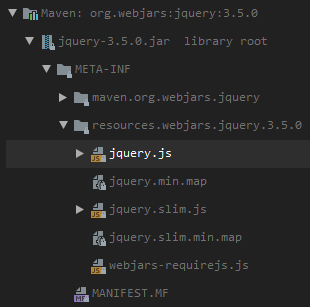
访问地址:http://localhost:8080/webjars/jquery/3.5.0/jquery.js,后面地址要按照依赖里面的包路径,就可以获取到对应的静态资源。
2.1.3 修改静态资源路径
改变默认的静态资源前缀和目录:
spring:
mvc:
static-path-pattern: /res/** # 修改前缀
resources:
static-locations: [classpath:/haha/] # 修改目录
访问地址:http://localhost:8080/res/haha/hello.jpg,去静态资源目录下找 hello.jpg。
2.2 欢迎页
静态资源路径下的所有 index.html 页面,被 /** 映射。
- 可以配置静态资源访问目录;
- 但是不能配置静态资源访问前缀,否则导致 index.html 不能被默认访问;
spring:
# mvc:
# static-path-pattern: /res/** # 这个会导致 Welcome Page 功能失效
访问地址:http://localhost:8080/,就会去静态资源目录下找 index.html 页面。
Controller 能处理 /index 请求。
2.3 自定义 Favicon
将 favicon.ico 放在静态资源目录下即可。
跟「欢迎页」一样,不能配置静态资源访问前缀,否则不能访问自定义图标。
2.4 静态资源配置原理
- SpringBoot 启动默认加载
xxxAutoConfiguration类(自动配置类)。 - SpringMVC 功能的自动配置类
WebMvcAutoConfiguration生效。
@Configuration(proxyBeanMethods = false)
@ConditionalOnWebApplication(type = Type.SERVLET)
@ConditionalOnClass({Servlet.class, DispatcherServlet.class, WebMvcConfigurer.class})
@ConditionalOnMissingBean({WebMvcConfigurationSupport.class})
@AutoConfigureOrder(-2147483638)
@AutoConfigureAfter({DispatcherServletAutoConfiguration.class, TaskExecutionAutoConfiguration.class, ValidationAutoConfiguration.class})
public class WebMvcAutoConfiguration {
-
查看
WebMvcConfigurer接口的实现类WebMvcAutoConfigurationAdapter,看看给容器中配置了什么@Configuration(proxyBeanMethods = false) @Import({WebMvcAutoConfiguration.EnableWebMvcConfiguration.class}) @EnableConfigurationProperties({WebMvcProperties.class, ResourceProperties.class, WebProperties.class}) @Order(0) public static class WebMvcAutoConfigurationAdapter implements WebMvcConfigurer, ServletContextAware { -
配置类和配置文件的相关属性
spring.xxx进行了绑定。-
WebMvcProperties绑定spring.mvc -
ResourceProperties(已过时) 绑定spring.resources@Deprecated @ConfigurationProperties(prefix = "spring.resources", ignoreUnknownFields = false) public class ResourceProperties extends Resources { -
WebProperties绑定spring.web@ConfigurationProperties("spring.web") public class WebProperties { public static class Resources { private static final String[] CLASSPATH_RESOURCE_LOCATIONS = { "classpath:/META-INF/resources/", "classpath:/resources/", "classpath:/static/", "classpath:/public/" }; /** * Locations of static resources. Defaults to classpath:[/META-INF/resources/, * /resources/, /static/, /public/]. */ private String[] staticLocations = CLASSPATH_RESOURCE_LOCATIONS;
-
2.4.1 配置唯一的有参类构造函数
org.springframework.boot.autoconfigure.web.servlet.WebMvcAutoConfiguration.WebMvcAutoConfigurationAdapter#WebMvcAutoConfigurationAdapter()
// 有参构造器所有参数的值都会从容器中获取
// ResourceProperties:获取和 spring.resources 绑定的所有的值的对象
// WebMvcProperties:获取和 spring.mvc 绑定的所有的值的对象
// ListableBeanFactory:Spring 的 beanFactory
// HttpMessageConverters:找到所有的 HttpMessageConverters
// ResourceHandlerRegistrationCustomizer:找到资源处理器的自定义器。
// DispatcherServletPath:配置访问路径
// ServletRegistrationBean:给应用注册 Listener -> Fliter -> Servlet
public WebMvcAutoConfigurationAdapter (ResourceProperties resourceProperties, WebMvcProperties mvcProperties,
ListableBeanFactory beanFactory, ObjectProvider<HttpMessageConverters> messageConvertersProvider,
ObjectProvider<ResourceHandlerRegistrationCustomizer> resourceHandlerRegistrationCustomizerProvider,
ObjectProvider<DispatcherServletPath> dispatcherServletPath,
ObjectProvider<ServletRegistrationBean<?>> servletRegistrations) {
this.resourceProperties = resourceProperties;
this.mvcProperties = mvcProperties;
this.beanFactory = beanFactory;
this.messageConvertersProvider = messageConvertersProvider;
this.resourceHandlerRegistrationCustomizer = resourceHandlerRegistrationCustomizerProvider.getIfAvailable ();
this.dispatcherServletPath = dispatcherServletPath;
this.servletRegistrations = servletRegistrations;
}
2.4.2 静态资源和 webjars 的处理规则
org.springframework.boot.autoconfigure.web.servlet.WebMvcAutoConfiguration.WebMvcAutoConfigurationAdapter#addResourceHandlers()
@Override
public void addResourceHandlers (ResourceHandlerRegistry registry) {
if (!this.resourceProperties.isAddMappings ()) {
logger.debug ("Default resource handling disabled");
return;
}
Duration cachePeriod = this.resourceProperties.getCache ().getPeriod ();
CacheControl cacheControl = this.resourceProperties.getCache ().getCachecontrol ().toHttpCacheControl ();
// webjars 的处理规则
if (!registry.hasMappingForPattern ("/webjars/**")) {
customizeResourceHandlerRegistration (registry.addResourceHandler ("/webjars/**")
.addResourceLocations ("classpath:/META-INF/resources/webjars/")
.setCachePeriod (getSeconds (cachePeriod)).setCacheControl (cacheControl));
}
// 静态资源的处理规则
String staticPathPattern = this.mvcProperties.getStaticPathPattern ();
if (!registry.hasMappingForPattern (staticPathPattern)) {
customizeResourceHandlerRegistration (registry.addResourceHandler (staticPathPattern)
.addResourceLocations (getResourceLocations (this.resourceProperties.getStaticLocations ()))
.setCachePeriod (getSeconds (cachePeriod)).setCacheControl (cacheControl));
}
}
2.4.3 欢迎页的处理规则
org.springframework.boot.autoconfigure.web.servlet.WebMvcAutoConfiguration.EnableWebMvcConfiguration#welcomePageHandlerMapping()
// 配置欢迎页映射
@Bean
public WelcomePageHandlerMapping welcomePageHandlerMapping(ApplicationContext applicationContext,
FormattingConversionService mvcConversionService, ResourceUrlProvider mvcResourceUrlProvider) {
WelcomePageHandlerMapping welcomePageHandlerMapping = new WelcomePageHandlerMapping(
new TemplateAvailabilityProviders(applicationContext), applicationContext, getWelcomePage(),
this.mvcProperties.getStaticPathPattern());
welcomePageHandlerMapping.setInterceptors(getInterceptors(mvcConversionService, mvcResourceUrlProvider));
welcomePageHandlerMapping.setCorsConfigurations(getCorsConfigurations());
return welcomePageHandlerMapping;
}
// WelcomePageHandlerMapping 类的唯一有参构造函数
WelcomePageHandlerMapping(TemplateAvailabilityProviders templateAvailabilityProviders,
ApplicationContext applicationContext, Resource welcomePage, String staticPathPattern) {
if (welcomePage != null && "/**".equals(staticPathPattern)) {
// 要用欢迎页,必须使用默认的静态资源目录 /**
logger.info("Adding welcome page: " + welcomePage);
setRootViewName("forward:index.html");
}
else if (welcomeTemplateExists(templateAvailabilityProviders, applicationContext)) {
// 调用 Controller 处理 /index 请求
logger.info("Adding welcome page template: index");
setRootViewName("index");
}
}
2.4.4 Favicon 的处理规则
// 配置喜欢的图标
@Configuration
@ConditionalOnProperty(value = "spring.mvc.favicon.enabled", matchIfMissing = true)
public static class FaviconConfiguration {
private final ResourceProperties resourceProperties;
public FaviconConfiguration(ResourceProperties resourceProperties) {
this.resourceProperties = resourceProperties;
}
@Bean
public SimpleUrlHandlerMapping faviconHandlerMapping() {
SimpleUrlHandlerMapping mapping = new SimpleUrlHandlerMapping();
mapping.setOrder(Ordered.HIGHEST_PRECEDENCE + 1);
// 映射所有 **/favicon.ico
mapping.setUrlMap(Collections.singletonMap("**/favicon.ico",
faviconRequestHandler()));
return mapping;
}
@Bean
public ResourceHttpRequestHandler faviconRequestHandler() {
ResourceHttpRequestHandler requestHandler = new ResourceHttpRequestHandler();
requestHandler
.setLocations(this.resourceProperties.getFaviconLocations());
return requestHandler;
}
}
新版本没有这个类了,找到了下面这个类:
public enum StaticResourceLocation {
CSS("/css/**"),
JAVA_SCRIPT("/js/**"),
IMAGES("/images/**"),
WEB_JARS("/webjars/**"),
FAVICON("/favicon.*", "/*/icon-*");
private final String[] patterns;
StaticResourceLocation(String... patterns) {
this.patterns = patterns;
}
public Stream<String> getPatterns() {
return Arrays.stream(this.patterns);
}
}
3、请求响应参数处理
3.1 请求映射
3.1.1 REST 使用
-
@xxxMapping(@GetMapping、@PostMapping、@PutMapping、@DeleteMapping,@PatchMapping是对 Put 的补充,区别是 Patch 是部分更新,Put 是全部更新,这些注解都是 Spring4.3 引入的); -
REST 风格支持(使用 HTTP 请求方式动词来表示对资源的操作)
| 操作 | 以前 | 现在(REST 风格) |
|---|---|---|
| 获取用户 | /getUser 的 GET 请求 | /user/id 的 GET 请求 |
| 保存用户 | /saveUser 的 POST 请求 | /user/id 的 POST 请求 |
| 修改用户 | /editUser 的 POST 请求 | /user/id 的 PUT 请求 |
| 删除用户 | /deleteUser 的 POST 请求 | /user/id 的 DELETE 请求 |
- 核心过滤器:浏览器 form 表单只支持 GET 与 POST 请求,而 DELETE、PUT 等 method 并不支持,Spring 3.0 添加了一个过滤器
HiddenHttpMethodFilter,可以将这些请求转换为标准的 HTTP 方法,使得支持 GET、POST、PUT 与 DELETE 请求。
用法: SpringBoot 中手动开启 REST 支持,表单 method=post,隐藏域 _method=put。
扩展:如何把 _method 这个名字换成我们自己喜欢的。
@RequestMapping(value = "/user",method = RequestMethod.GET)
public String getUser(){
return "GET-张三";
}
@RequestMapping(value = "/user",method = RequestMethod.POST)
public String saveUser(){
return "POST-张三";
}
@RequestMapping(value = "/user",method = RequestMethod.PUT)
public String putUser(){
return "PUT-张三";
}
@RequestMapping(value = "/user",method = RequestMethod.DELETE)
public String deleteUser(){
return "DELETE-张三";
}
@Bean
@ConditionalOnMissingBean(HiddenHttpMethodFilter.class)
@ConditionalOnProperty(prefix = "spring.mvc.hiddenmethod.filter", name = "enabled", matchIfMissing = false)
public OrderedHiddenHttpMethodFilter hiddenHttpMethodFilter() {
return new OrderedHiddenHttpMethodFilter();
}
// 自定义 HiddenHttpMethodFilter,将隐藏域方法名换成自己喜欢的 _m
@Bean
public HiddenHttpMethodFilter hiddenHttpMethodFilter(){
HiddenHttpMethodFilter methodFilter = new HiddenHttpMethodFilter();
methodFilter.setMethodParam("_m");
return methodFilter;
}
3.1.2 REST 原理
原理(表单提交要使用 REST 的时候)
-
表单提交会带上
_method=使用的方法。 -
请求过来被
HiddenHttpMethodFilter拦截。-
请求是否正常,并且是 POST。
-
获取到
_method的值,统一转换成大写。 -
兼容以下请求:PUT、DELETE、PATCH。
-
原生
request(post),包装模式requesWrapper重写了getMethod方法,返回的是传入的值。 -
过滤器链放行的时候用
wrapper,以后的方法调用getMethod是调用requesWrapper的。
-
-
使用客户端工具发送 REST 请求
- 如 PostMan 直接发送 Put、Delete 等方式请求,无需 Filter。
spring:
mvc:
hiddenmethod:
filter:
enabled: true #开启页面表单的 REST 功能
3.1.3 请求映射原理

SpringMVC 功能分析都从 org.springframework.web.servlet.DispatcherServlet.doDispatch() 方法开始。
protected void doDispatch(HttpServletRequest request, HttpServletResponse response) throws Exception {
HttpServletRequest processedRequest = request;
HandlerExecutionChain mappedHandler = null;
boolean multipartRequestParsed = false;
WebAsyncManager asyncManager = WebAsyncUtils.getAsyncManager(request);
try {
try {
ModelAndView mv = null;
Object dispatchException = null;
try {
processedRequest = this.checkMultipart(request);
multipartRequestParsed = processedRequest != request;
// 找到当前请求使用哪个 Handler(Controller 的方法)处理
mappedHandler = this.getHandler(processedRequest);
@Nullable
protected HandlerExecutionChain getHandler(HttpServletRequest request) throws Exception {
if (this.handlerMappings != null) {
Iterator var2 = this.handlerMappings.iterator();
while(var2.hasNext()) {
HandlerMapping mapping = (HandlerMapping)var2.next();
HandlerExecutionChain handler = mapping.getHandler(request);
if (handler != null) {
return handler;
}
}
}
return null;
}
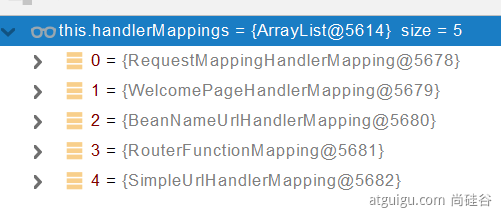
RequestMappingHandlerMapping:保存了所有 @RequestMapping(请求路径) 和 Handlerg(Controller 的方法) 的映射规则。
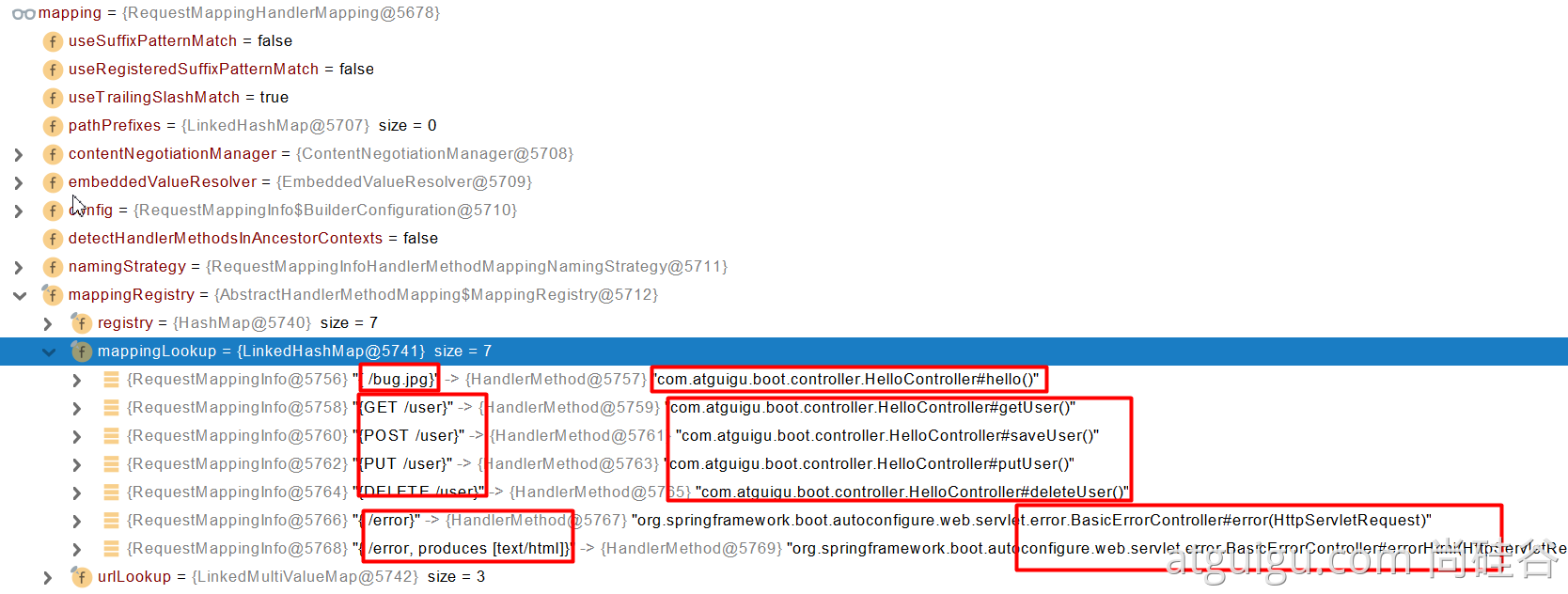
所有的请求映射都在 HandlerMapping 中。
-
SpringBoot 自动配置欢迎页的
WelcomePageHandlerMapping,访问/能访问到index.html; -
SpringBoot 自动配置了默认的
RequestMappingHandlerMapping: -
请求进来,挨个尝试所有的
HandlerMapping看是否有请求信息; -
如果有,就找到这个请求对应的
Handler; -
如果没有,就遍历下一个
HandlerMapping;
如果我们需要一些自定义的映射处理,可以通过给容器中放 HandlerMapping 来自定义 HandlerMapping

有的时候,比如说同一组 API 有不同的版本如 v1,v2,我们可以在 Controller 中写两组mapping(比如 v1/user,v2/user)。但同时我们也可以放在两个包下,都是 /user,这个时候我们就可以自定义 HandlerMapping,把 v1/user 映射到一个包下的 /user,把 v2/user映射到另外一个包下的 /user。
3.2 普通参数与基本注解
3.2.1 注解
@PathVariable:请求路径中的值@RequestParam:请求参数中的值@RequestHeader:请求 Header 中的值@RequestBody:请求 Body 中的值@ModelAttribute:绑定请求参数到实体对象@CookieValue:获取浏览器中的 Cookie 值@MatrixVariable:以分号分隔的矩阵变量键值对,形如 ;name1=value1;name2=value2,value3
@RestControllerpublic class ParameterTestController { // 请求路径:car/2/owner/zhangsan @GetMapping("/car/{id}/owner/{username}") public Map<String,Object> getCar(@PathVariable("id") Integer id, @PathVariable("username") String name, @PathVariable Map<String,String> pv, @RequestHeader("User-Agent") String userAgent, @RequestHeader Map<String,String> header, @RequestParam("age") Integer age, @RequestParam("inters") List<String> inters, @RequestParam Map<String,String> params, @CookieValue("_ga") String _ga, @CookieValue("_ga") Cookie cookie){ Map<String,Object> map = new HashMap<>();// map.put("id",id);// map.put("name",name);// map.put("pv",pv);// map.put("userAgent",userAgent);// map.put("headers",header); map.put("age",age); map.put("inters",inters); map.put("params",params); map.put("_ga",_ga); System.out.println(cookie.getName()+"===>"+cookie.getValue()); return map; } @PostMapping("/save") public Map postMethod(@RequestBody String content){ Map<String,Object> map = new HashMap<>(); map.put("content",content); return map; } //1、请求路径:/cars/sell;low=34;brand=byd,audi,yd //2、SpringBoot 默认禁用了矩阵变量的功能 // 手动开启的原理:URL 路径使用 UrlPathHelper 进行解析。 // 实现 WebMvcConfigurer 接口,重写 configurePathMatch() // 将 removeSemicolonContent 设置为 false 即可开启。 //3、矩阵变量必须有 URL 路径变量才能被解析 @GetMapping("/cars/{path}") public Map carsSell(@MatrixVariable("low") Integer low, @MatrixVariable("brand") List<String> brand, @PathVariable("path") String path){ Map<String,Object> map = new HashMap<>(); map.put("low",low); map.put("brand",brand); map.put("path",path); return map; } // 请求路径:/boss/1;age=20/2;age=10 @GetMapping("/boss/{bossId}/{empId}") public Map boss(@MatrixVariable(value = "age",pathVar = "bossId") Integer bossAge, @MatrixVariable(value = "age",pathVar = "empId") Integer empAge){ Map<String,Object> map = new HashMap<>(); map.put("bossAge",bossAge); map.put("empAge",empAge); return map; }}
3.2.2 Servlet API
WebRequest、ServletRequest、MultipartRequest、 HttpSession、PushBuilder、Principal、InputStream、Reader、HttpMethod、Locale、TimeZone、ZoneId
以上参数都是在 ServletRequestMethodArgumentResolver.supportsParameter() 里判断的:
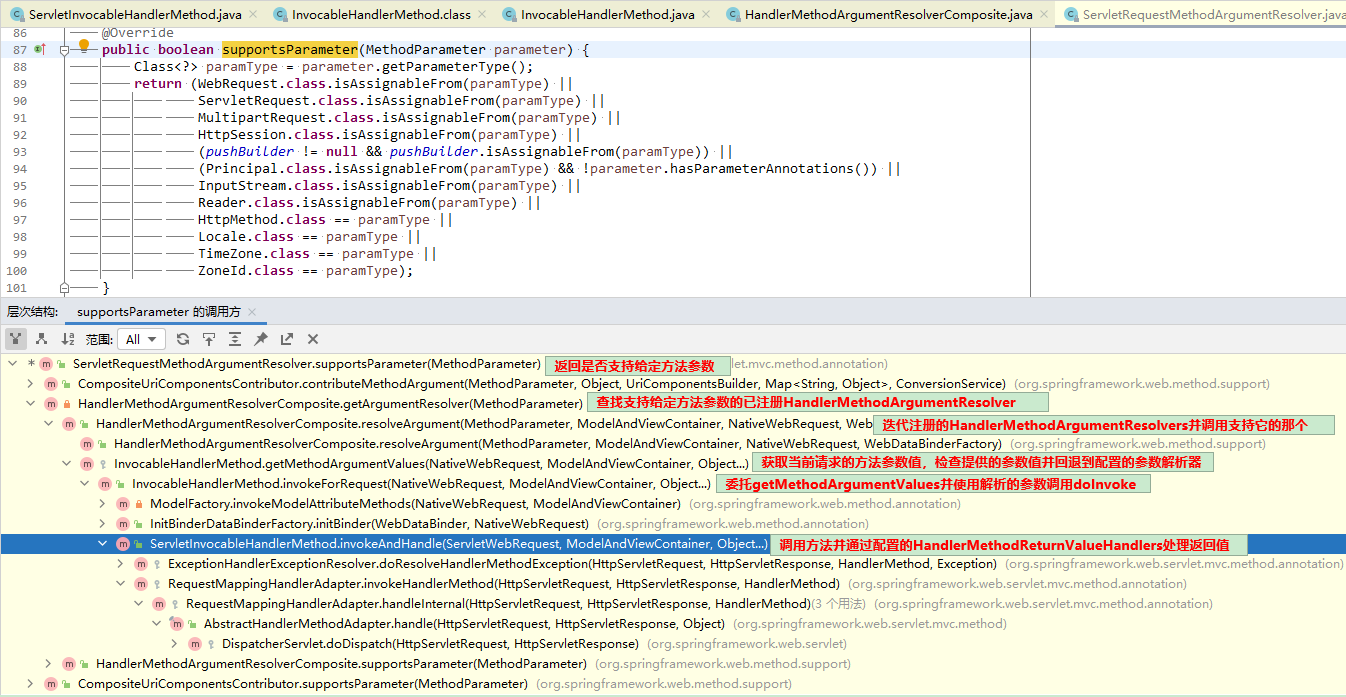
然后获取请求:
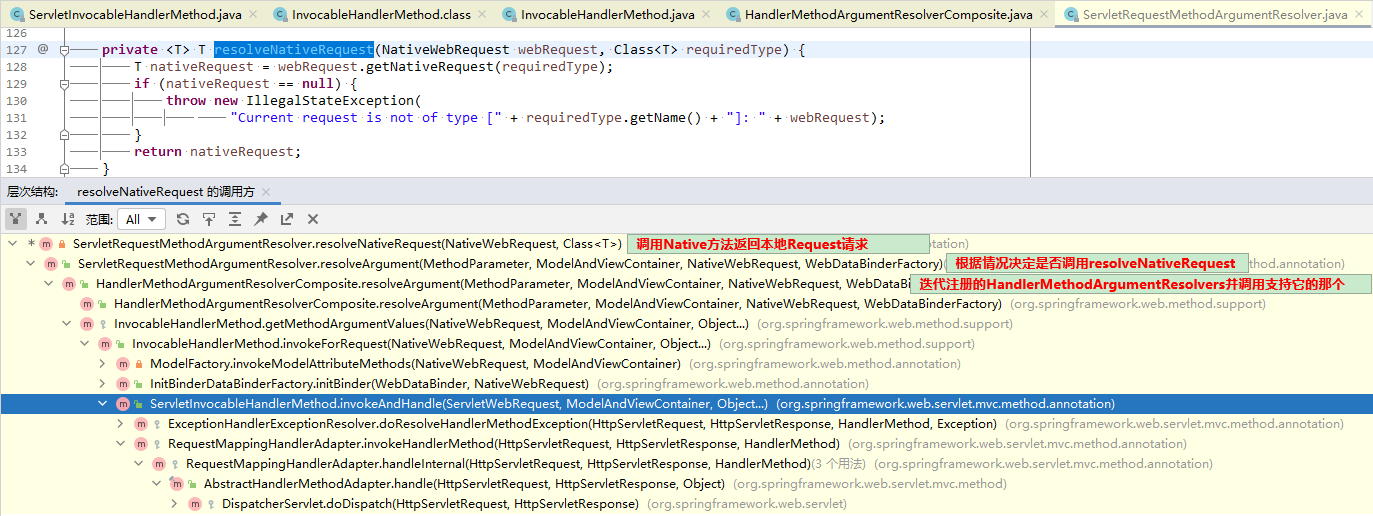
3.2.3 复杂参数
Map、Model、Errors/BindingResult、RedirectAttributes( 重定向携带数据)、ServletResponse(response)、SessionStatus、UriComponentsBuilder、ServletUriComponentsBuilder
Map<String, Object> map、Model model、HttpServletRequest request 都可以给 request 域中放数据 request.setAttribute()。
Map、Model类型的参数,会返回 mavContainer.getModel()
// ModelAndViewContainer:模型和视图的容器private final ModelMap defaultModel = new BindingAwareModelMap();public ModelMap getModel() { if (this.useDefaultModel()) { return this.defaultModel; // 默认返回 BindingAwareModelMap,既是 Model 又是 Map } else { if (this.redirectModel == null) { this.redirectModel = new ModelMap(); // 重定向为空,返回一个空的 LinkedHashMap } return this.redirectModel; // 返回 RedirectAttributesModelMap }}

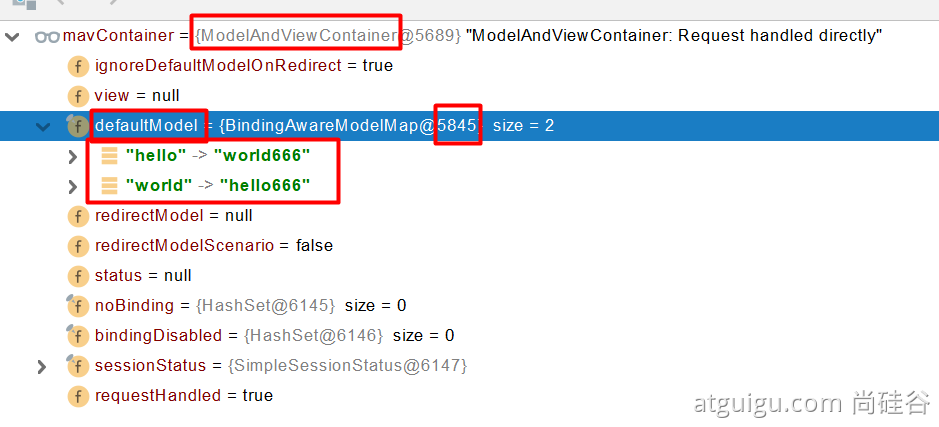
3.2.4 自定义对象参数
可以自动类型转换与格式化,还可以级联封装。
/**
* html 中引用对象参数
* 姓名: <input name="userName"/> <br/>
* 年龄: <input name="age"/> <br/>
* 生日: <input name="birth"/> <br/>
* 宠物姓名:<input name="pet.name"/><br/>
* 宠物年龄:<input name="pet.age"/>
*/
@Data
public class Person {
private String userName;
private Integer age;
private Date birth;
private Pet pet;
}
@Data
public class Pet {
private String name;
private String age;
}
3.3 自定义类型参数:POJO 封装
RequestParamMethodArgumentResolver 支持简单类型的请求方法参数,ServletModelAttributeMethodProcessor 支持非简单类型的请求方法参数。
所以对于请求 http://localhost:8080/testCustomObj?name=张三&age=18,由于请求方法参数Employee 不是简单类型,所以会调用 ServletModelAttributeMethodProcessor 将请求参数封装为 Employee 对象并返回。
@RequestMapping("/testCustomObj")
@ResponseBody
public Employee testCustomObj(Employee e) {
return e;
}
3.4 参数处理原理
HandlerMapping中找到能处理请求的Handler(Controller中请求对应的方法);- 为当前
Handler找一个适配器HandlerAdapter,对于请求来说就是RequestMappingHandlerAdapter; - 适配器执行目标方法并确定方法参数的每一个值。
拓展:
SpringMVC 处理请求大致是这样的:
- 首先被
DispatcherServlet截获,DispatcherServlet通过handlerMapping获得HandlerExecutionChain,然后获得HandlerAdapter。 HandlerAdapter在内部对于每个请求,都会实例化一个ServletInvocableHandlerMethod进行处理,ServletInvocableHandlerMethod在进行处理的时候,会分两部分别对请求跟响应进行处理。- 处理请求的时候,会根据
ServletInvocableHandlerMethod的属性argumentResolvers(这个属性是它的父类InvocableHandlerMethod中定义的)进行处理,其中argumentResolvers属性是一个HandlerMethodArgumentResolverComposite类 (这里使用了组合模式的一种变形),这个类是实现了HandlerMethodArgumentResolver接口的类,里面有各种实现了HandlerMethodArgumentResolver的 List 集合。 - 处理响应的时候,会根据
ServletInvocableHandlerMethod的属性returnValueHandlers(自身属性) 进行处理,returnValueHandlers属性是一个HandlerMethodReturnValueHandlerComposite类(这里使用了组合模式的一种变形),这个类是实现了HandlerMethodReturnValueHandler接口的类,里面有各种实现了HandlerMethodReturnValueHandler的 List 集合。
- 处理请求的时候,会根据
- 之后
HandlerAdapter得到ModelAndView,然后做相应的处理。
以 Resolver 结尾的类是实现了 HandlerMethodArgumentResolver 接口的类,以 Processor 结尾的类是实现了 HandlerMethodArgumentResolver 和 HandlerMethodReturnValueHandler 的类。
HandlerMethodArgumentResolver:处理请求方法的参数HandlerMethodReturnValueHandler:处理请求方法的返回值

3.4.1 处理器的适配器HandlerAdapter
// DispatcherServlet#getHandlerAdapterprotected HandlerAdapter getHandlerAdapter(Object handler) throws ServletException { if (this.handlerAdapters != null) { for (HandlerAdapter adapter : this.handlerAdapters) { if (adapter.supports(handler)) { return adapter; } } } throw new ServletException("No adapter for handler [" + handler + "]: The DispatcherServlet configuration needs to include a HandlerAdapter that supports this handler");}
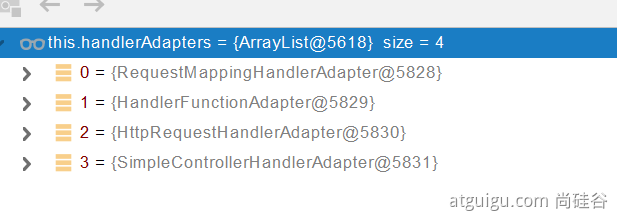
RequestMappingHandlerAdapter:支持方法上标注@RequestMapping的适配器。HandlerFunctionAdapter:支持函数式编程的适配器。HttpRequestHandlerAdapter:无返回值,用于处理静态资源。SimpleControllerHandlerAdapter:是Controller实现类的适配器类,其本质是执行Controller中的handleRequest方法。
3.4.2 执行目标方法
// DispatcherServlet#doDispatch// Actually invoke the handler.mv = ha.handle(processedRequest, response, mappedHandler.getHandler());// RequestMappingHandlerAdapter#handleInternalmav = invokeHandlerMethod(request, response, handlerMethod); //执行目标方法// RequestMappingHandlerAdapter#invokeHandlerMethodinvocableMethod.invokeAndHandle(webRequest, mavContainer);// ServletInvocableHandlerMethod#invokeAndHandleObject returnValue = invokeForRequest(webRequest, mavContainer, providedArgs);// InvocableHandlerMethod#invokeForRequestObject[] args = getMethodArgumentValues(request, mavContainer, providedArgs);return this.doInvoke(args); // 通过反射调用目标方法
3.4.3 参数解析器 HandlerMethodArgumentResolver
确定将要执行的目标方法的每一个参数的值是什么。
SpringMVC 目标方法能写多少种参数类型,取决于参数解析器。
// InvocableHandlerMethod#invokeForRequestObject[] args = getMethodArgumentValues(request, mavContainer, providedArgs);// InvocableHandlerMethod#getMethodArgumentValuesif (!this.resolvers.supportsParameter(parameter)) { // 判断是否支持当前参数类型// 解析支持的参数,并放入参数列表args[i] = this.resolvers.resolveArgument(parameter, mavContainer, request, this.dataBinderFactory);// HandlerMethodArgumentResolverComposite#resolveArgumentHandlerMethodArgumentResolver resolver = this.getArgumentResolver(parameter);// HandlerMethodArgumentResolverComposite#getArgumentResolver// 先从参数解析器缓存中获取,若获取不到再从参数解析器中获取Iterator var3 = this.argumentResolvers.iterator();// 判断解析器是否支持当前参数类型,若支持放入参数解析器缓存中,然后返回参数解析器
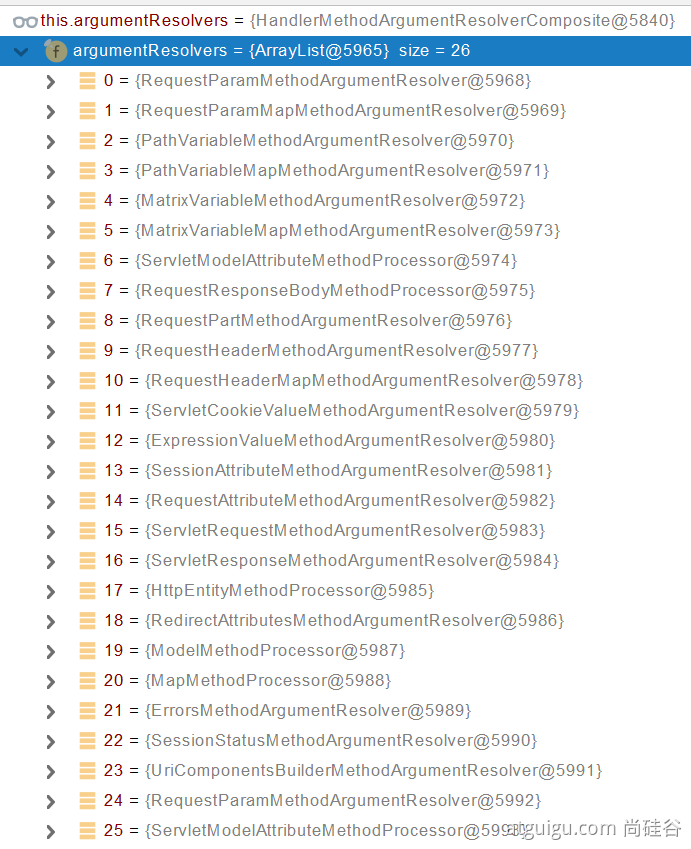
3.4.4 返回值处理
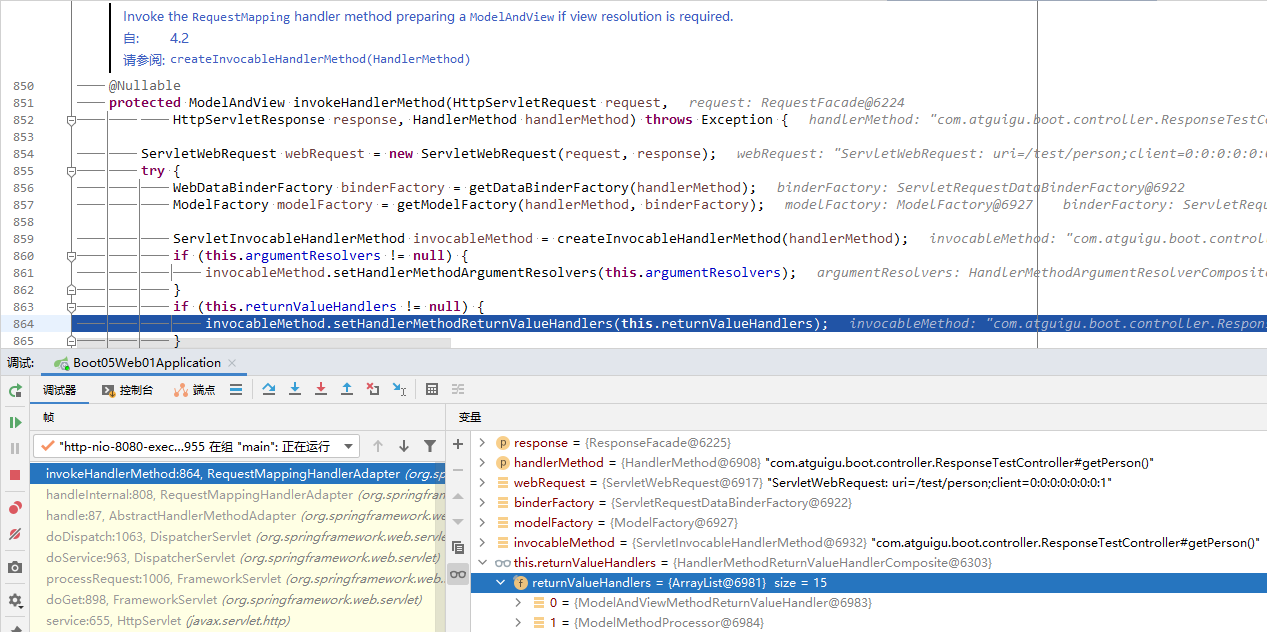
3.4.5 自定义类型参数:POJO 封装
ServletModelAttributeMethodProcessor 负责处理自定义的参数类型(非简单类型)。
简单类型如下:
// BeanUtils#isSimpleValueTypepublic static boolean isSimpleValueType(Class<?> type) { return (Void.class != type && void.class != type && (ClassUtils.isPrimitiveOrWrapper(type) || Enum.class.isAssignableFrom(type) || CharSequence.class.isAssignableFrom(type) || Number.class.isAssignableFrom(type) || Date.class.isAssignableFrom(type) || Temporal.class.isAssignableFrom(type) || URI.class == type || URL.class == type || Locale.class == type || Class.class == type));}
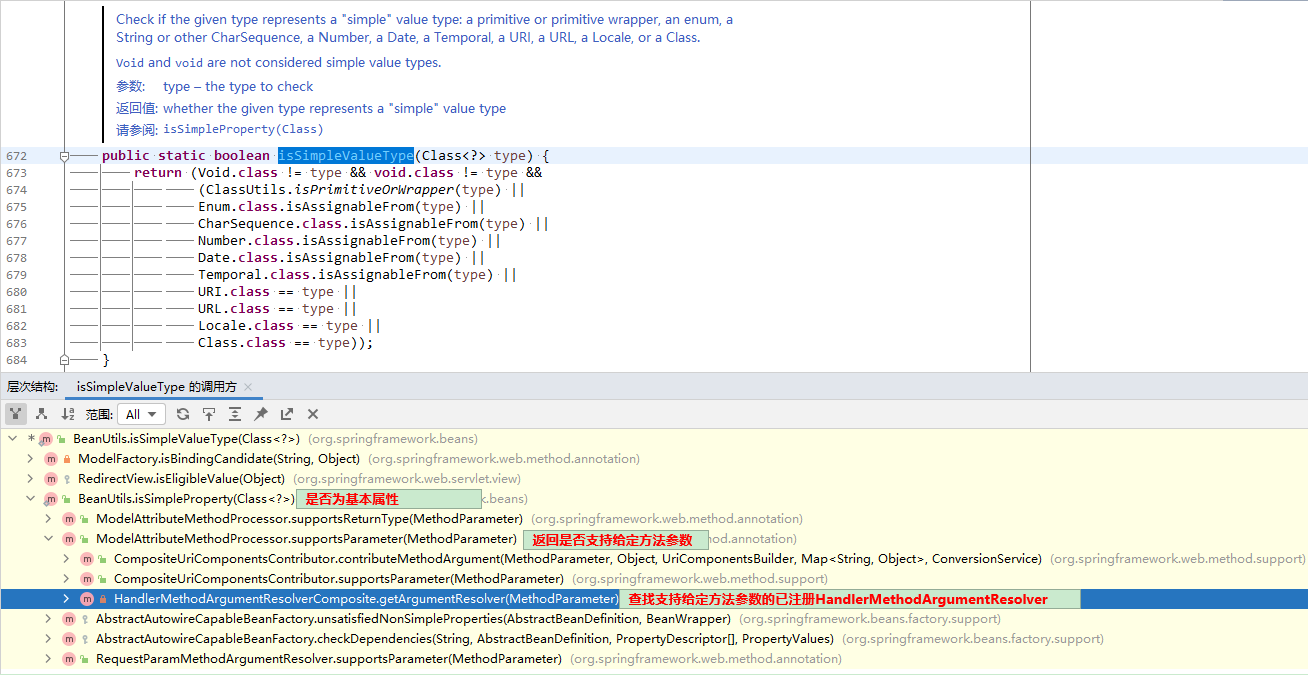
解析参数:
// ModelAttributeMethodProcessor#resolveArgumentWebDataBinder binder = binderFactory.createBinder(webRequest, attribute, name);
WebDataBinder:Web 数据绑定器,利用它里面的 Converters 将请求数据转成指定的数据类型,然后封装到指定的 POJO 对象里面。
GenericConversionService:在设置每一个值的时候,找它里面所有的 Converters,哪个可以将这个数据类型(request 带来参数的字符串)转换到指定的类型。
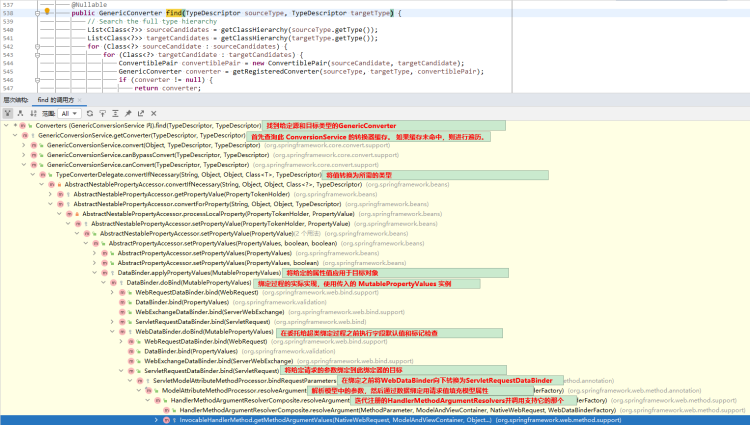
@FunctionalInterfacepublic interface Converter<S, T>
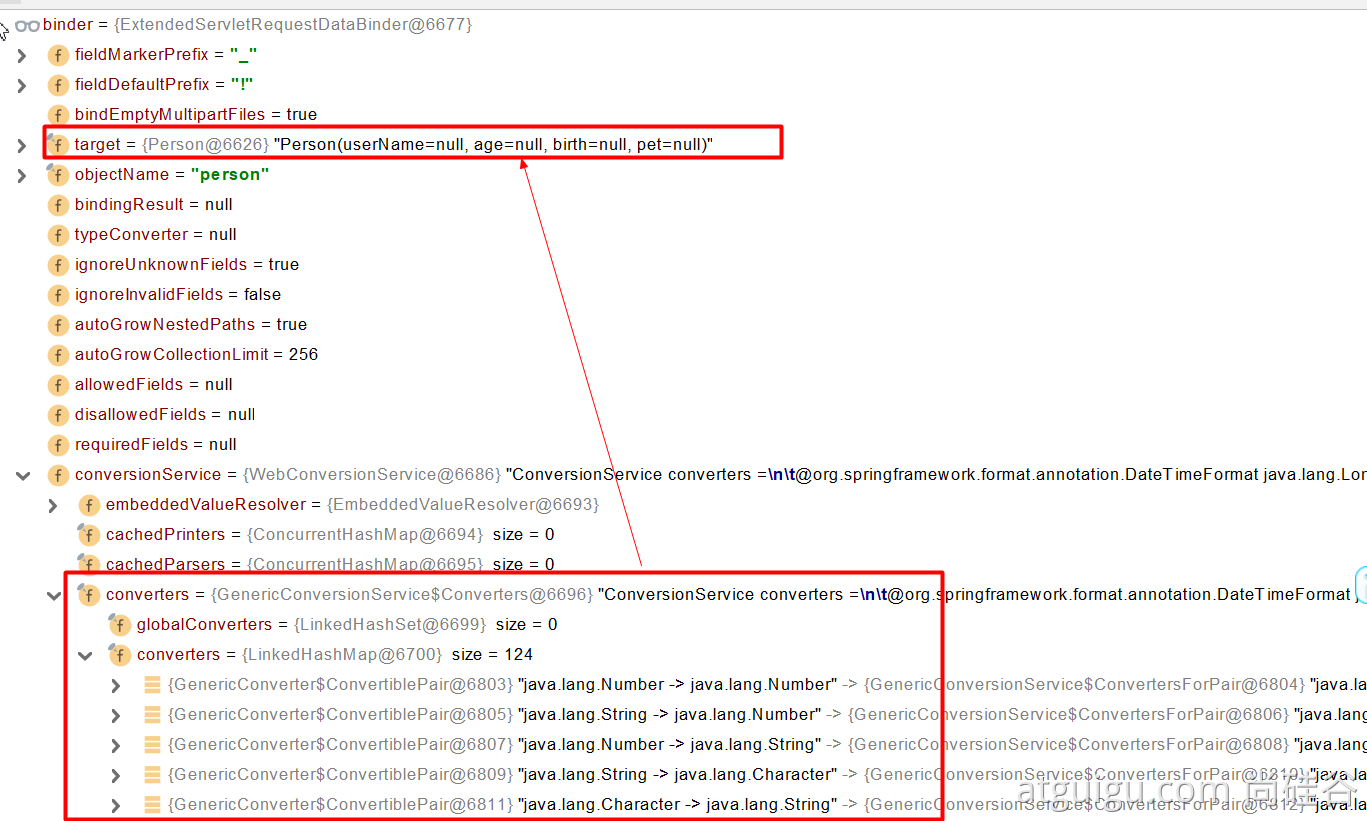
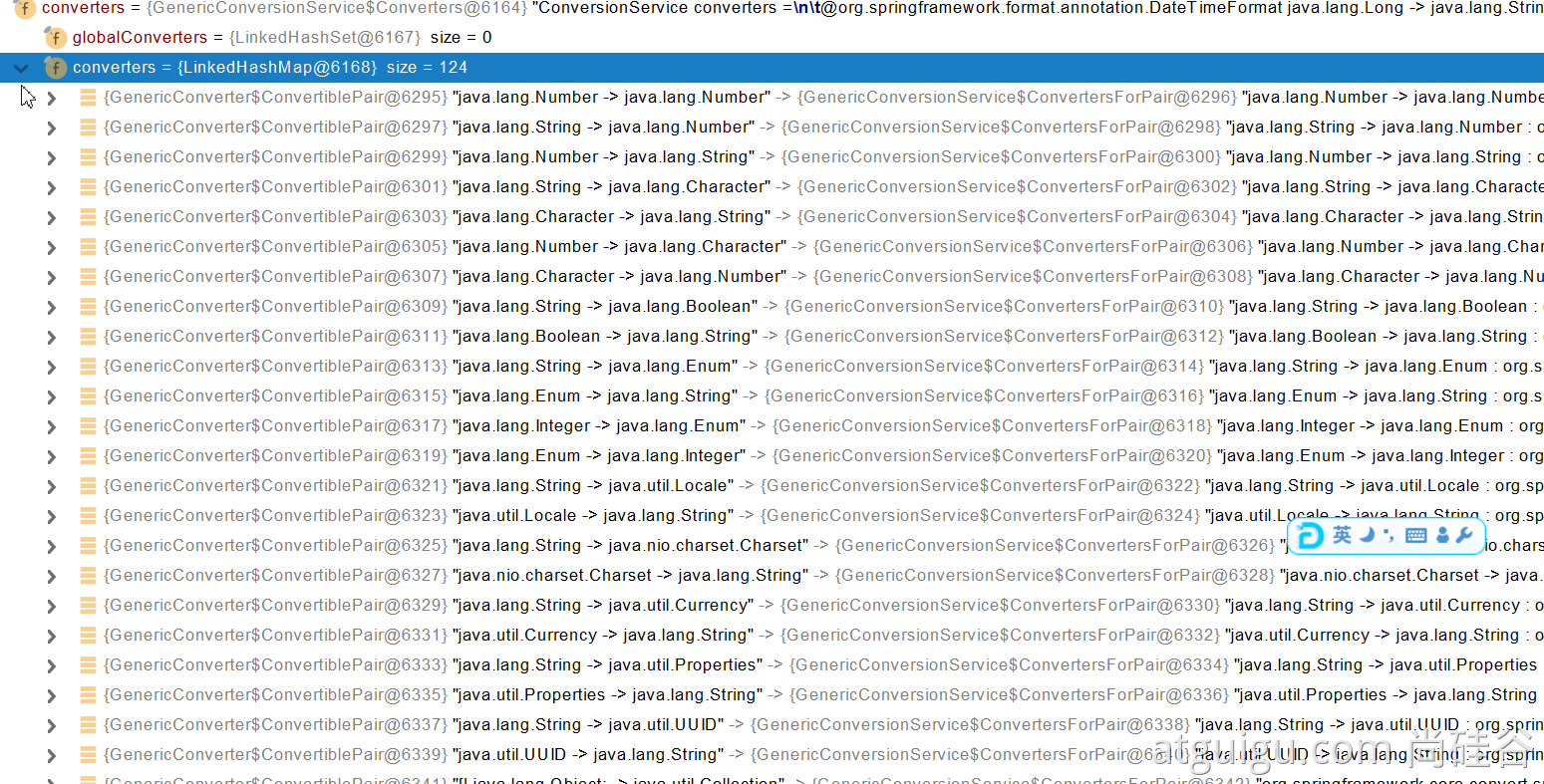
可以给WebDataBinder里面放自己的Converter;
private static final class StringToNumber<T extends Number> implements Converter<String, T>
自定义 Converter:
// 1、WebMvcConfigurer 定制化 SpringMVC 的功能@Beanpublic WebMvcConfigurer webMvcConfigurer (){ return new WebMvcConfigurer () { @Override public void configurePathMatch (PathMatchConfigurer configurer) { UrlPathHelper urlPathHelper = new UrlPathHelper (); // 不移除分号后面的内容,矩阵变量功能就可以生效 urlPathHelper.setRemoveSemicolonContent (false); configurer.setUrlPathHelper (urlPathHelper); } @Override public void addFormatters (FormatterRegistry registry) { registry.addConverter (new Converter<String, Pet>() { @Override public Pet convert (String source) { // 阿猫,3 if (!StringUtils.isEmpty (source)){ Pet pet = new Pet (); String [] split = source.split (","); pet.setName (split [0]); pet.setAge (Integer.parseInt (split [1])); return pet; } return null; } }); } };}
3.4.6 目标方法执行完成
将所有返回的数据都放在 ModelAndViewContainer,包含要去的页面地址 View,还包含 Model 数据。

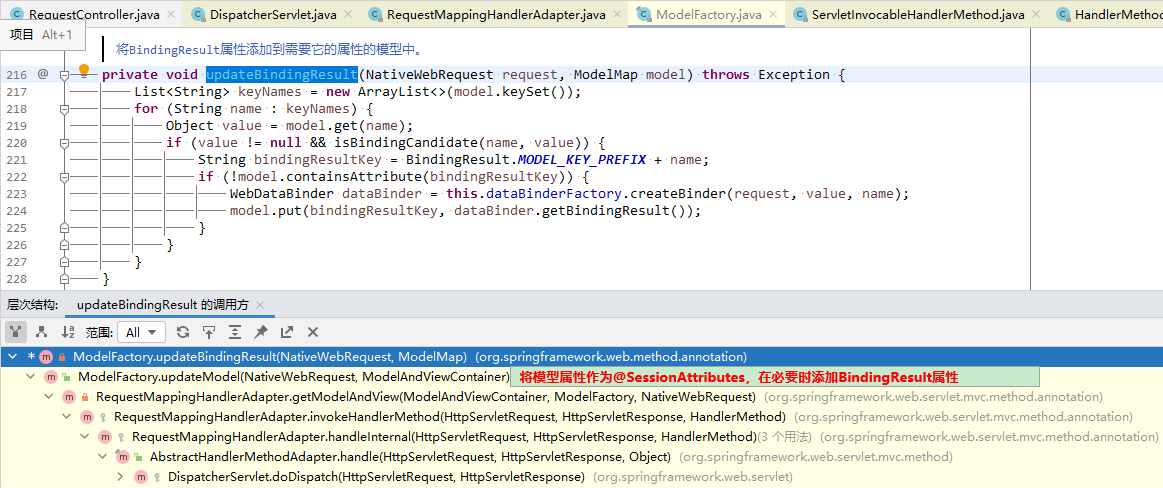
3.4.7 处理派发结果
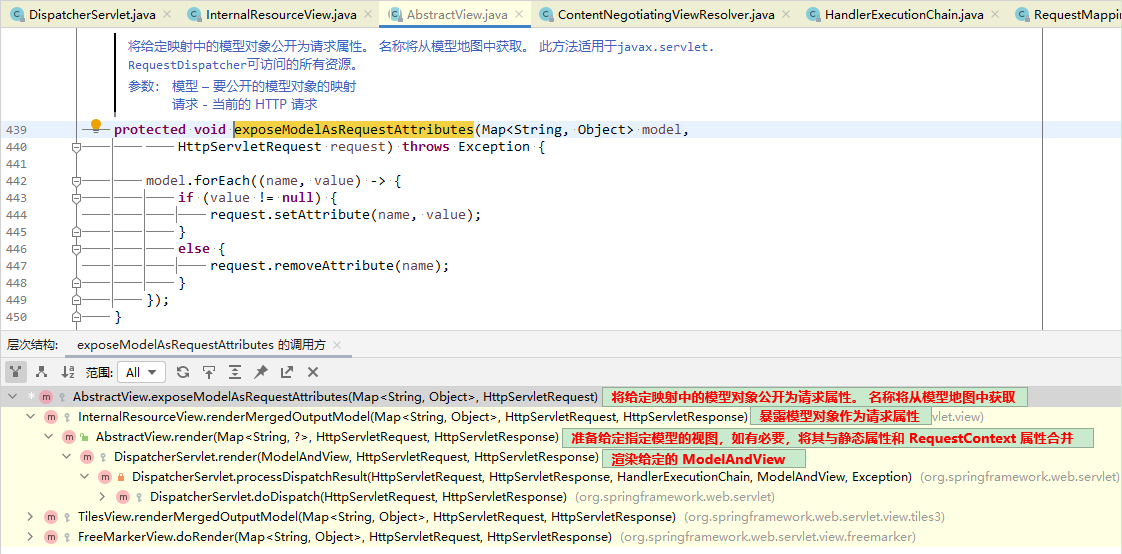
4、数据响应与内容协商
4.1 响应 JSON
4.1.1 jackson.jar + @ResponseBody
<dependency>
<groupId>org.springframework.boot</groupId>
<artifactId>spring-boot-starter-web</artifactId>
</dependency>
<!-- Web 场景自动引入了 json 场景,下面的依赖不需要显示声明 -->
<dependency>
<groupId>org.springframework.boot</groupId>
<artifactId>spring-boot-starter-json</artifactId>
<version>2.3.4.RELEASE</version>
<scope>compile</scope>
</dependency>
自动给前端返回 json 数据。
1、返回值解析器
// ServletInvocableHandlerMethod#invokeAndHandle
this.returnValueHandlers.handleReturnValue(
returnValue, getReturnValueType(returnValue), mavContainer, webRequest);
// HandlerMethodReturnValueHandlerComposite#handleReturnValue
handler.handleReturnValue(returnValue, returnType, mavContainer, webRequest);
// RequestResponseBodyMethodProcessor#handleReturnValue
// 使用对应的消息转换器进行写出操作
writeWithMessageConverters(returnValue, returnType, inputMessage, outputMessage);
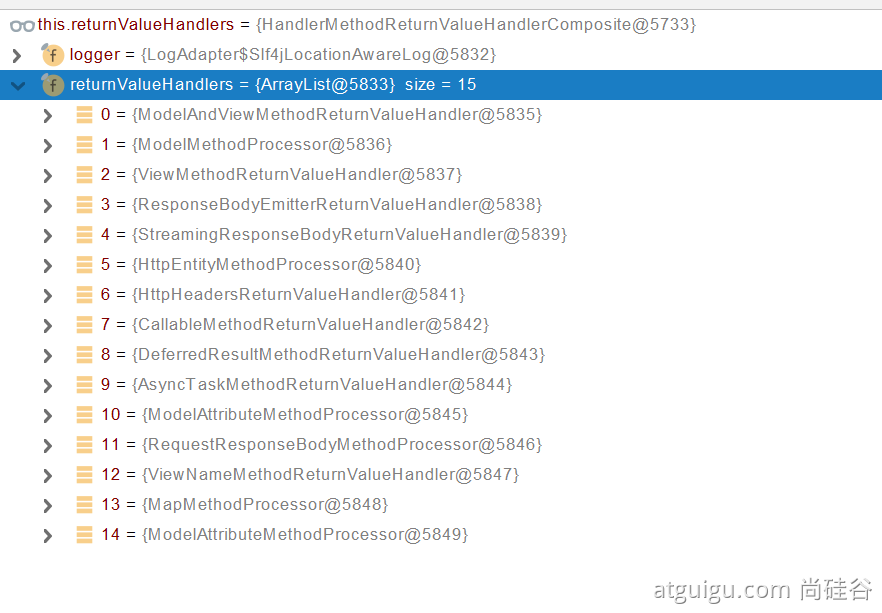
2、返回值解析器原理

-
返回值处理器判断是否支持这种类型的返回值
supportsReturnType;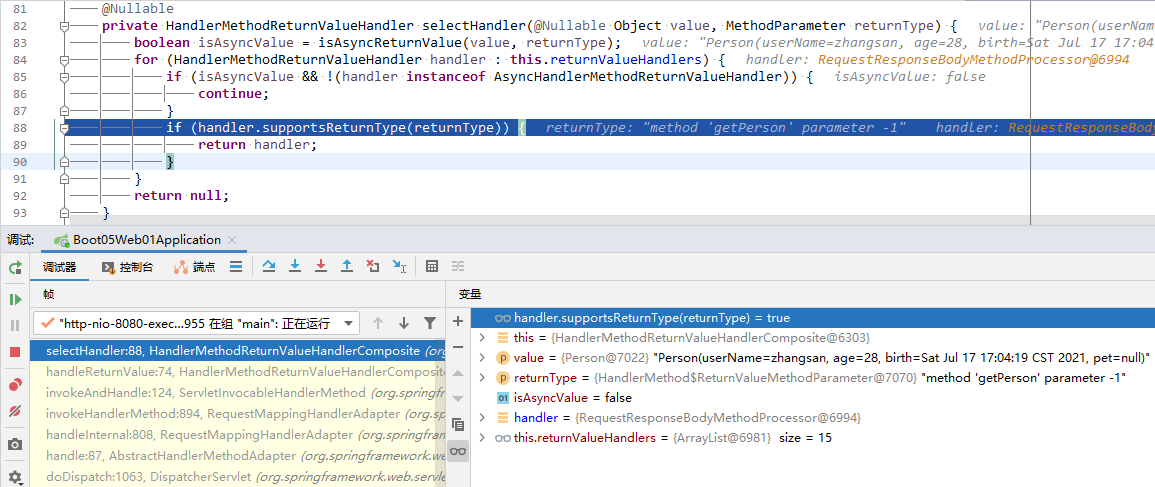
-
返回值处理器调用
handleReturnValue进行处理;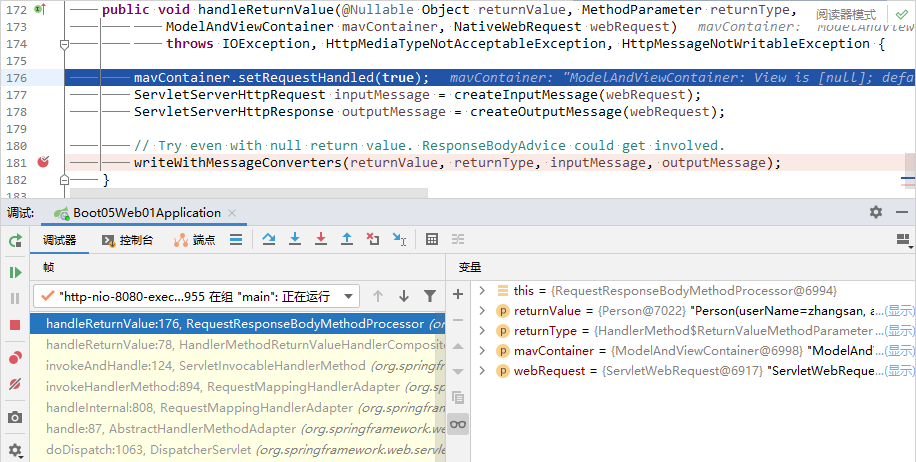
-
RequestResponseBodyMethodProcessor可以处理有 @ModelAttribute 且为对象类型的 @ResponseBody 注解。-
利用
MessageConverters进行处理将数据写为 json。-
内容协商:浏览器默认会以请求头(Accept 字段)的方式告诉服务器他能接受什么样的内容类型;
-
服务器根据自己的能力,决定能生产什么内容类型的数据;
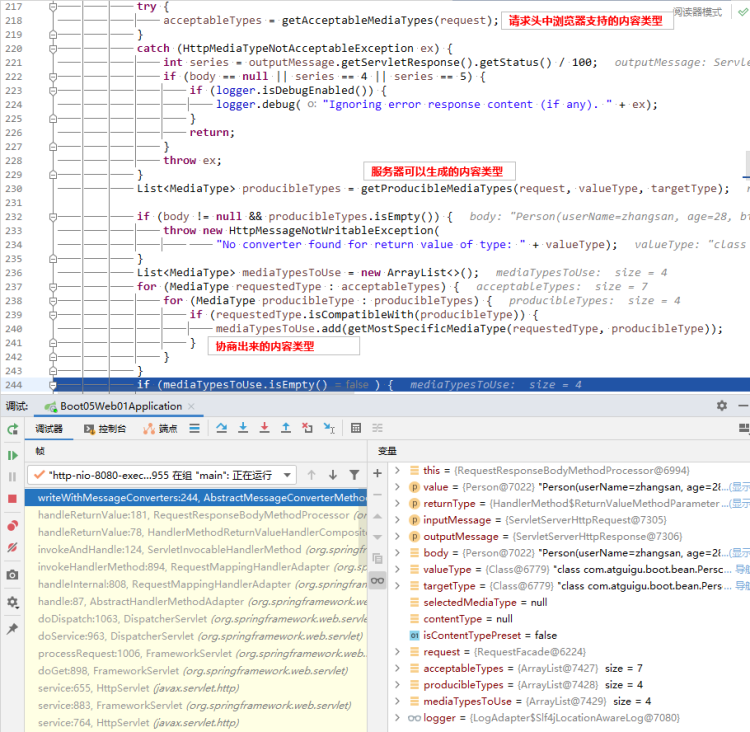
-
SpringMVC 会遍历所有容器底层的
HttpMessageConverter,看谁能处理。- 得到
MappingJackson2HttpMessageConverter,它可以将对象写为 json; - 利用
MappingJackson2HttpMessageConverter将对象转为 json 再写出去。
- 得到
-
-
4.1.2 支持的返回类型
-
ModelAndView:包含Model和View对象,可以通过它访问@ModelAttribute注解的对象。 -
Model:仅包含数据访问,通过RequestToViewNameTranslator来隐蔽地决定此请求返回的View视图对象。 -
Map:和Model相似。 -
View:仅包含视图数据,而Model数据隐含在@ModelAttribute注解标注的对象中、或者 -
String:表示View视图的名称。数据信息的保存同上。 -
void:当开发者直接操作ServletResponse/HttpServletResponse进行请求跳转,或者View由RequestToViewNameTranslator隐蔽地决定时,可使用此返回值。 -
任意对象:如果方法被
@ResponseBody注解,可采用此值。Spring 会使用HttpMessageConverters将对象转化成文本输出。 -
HttpEntity<?>或ResponseEntity<?>:使用此值,Spring 也会使用HttpMessageConverters将对象转化成文本输出。 -
Callable:异步请求时使用。 -
DeferredResult:当 Spring 决定使用选择的某个线程产生值时可以使用此对象。 -
WebAsyncTask:带有超时时间的 Callable 异步任务。

4.1.3 HTTPMessageConverter 原理
1、MessageConverter 规范
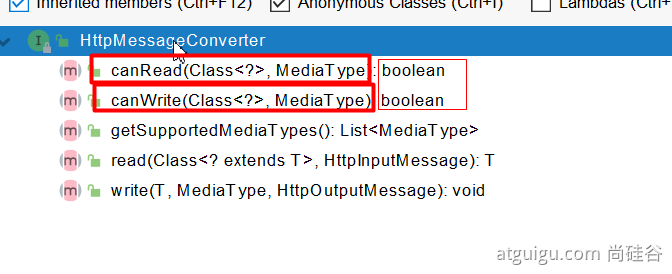
HttpMessageConverter: 调用 canRead() 或 canWrite() 方法判断是否支持将 此 Class 类型的对象,转为 MediaType 类型的数据。
例子: json 转为 Person 对象,或者Person 对象转为 json。
2、默认的MessageConverter
// AbstractMessageConverterMethodArgumentResolver#readWithMessageConverters
for (HttpMessageConverter<?> converter : this.messageConverters) {
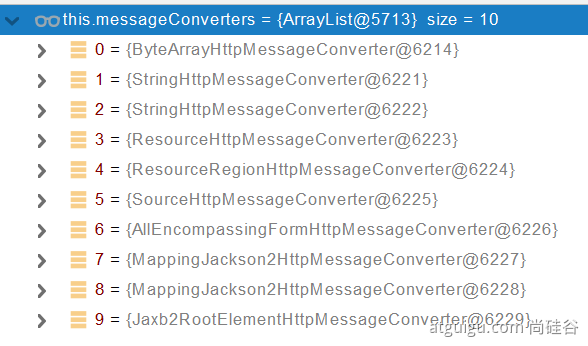
ByteArrayHttpMessageConverter:只支持字节数组类型的。StringHttpMessageConverter:UTF-8 类型的字符串。StringHttpMessageConverter:ISO-8859-1 类型的字符串。ResourceHttpMessageConverter:Resource类型。ResourceRegionHttpMessageConverter:ResourceHttpMessageConverter的缺省设置,用于支持 HTTP Range 头部使用时,将静态资源的部分写入到响应对象。SourceHttpMessageConverter:DOMSource.class、SAXSource.class、StAXSource.class、StreamSource.class、Source.class。AllEncompassingFormHttpMessageConverter:对FormHttpMessageConverter(表单与MultiValueMap的相互转换)的扩展,提供了对 xml 和 json 的支持。MappingJackson2HttpMessageConverter:使用 Jackson 的 ObjectMapper 转换 Json 数据MappingJackson2HttpMessageConverter:Jaxb2RootElementHttpMessageConverter:支持注解方式将对象转换为 xml。
最终 MappingJackson2HttpMessageConverter 把对象转为 json(利用底层 jackson 的objectMapper 转换的)。

【小家 Spring】Spring MVC 容器的 web 九大组件之 ---HandlerAdapter 源码详解 ---HttpMessageConverter 消息转换器详解
4.2 内容协商
4.2.1 引入 xml 依赖
根据客户端接收能力不同,返回不同媒体类型的数据。
若客户端无法解析服务端返回的内容,即媒体类型未匹配,那么响应 406。
<dependency>
<groupId>com.fasterxml.jackson.dataformat</groupId>
<artifactId>jackson-dataformat-xml</artifactId>
</dependency>
4.2.2 返回 json 和 xml
Postman 分别测试,只需要改变请求头中 Accept 字段。HTTP 协议中规定的,告诉服务器本客户端可以接收的数据类型。
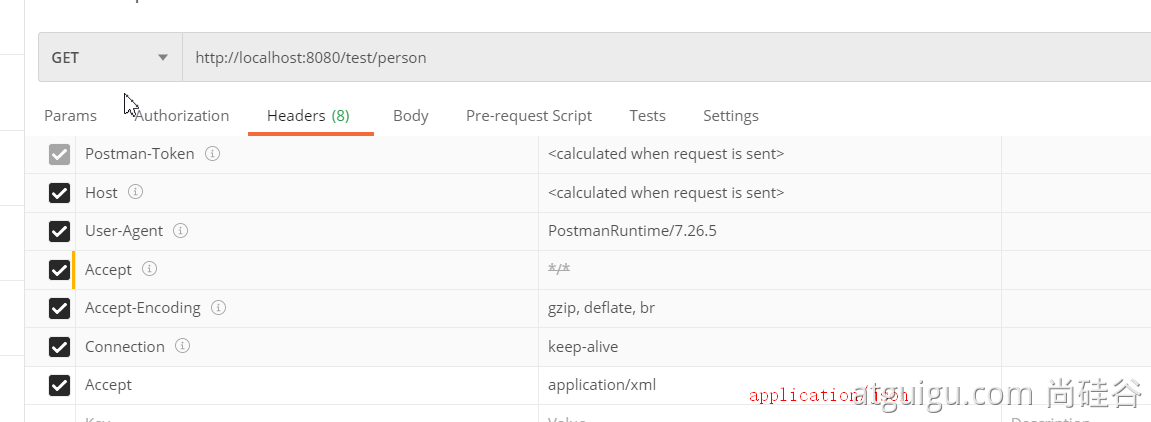
4.2.3 开启浏览器参数方式内容协商功能
为了方便内容协商,开启基于请求参数的内容协商功能。
spring:
contentnegotiation:
favor-parameter: true #开启请求参数内容协商模式
优缺点:
- 优点:不受浏览器约束。
- 缺点:需要额外的传递 format 参数,URL 变得冗余繁琐,缺少了 REST 的简洁风范。还有个缺点便是:需要手动显示开启。
发请求:
http://localhost:8080/test/person?format=json
http://localhost:8080/test/person?format=xml
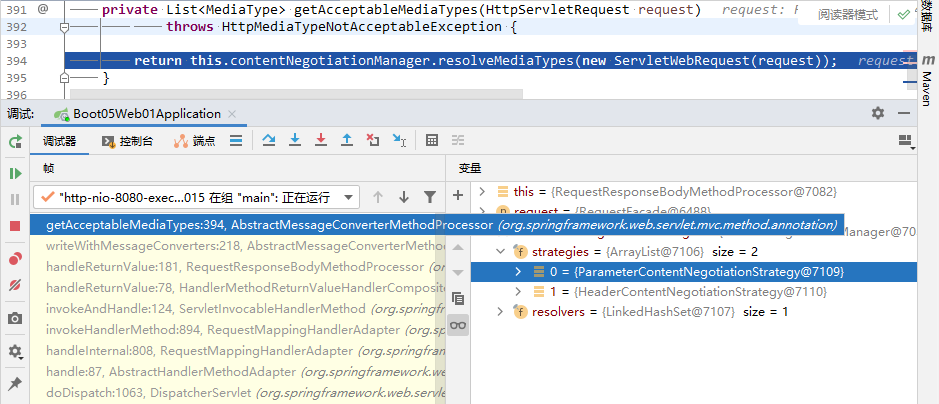
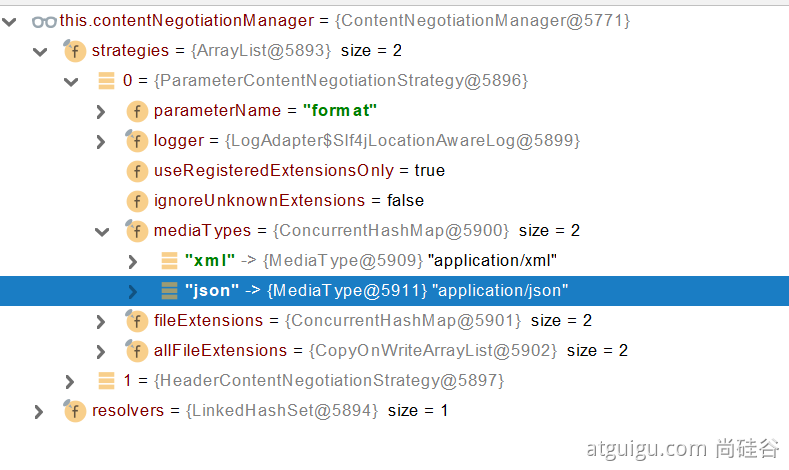
确定客户端接收什么样的内容类型:
-
Parameter 策略优先确定是要返回 json 数据(获取请求头中的 format 的值)
-
最终进行内容协商返回给客户端 json 即可。
4.2.4 内容协商原理
-
判断当前响应头中是否已经有确定的媒体类型
MediaType; -
获取客户端(PostMan、浏览器)支持接收的内容类型,即获取 Accept 请求头字段,如application/xml;
-
contentNegotiationManager内容协商管理器,默认使用基于请求头的策略;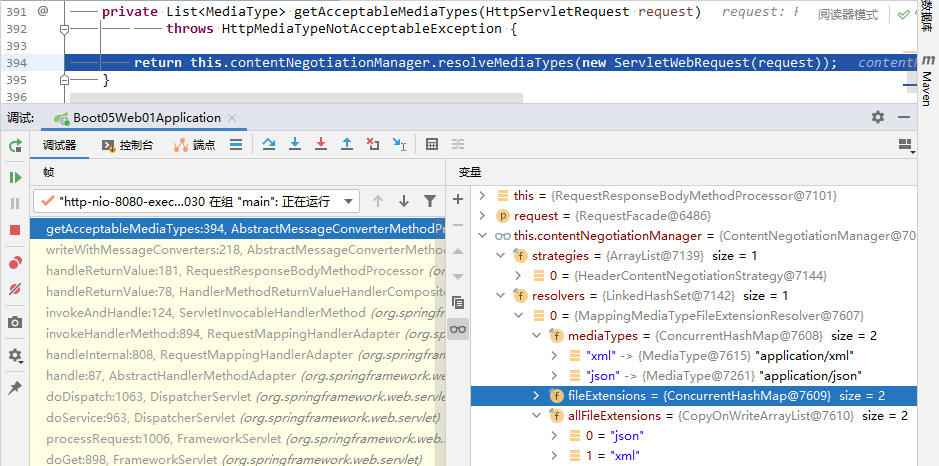
-
HeaderContentNegotiationStrategy确定客户端可以接收的内容类型 。
-
-
遍历循环所有当前系统的
MessageConverter,看谁支持操作这个Person对象;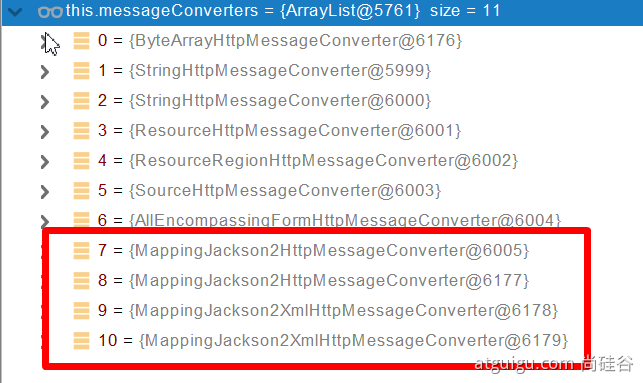
上面这四个并不完全一样:

-
找到支持操作
Person对象的MessageConverter,把MessageConverter支持的媒体类型统计出来; -
客户端需要 application/xml,在服务端能力列表中;
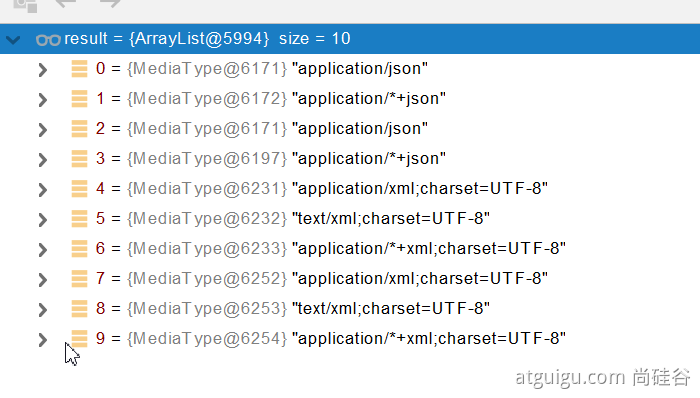
6、进行内容协商,选出最佳匹配媒体类型;
7、用 MessageConverter 将对象转为最佳匹配媒体类型 。
导入了 jackson 处理 xml 的包,xml 的 MessageConverter 就会自动配置进来。
// WebMvcConfigurationSupport
jackson2XmlPresent = ClassUtils.isPresent("com.fasterxml.jackson.dataformat.xml.XmlMapper", classLoader);
// WebMvcConfigurationSupport#addDefaultHttpMessageConverters
if (jackson2XmlPresent) {
Jackson2ObjectMapperBuilder builder = Jackson2ObjectMapperBuilder.xml();
if (this.applicationContext != null) {
builder.applicationContext(this.applicationContext);
}
messageConverters.add(new MappingJackson2XmlHttpMessageConverter(builder.build()));
}
4.2.5 自定义 MessageConverter
实现多协议数据兼容:json、xml、x-guigu。
@ResponseBody响应数据出去 调用RequestResponseBodyMethodProcessor处理;- Processor 处理方法返回值,通过
MessageConverter处理; - 所有
MessageConverter合起来可以支持各种媒体类型数据的操作(读、写); - 内容协商找到最终的
MessageConverter。
spring:
mvc:
contentnegotiation:
media-types:
gg: application/x-guigu
favor-parameter: true
配置 SpringMVC 的什么功能,只需要给容器中添加一个 WebMvcConfigurer 并配置即可。
@Bean
public WebMvcConfigurer webMvcConfigurer(){
return new WebMvcConfigurer() {
@Override
public void extendMessageConverters(List<HttpMessageConverter<?>> converters) {
}
}
}
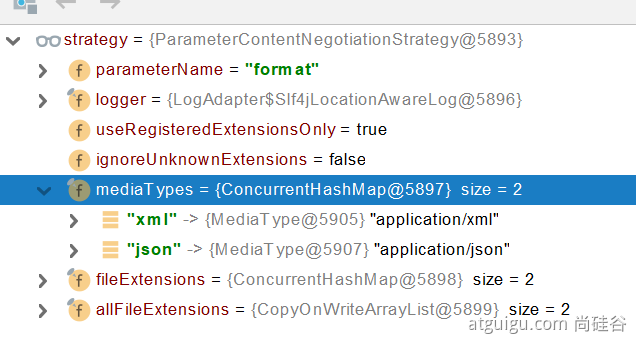
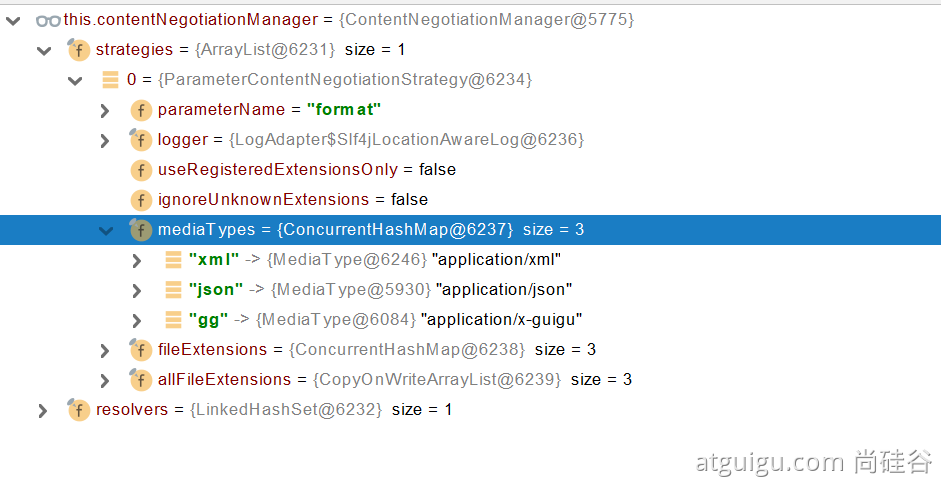
有可能我们添加的自定义的功能会覆盖默认很多功能,导致一些默认的功能失效。
5、视图解析与模板引擎
视图解析:SpringBoot默认不支持 JSP,需要引入第三方模板引擎技术实现页面渲染。
模板引擎:是为了使用户界面与业务数据(内容)分离而产生的,它可以生成特定格式的文档,用于网站的模板引擎就会生成一个标准的文档。
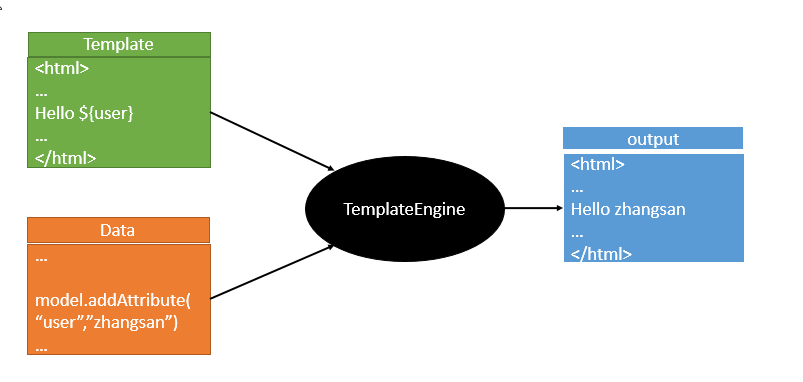
- Velocity:一个基于 Java 的模板引擎,其提供了一个
Context容器,在 Java 代码里面我们可以往容器中存值,然后在 vm 文件中使用特定的语法获取。 - [Freemarker](FreeMarker 教程网):一个基于模板生成文本输出的通用工具,使用纯 Java 编写,模板中没有业务逻辑,外部 Java 程序通过数据库操作等生成数据传入模板(template)中,然后输出页面。它能够生成各种文本:HTML、XML、RTF、Java 源代码等等,而且不需要 Servlet 环境,并且可以从任何源载入模板,如本地文件、数据库等等。
- Thymeleaf:是适用于 Web 和独立环境的现代服务器端 Java 模板引擎,能够处理 HTML,XML,JavaScript,CSS 甚至纯文本。有两种标记模板模式
HTML(常用)和XML,三种文本模板模式TEXT,JAVASCRIPT和CSS和无操作模板模式RAW。
SpringBoot 推荐使用 Thymeleaf,因为与 Velocity、FreeMarker 等传统的 Java 模板引擎不同,Thymeleaf 支持 HTML 模板模式,模板后缀为 .html,可以直接被浏览器打开,因此,预览时非常方便。
5.1 视图解析原理
-
目标方法处理的过程中,所有数据都会被放在
ModelAndViewContainer里面,包括数据和视图地址;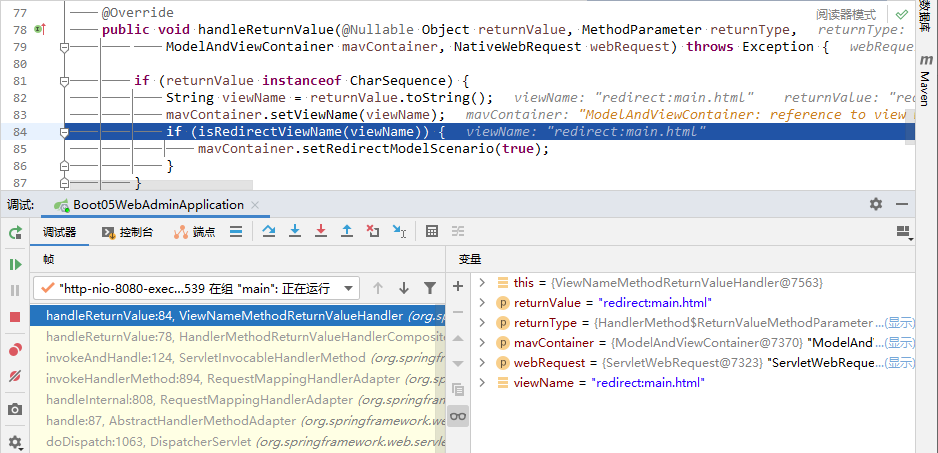
-
方法的参数是一个自定义类型对象(从请求参数中确定的),把它重新放在
ModelAndViewContainer; -
任何目标方法执行完成以后都会返回
ModelAndView(数据和视图地址); -
processDispatchResult处理派发结果(页面该如何响应)。-
render(mv, request, response);进行页面渲染逻辑。-
根据方法的
String返回值得到View对象(定义了页面的渲染逻辑)-
所有的视图解析器尝试是否能根据当前返回值得到 View 对象;
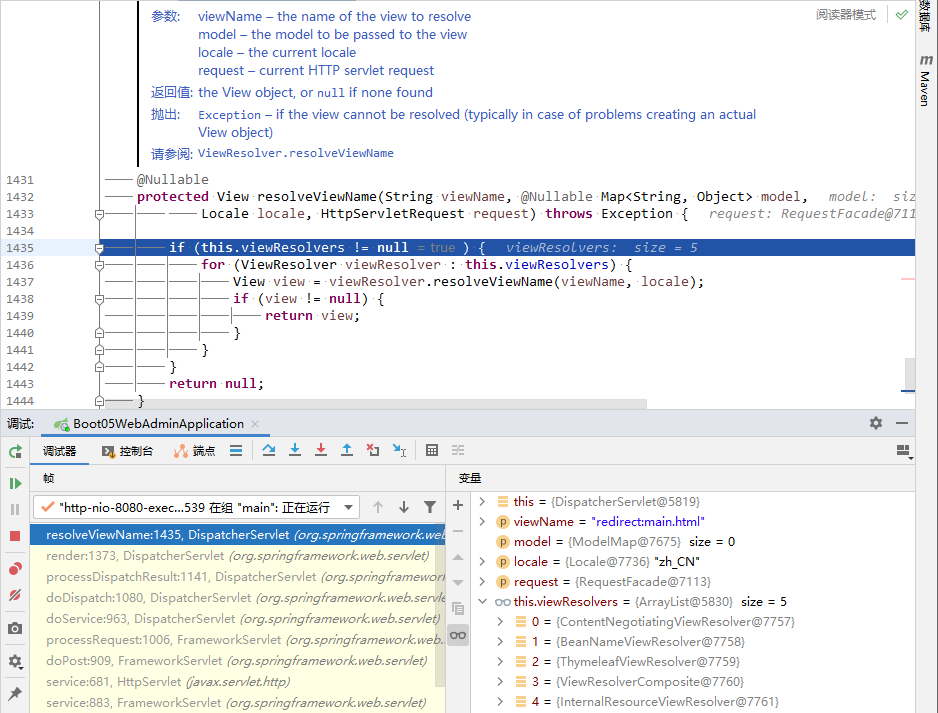
-
得到了 redirect:/main.html --> Thymeleaf 使用
new RedirectView()创建视图;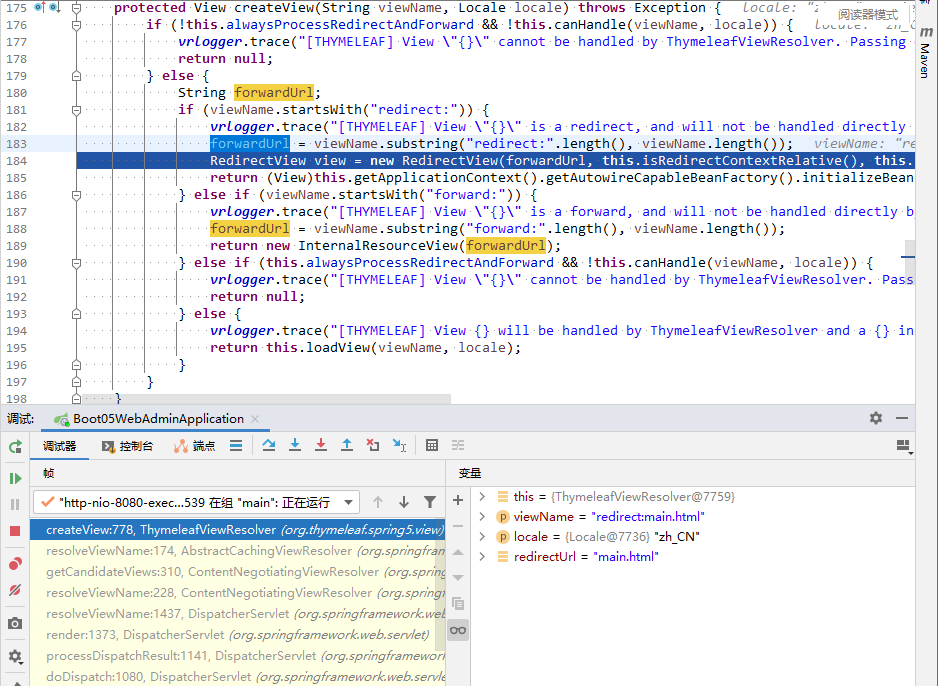
-
ContentNegotiationViewResolver里面包含了下面所有的视图解析器,内部还是利用上面所有视图解析器得到视图对象; -
view.render(mv.getModelInternal(), request, response);视图对象调用自定义的render进行页面渲染工作。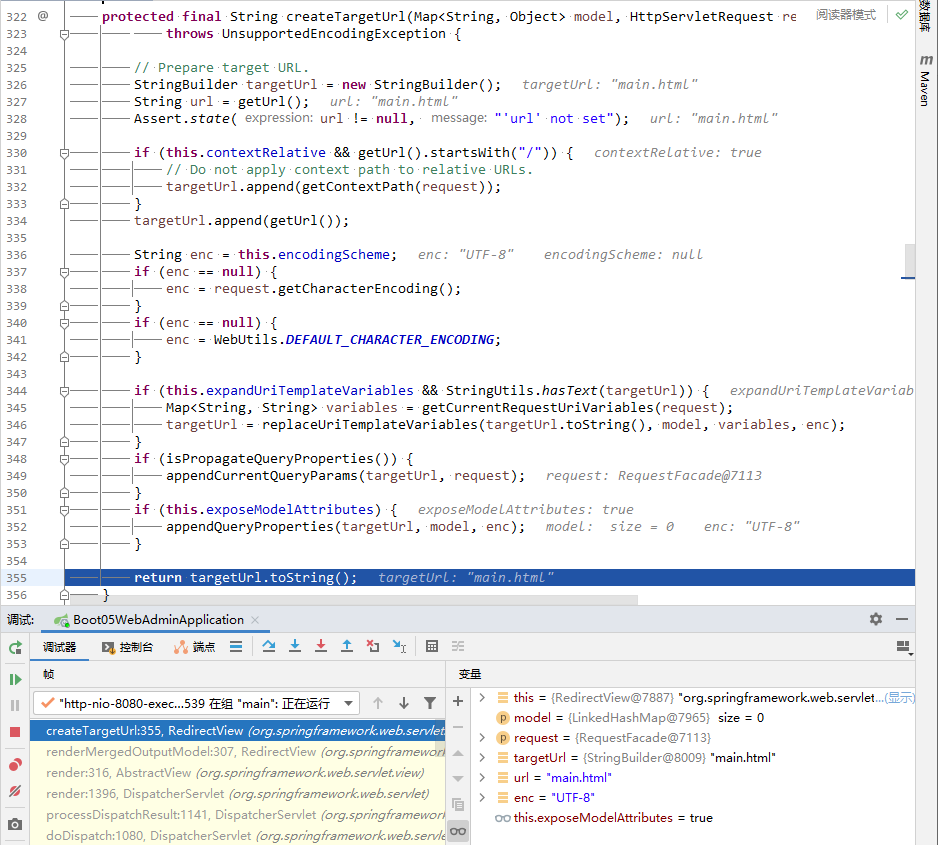
-
RedirectView如何渲染(重定向到一个页面)。-
获取目标
URL地址; -
调用原生的
response.sendRedirect(encodedURL);发送重定向。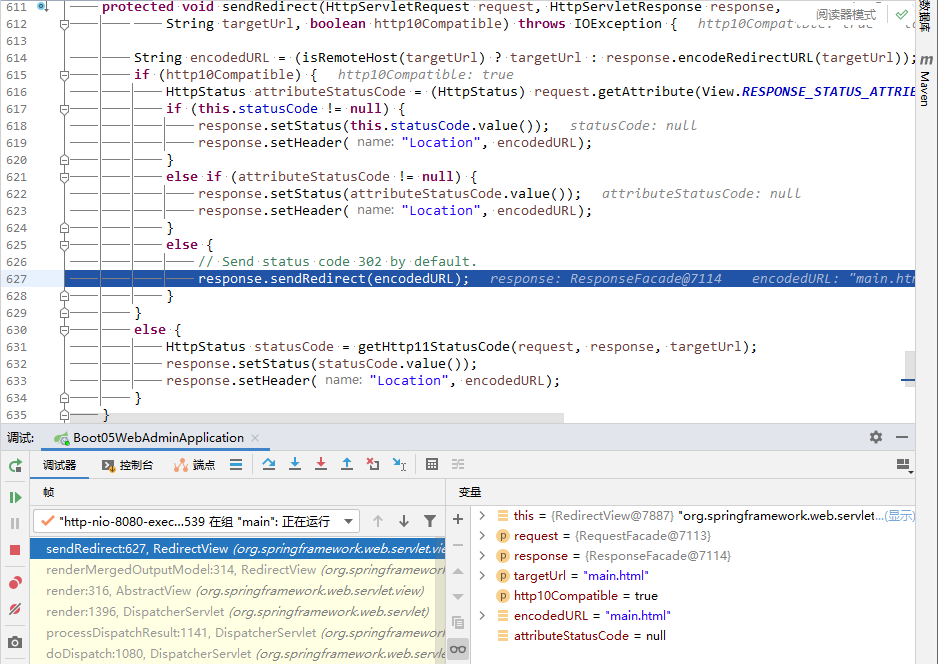
-
-
-
-
-
Controller 方法的返回值如下
5.1.1 返回 ModelAndView
-
ModelAndView存放数据,addObject(),往model(request域)添加数据; -
ModelAndView添加逻辑视图名,setViewName(),经过视图解析器,得到物理视图,转发到物理视图。
@RequestMapping("/getUser.action")
public ModelAndView getUser(@RequestParam(name="userId",required = true) Integer id) throws Exception{
System.out.println("id=" + id);
ModelAndView modelAndView = new ModelAndView();
User user = userService.queryOne(id);
modelAndView.addObject("user", user);
modelAndView.setViewName("userinfo");
return modelAndView;
}
5.1.2 返回 String
-
逻辑视图名: 经过视图解析器,得到物理视图,转发到物理视图;
@RequestMapping("/index.action") public String toIndex() { return "index"; } -
redirect:资源路径:不经过视图解析器,要求这个资源路径以完整的路径/开头,重定向到资源;new RedirectView()->response.sendRedirect(encodedURL);@RequestMapping("/index.action") public String toIndex() { return "redirect:/jsp/index.jsp"; } -
forward:资源路径: 不经过视图解析器,要求这个资源路径以完整的路径/开头,转发到资源;new InternalResourceView(forwardUrl);->request.getRequestDispatcher(path).forward(request, response);@RequestMapping("/index.action") public String toIndex() { return "forward:/jsp/index.jsp"; } -
普通字符串、对象:
new ThymeleafView()-> 调用模板引擎的process方法进行页面渲染(用writer输出)// 将 user 对象以 json 的格式响应给前端页面 @RequestMapping("/queryUserByCondition.action") @ResponseBody // 需要结合该注解,表示响应的不是视图 public User queryUserByCondition(User user) throws Exception{ return user; }
5.2 Thymeleaf 语法
5.2.1 表达式
| 表达式名字 | 语法 | 用途 |
|---|---|---|
| 变量取值 | $ | 获取请求域、session 域、对象等值 |
| 选择变量 | * | 获取上下文对象值 |
| 消息 | # | 获取国际化等值 |
| 链接 | @ | 生成链接 |
| 片段表达式 | ~ | 类似于 jsp:include,引入公共页面片段 |
5.2.2 字面量
文本值:'one text'、'Another one!'、…
数字:0、34、3.0、12.3、…
布尔值:true、false
空值:null
变量:one、two、.... 变量不能有空格
5.2.3 文本操作
字符串拼接:+
变量替换:|The name is ${name}|
5.2.4 数学运算
运算符:+、- 、*、/、%
5.2.5布尔运算
运算符:and、or
一元运算:!、not
5.2.6比较运算
比较:>、<、>=、<= (gt、lt、ge、le)
等式:==、!= (eq、ne )
5.2.7 条件运算
If-then:(if) ? (then)
If-then-else:(if) ? (then) : (else)
Default:(value) ?: (defaultvalue)
5.2.8 特殊操作
无操作:_
5.2.9 设置属性值 th:attr
设置单个值:
<form action="subscribe.html" th:attr="action=@{/subscribe}">
<fieldset>
<input type="text" name="email" />
<input type="submit" value="Subscribe!" th:attr="value=#{subscribe.submit}"/>
</fieldset>
</form>
设置多个值:
<img src="../../images/gtvglogo.png" th:attr="src=@{/images/gtvglogo.png},title=#{logo},alt=#{logo}" />
以上两个的代替写法 th:xxx
<input type="submit" value="Subscribe!" th:value="#{subscribe.submit}"/>
<form action="subscribe.html" th:action="@{/subscribe}">
所有 HTML5 兼容的标签写法:
https://www.thymeleaf.org/doc/tutorials/3.0/usingthymeleaf.html#setting-value-to-specific-attributes
5.2.10 迭代
<tr th:each="prod : ${prods}">
<td th:text="${prod.name}">Onions</td>
<td th:text="${prod.price}">2.41</td>
<td th:text="${prod.inStock}? #{true} : #{false}">yes</td>
</tr>
<tr th:each="prod,iterStat : ${prods}" th:class="${iterStat.odd}? 'odd'">
<td th:text="${prod.name}">Onions</td>
<td th:text="${prod.price}">2.41</td>
<td th:text="${prod.inStock}? #{true} : #{false}">yes</td>
</tr>
5.2.11 条件运算
<a href="comments.html"
th:href="@{/product/comments(prodId=${prod.id})}"
th:if="${not #lists.isEmpty(prod.comments)}">view</a>
<div th:switch="${user.role}">
<p th:case="'admin'">User is an administrator</p>
<p th:case="#{roles.manager}">User is a manager</p>
<p th:case="*">User is some other thing</p>
</div>
5.2.12属性优先级

5.3 Thymeleaf 使用
5.3.1 引入 starter
<properties>
<java.version>1.8</java.version>
<thymeleaf.version>3.0.11.RELEASE</thymeleaf.version>
<!-- 布局功能的支持程序 thymeleaf3 主程序 layout2 以上版本 -->
<thymeleaf-layout-dialect.version>2.4.1</thymeleaf-layout-dialect.version>
</properties>
<dependency>
<groupId>org.springframework.boot</groupId>
<artifactId>spring-boot-starter-thymeleaf</artifactId>
</dependency>
5.3.2 Thymeleaf 自动配置
@Configuration(proxyBeanMethods = false)
@EnableConfigurationProperties(ThymeleafProperties.class)
@ConditionalOnClass({ TemplateMode.class, SpringTemplateEngine.class })
@AutoConfigureAfter({ WebMvcAutoConfiguration.class, WebFluxAutoConfiguration.class })
public class ThymeleafAutoConfiguration { }
自动配好的策略
-
所有 Thymeleaf 的配置值都在
ThymeleafProperties。 -
配置好了
SpringTemplateEngine。 -
配置好了
ThymeleafViewResolver。 -
我们只需要直接开发页面。
@ConfigurationProperties(prefix = "spring.thymeleaf")
public class ThymeleafProperties {
private static final Charset DEFAULT_ENCODING = StandardCharsets.UTF_8;
public static final String DEFAULT_PREFIX = "classpath:/templates/";
public static final String DEFAULT_SUFFIX = ".html";
只要我们把 HTML 页面放在 classpath:/templates/,Thymeleaf 就能自动渲染。
Thymeleaf 页面开发
<!DOCTYPE html>
<html lang="en" xmlns:th="http://www.thymeleaf.org">
<head>
<meta charset="UTF-8">
<title>Title</title>
</head>
<body>
<h1 th:text="${msg}"> 哈哈 </h1>
<h2>
<a href="www.atguigu.com" th:href="${link}"> 去百度 </a><br/>
<a href="www.atguigu.com" th:href="@{link}"> 去百度 2</a>
</h2>
</body>
</html>
6、构建后台管理系统
6.1 创建项目
pom.xml 需要引入以下依赖:thymeleaf、web-starter、devtools、lombok。
6.2静态资源处理
已经自动配置好,只需把所有静态资源放到 static 文件夹下,模板页面放到 templates 文件夹下。
6.3 路径构建
th:action="@{/login}"
6.4 页面跳转
Controller :
@PostMapping("/login")
public String main(User user, HttpSession session, Model model){
if (StringUtils.hasLength (user.getUserName()) && "123456".equals (user.getPassword())){
// 把登陆成功的用户保存起来
session.setAttribute("loginUser",user);
// 登录成功重定向到 main.html; 重定向防止表单重复提交
return "redirect:/main.html";
} else {
model.addAttribute("msg","账号密码错误");
// 回到登录页面
return "login";
}
}
登陆错误消息的显示:
<p style="color: red" th:text="${msg}" th:if="${not #strings.isEmpty(msg)}"></p>
6.5 数据渲染
Controller :
@GetMapping("/dynamic_table")
public String dynamic_table(Model model){
// 表格内容的遍历
List<User> users = Arrays.asList(new User("zhangsan", "123456"),
new User("lisi", "654321"),
new User("haha", "aaa"));
model.addAttribute("users", users);
return "table/dynamic_table";
}
6.6 模板页面
table/dynamic_table.html:
<table class="display table table-bordered" id="hidden-table-info">
<thead>
<tr>
<th>#</th>
<th>用户名</th>
<th>密码</th>
</tr>
</thead>
<tbody>
<tr class="userClass" th:each="user,stats:${users}">
<td th:text="${stats.count}"></td>
<td th:text="${user.userName}"></td>
<td>[[${user.password}]]</td> <!-- 行内写法 -->
</tr>
</tbody>
</table>
开发期间模板引擎页面修改以后,要实时生效,需要禁用模板引擎的缓存,页面修改完成以后Ctrl + F9:重新编译(无需重新启动)。
# 禁用缓存
spring.thymeleaf.cache=false
6.7 国际化
6.7.1 简介
- 编写国际化配置文件;
- 使用
ResourceBundleMessageSource管理国际化资源文件; - 在页面使用
fmt:message取出国际化内容。
6.7.2 步骤
- 编写国际化配置文件,抽取页面需要显示的国际化消息;
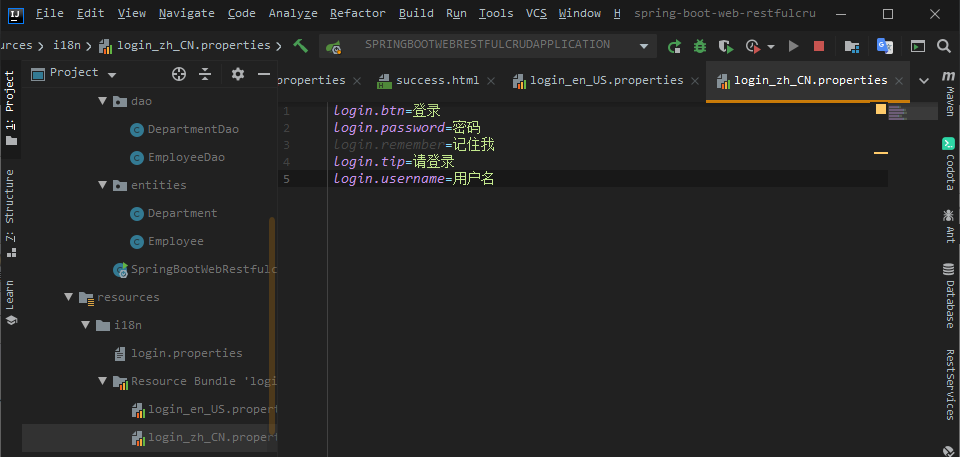
- SpringBoot 自动配置好了管理国际化资源文件的组件;
public class MessageSourceAutoConfiguration {
private static final Resource[] NO_RESOURCES = {};
@Bean
// 我们的配置文件可以直接放在类路径下叫messages.properties。
@ConfigurationProperties(prefix = "spring.messages")
public MessageSourceProperties messageSourceProperties() {
return new MessageSourceProperties();
}
@Bean
public MessageSource messageSource(MessageSourceProperties properties) {
ResourceBundleMessageSource messageSource = new ResourceBundleMessageSource();
if (StringUtils.hasText(properties.getBasename())) {
// 设置国际化资源文件的基础名(去掉语言国家代码的)。
messageSource.setBasenames(StringUtils
.commaDelimitedListToStringArray(StringUtils.trimAllWhitespace(properties.getBasename())));
}
if (properties.getEncoding() != null) {
messageSource.setDefaultEncoding(properties.getEncoding().name());
}
messageSource.setFallbackToSystemLocale(properties.isFallbackToSystemLocale());
Duration cacheDuration = properties.getCacheDuration();
if (cacheDuration != null) {
messageSource.setCacheMillis(cacheDuration.toMillis());
}
messageSource.setAlwaysUseMessageFormat(properties.isAlwaysUseMessageFormat());
messageSource.setUseCodeAsDefaultMessage(properties.isUseCodeAsDefaultMessage());
return messageSource;
}
- 去页面获取国际化的内容。
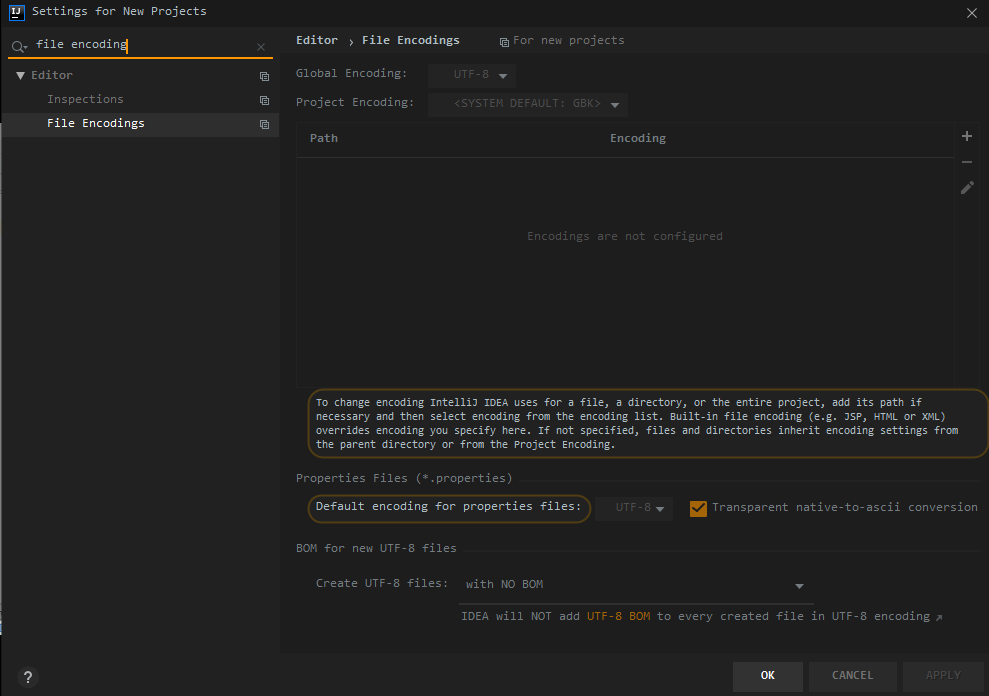
<!DOCTYPE html>
<html lang="en" xmlns:th="http://www.thymeleaf.org">
<head>
<meta http-equiv="Content-Type" content="text/html; charset=UTF-8">
<meta name="viewport" content="width=device-width, initial-scale=1, shrink-to-fit=no">
<meta name="description" content="">
<meta name="author" content="">
<title>Signin Template for Bootstrap</title>
<!-- Bootstrap core CSS -->
<link href="asserts/css/bootstrap.min.css" th:href="@{/webjars/bootstrap/4.4.1/css/bootstrap.css}" rel="stylesheet">
<!-- Custom styles for this template -->
<link href="asserts/css/signin.css" th:href="@{/asserts/css/signin.css}" rel="stylesheet">
</head>
<body class="text-center">
<form class="form-signin" action="dashboard.html">
<img class="mb-4" th:src="@{/asserts/img/bootstrap-solid.svg}" src="asserts/img/bootstrap-solid.svg" alt="" width="72" height="72">
<h1 class="h3 mb-3 font-weight-normal" th:text="#{login.tip}">Please sign in</h1>
<label class="sr-only" th:text="#{login.username}">Username</label>
<input type="text" class="form-control" placeholder="Username" th:placeholder="#{login.username}" required="" autofocus="">
<label class="sr-only" th:text="#{login.password}">Password</label>
<input type="password" class="form-control" placeholder="Password" th:placeholder="#{login.password}" required="">
<div class="checkbox mb-3">
<label>
<input type="checkbox" value="remember-me"/> [[#{login.remember}]]
</label>
</div>
<button class="btn btn-lg btn-primary btn-block" type="submit" th:text="#{login.btn}">Sign in</button>
<p class="mt-5 mb-3 text-muted">© 2020-2021</p>
<a class="btn btn-sm">中文</a>
<a class="btn btn-sm">English</a>
</form>
</body>
</html>
效果:根据浏览器设置的语言信息切换了国际化。
6.7.3 原理
Locale:区域信息对象;LocaleResolver:获取区域信息对象。
@Bean
@ConditionalOnMissingBean
@ConditionalOnProperty(prefix = "spring.mvc", name = "locale")
public LocaleResolver localeResolver() {
if (this.mvcProperties.getLocaleResolver() == WebMvcProperties.LocaleResolver.FIXED) {
return new FixedLocaleResolver(this.mvcProperties.getLocale());
}
AcceptHeaderLocaleResolver localeResolver = new AcceptHeaderLocaleResolver();
localeResolver.setDefaultLocale(this.mvcProperties.getLocale());
return localeResolver;
}
默认的就是根据请求头带来的区域信息获取 Locale 进行国际化。
- 点击链接切换国际化
// 可以在链接上携带区域信息
public class MyLocaleResolver implements LocaleResolver {
@Override
public Locale resolveLocale(HttpServletRequest request) {
String l = request.getParameter("l");
Locale locale = Locale.getDefault();
if(!StringUtils.isEmpty(l)){
String[] split = l.split("_");
locale = new Locale(split[0],split[1]);
}
return locale;
}
@Override
public void setLocale(HttpServletRequest request, HttpServletResponse response, Locale locale) {
}
@Bean
public LocaleResolver localeResolver(){
return new MyLocaleResolver();
}
}
7、RESTful 的 CRUD
7.1 实验要求
- CRUD 满足 REST 风格。
URI:/资源名称/资源标识,以 HTTP 请求方式区分对资源的 CRUD 操作。
| 普通的 CRUD(URI 来区分操作) | RESTful 的 CRUD | |
|---|---|---|
| 查询 | getEmp | emp---GET |
| 添加 | addEmp?xxx | emp---POST |
| 修改 | updateEmp?id=xxx&xxx=xx | emp/{id}---PUT |
| 删除 | deleteEmp?id=1 | emp/{id}---DELETE |
- 请求架构
| 实验功能 | 请求 URI | 请求方式 |
|---|---|---|
| 查询所有员工 | emps | GET |
| 查询某个员工(来到修改页面) | emp/1 | GET |
| 来到添加页面 | emp | GET |
| 添加员工 | emp | POST |
| 来到修改页面(查出员工信息并进行回显) | emp/1 | GET |
| 修改员工 | emp | PUT |
| 删除员工 | emp/1 | DELETE |
7.2 CRUD-员工列表
Thymeleaf 公共页面元素抽取:
-
抽取公共片段
<div th:fragment="copy">© 2021 The Good Thymes Virtual Grocery</div> -
引入公共片段
<div th:insert="~{footer :: copy}"></div>~{templatename::selector}-> 模板名 :: 选择器~{templatename::fragmentname}-> 模板名 :: 片段名
-
默认效果
insert的公共片段在div标签中;- 如果使用
th:insert等属性进行引入,可以不用写~{}; - 行内写法:
[[~{}]]或[(~{})]。
三种引入公共片段的 th 属性:
th:insert:将公共片段整个插入到声明引入的元素中;th:replace:将声明引入的元素替换为公共片段;th:include:将被引入的片段的内容包含进这个标签中。
<footer th:fragment="copy">© 2011 The Good Thymes Virtual Grocery</footer>
<!-- 三种引入方式 -->
<div th:insert="footer :: copy"></div>
<div th:replace="footer :: copy"></div>
<div th:include="footer :: copy"></div>
<!-- 对应的效果 -->
<div><footer>© 2011 The Good Thymes Virtual Grocery</footer></div>
<footer>© 2011 The Good Thymes Virtual Grocery</footer>
<div>© 2011 The Good Thymes Virtual Grocery</div>
引入片段的时候传入参数:
<nav class="col-md-2 d-none d-md-block bg-light sidebar" id="sidebar">
<div class="sidebar-sticky">
<ul class="nav flex-column">
<li class="nav-item">
<a class="nav-link active"
th:class="${activeUri=='main.html' ? 'nav-link active' : 'nav-link'}"
href="#" th:href="@{/main.html}">
<svg xmlns="http://www.w3.org/2000/svg" width="24" height="24" viewBox="0 0 24 24" fill="none" stroke="currentColor" stroke-width="2" stroke-linecap="round" stroke-linejoin="round" class="feather feather-home">
<path d="M3 9l9-7 9 7v11a2 2 0 0 1-2 2H5a2 2 0 0 1-2-2z"></path>
<polyline points="9 22 9 12 15 12 15 22"></polyline>
</svg>
Dashboard <span class="sr-only">(current)</span>
</a>
</li>
<!-- 引入侧边栏并传入参数 -->
<div th:replace="commons/bar :: #sidebar(activeUri='emps')"></div>
7.3 CRUD-员工添加
添加页面:
<form th:action="@{/emp}" method="post">
<div class="form-group">
<label>LastName</label>
<input name="LastName" type="text" class="form-control" placeholder="zhangsan">
</div>
<div class="form-group">
<label>Email</label>
<input name="email" type="email" class="form-control" placeholder="zhangsan@atguigu.com">
</div>
<div class="form-group">
<label>Gender</label><br/>
<div class="form-check form-check-inline">
<input class="form-check-input" type="radio" name="gender" value="1">
<label class="form-check-label">男</label>
</div>
<div class="form-check form-check-inline">
<input class="form-check-input" type="radio" name="gender" value="0">
<label class="form-check-label">女</label>
</div>
</div>
<div class="form-group">
<label>department</label>
<select class="form-control" name="department.id">
<!-- 提交的是部门的 id -->
<option th:value="${dept.id}" th:each="dept:${depts}" th:text="${dept.departmentName}">1</option>
</select>
</div>
<div class="form-group">
<label>Birth</label>
<input name="birth" type="text" class="form-control" placeholder="zhangsan">
</div>
<button type="submit" class="btn btn-primary">添加</button>
</form>
7.4 CRUD-员工修改
修改添加二合一表单:
<!-- 需要区分是员工修改还是添加 -->
<form th:action="@{/emp}" method="post">
<!-- 发送 PUT 请求修改员工数据 -->
<!-- REST 使用方式:
1、SpringMVC 中配置 HiddenHttpMethodFilter(Springboot 自动配置);
2、页面创建一个 POST 表单;
3、创建一个 input 项,name="_method",值就是我们指定的请求方式。
-->
<input type="hidden" name="_method" value="put" th:if="${emp!=null}"/>
<input type="hidden" name="id" th:if="${emp!=null}" th:value="${emp.id}"/>
<div class="form-group">
<label>LastName</label>
<input name="lastName" type="text" class="form-control" placeholder="zhangsan" th:value="${emp!=null}?${emp.lastName}">
</div>
<div class="form-group">
<label>Email</label>
<input name="email" type="email" class="form-control" placeholder="zhangsan@atguigu.com" th:value="${emp!=null}?${emp.email}">
</div>
<div class="form-group">
<label>Gender</label><br/>
<div class="form-check form-check-inline">
<input class="form-check-input" type="radio" name="gender" value="1" th:checked="${emp!=null}?${emp.gender==1}">
<label class="form-check-label">男</label>
</div>
<div class="form-check form-check-inline">
<input class="form-check-input" type="radio" name="gender" value="0" th:checked="${emp!=null}?${emp.gender==0}">
<label class="form-check-label">女</label>
</div>
</div>
<div class="form-group">
<label>department</label>
<!-- 提交的是部门的 id -->
<select class="form-control" name="department.id">
<option th:selected="${emp!=null}?${dept.id}==${emp.department.id}" th:value="${dept.id}" th:each="dept:${depts}" th:text="${dept.departmentName}">1</option>
</select>
</div>
<div class="form-group">
<label>Birth</label>
<input name="birth" type="text" class="form-control" placeholder="zhangsan" th:value="${emp!=null}?${#dates.format(emp.birth, 'yyyy-MM-dd HH:mm')}">
</div>
<button type="submit" class="btn btn-primary" th:text="${emp!=null}?'修改':'添加'">添加</button>
</form>
7.5 CRUD-员工删除
如果报错:
org.springframework.web.HttpRequestMethodNotSupportedException: Request method 'POST' not supported
那么需要在 application.properties 中配置:
# 启用 hiddenMethod 过滤器
spring.mvc.hiddenmethod.filter.enabled=true
<tr th:each="emp:${emps}">
<td th:text="${emp.id}"></td>
<td>[[${emp.lastName}]]</td>
<td th:text="${emp.email}"></td>
<td th:text="${emp.gender}==0?'女':'男'"></td>
<td th:text="${emp.department.departmentName}"></td>
<td th:text="${#dates.format(emp.birth, 'yyyy-MM-dd HH:mm')}"></td>
<td>
<a class="btn btn-sm btn-primary" th:href="@{/emp/}+${emp.id}">编辑</a>
<button th:attr="del_uri=@{/emp/}+${emp.id}" class="btn btn-sm btn-danger deleteBtn">删除</button>
</td>
</tr>
<script>
$(".deleteBtn").click(function(){
// 删除当前员工
$("#deleteEmpForm").attr("action", $(this).attr("del_uri")).submit();
return false;
});
</script>
8、拦截器
8.1 HandlerInterceptor 接口
/**
* 登录检查:
* 1、配置好拦截器要拦截哪些请求;
* 2、把这些配置放在容器中。
*/
@Slf4j
public class LoginInterceptor implements HandlerInterceptor {
// 目标方法执行之前
@Override
public boolean preHandle(HttpServletRequest request, HttpServletResponse response, Object handler) throws Exception {
String requestURI = request.getRequestURI();
log.info("preHandle 拦截的请求路径是 {}",requestURI);
// 登录检查逻辑
HttpSession session = request.getSession();
Object loginUser = session.getAttribute ("loginUser");
if (loginUser != null){
// 放行
return true;
}
// 未登录:拦截住请求,然后跳转到登录页
request.setAttribute("msg","请先登录");
// request.sendRedirect("/");
request.getRequestDispatcher("/").forward(request,response);
return false;
}
// 目标方法执行完成以后
@Override
public void postHandle (HttpServletRequest request, HttpServletResponse response, Object handler, ModelAndView modelAndView) throws Exception {
log.info ("postHandle 执行 {}", modelAndView);
}
// 页面渲染完成以后
@Override
public void afterCompletion (HttpServletRequest request, HttpServletResponse response, Object handler, Exception ex) throws Exception {
log.info ("afterCompletion 执行异常 {}",ex);
}
}
8.2 配置拦截器
/**
* 1、编写一个拦截器实现 HandlerInterceptor 接口
* 2、拦截器注册到容器中(实现 WebMvcConfigurer 的 addInterceptors 方法)
* 3、指定拦截规则(如果是拦截所有,静态资源也会被拦截)
*/
@Configuration
public class AdminWebConfig implements WebMvcConfigurer {
@Override
public void addInterceptors (InterceptorRegistry registry) {
registry.addInterceptor (new LoginInterceptor ())
.addPathPatterns ("/**") // 所有请求都被拦截包括静态资源
.excludePathPatterns ("/","/login","/css/**","/fonts/**","/images/**","/js/**"); // 放行的请求
}
}
8.3 拦截器原理
-
根据当前请求,找到
HandlerExecutionChain(可以处理请求的 handler 以及 handler 的所有拦截器);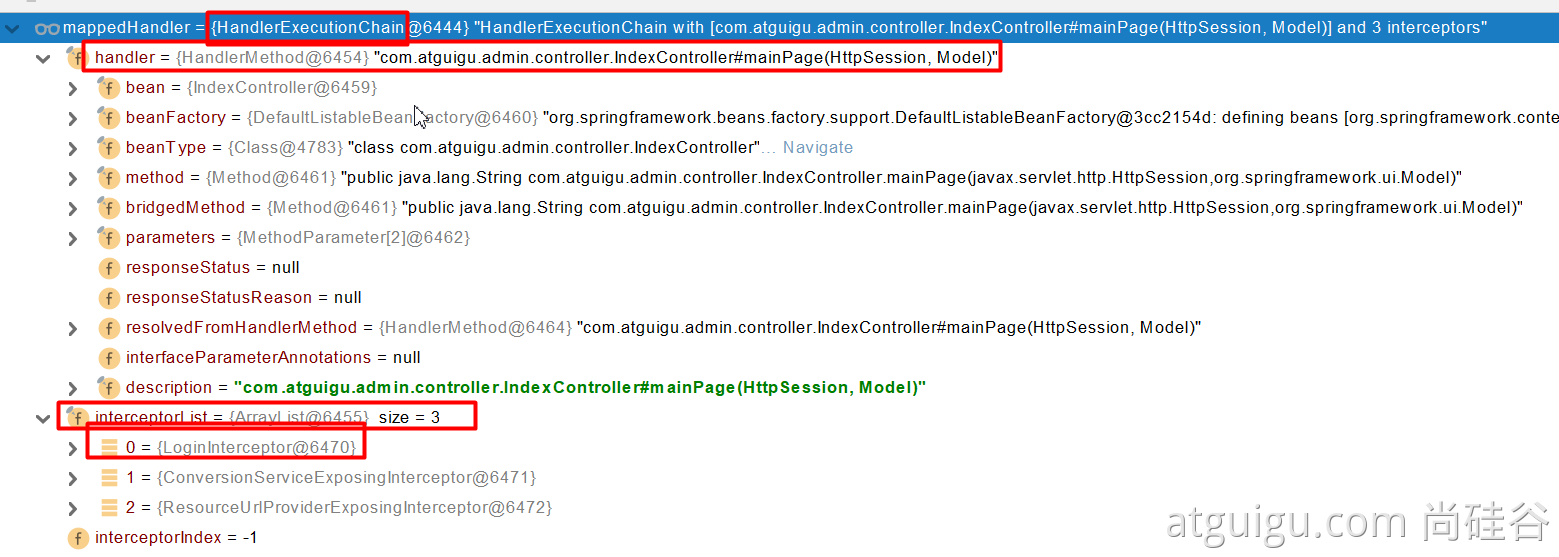
-
先来顺序执行所有拦截器的
preHandle方法;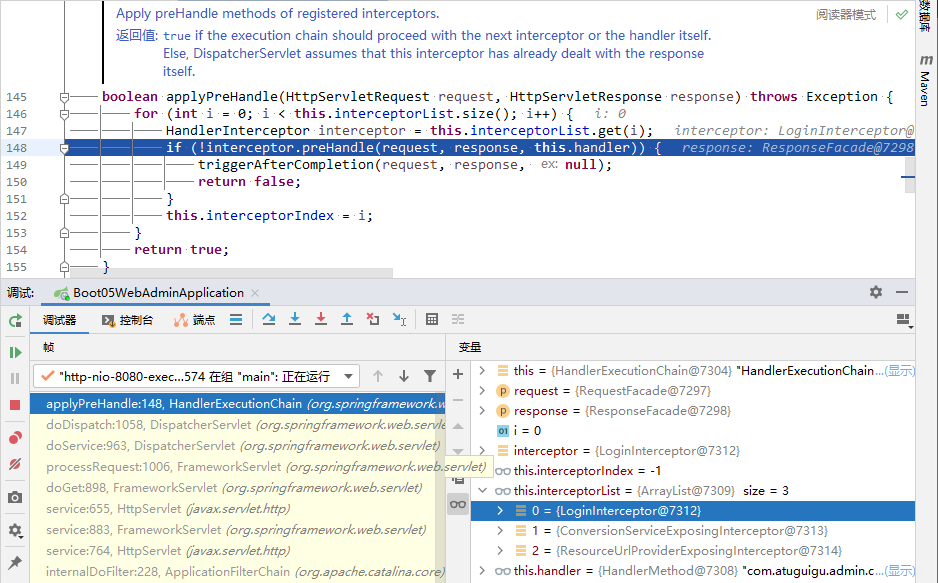
- 如果当前拦截器
prehandler返回true,则执行下一个拦截器的preHandle; - 如果当前拦截器
prehandler返回false,直接倒序触发所有已经执行了的拦截器的afterCompletion;
-
如果任何一个拦截器返回
false,直接跳出,不执行目标方法; -
如果所有拦截器都返回
true,执行目标方法; -
倒序执行所有拦截器的
postHandle方法; -
前面的步骤有任何异常,都会直接倒序触发
afterCompletion; -
页面成功渲染完成以后,也会倒序触发
afterCompletion。
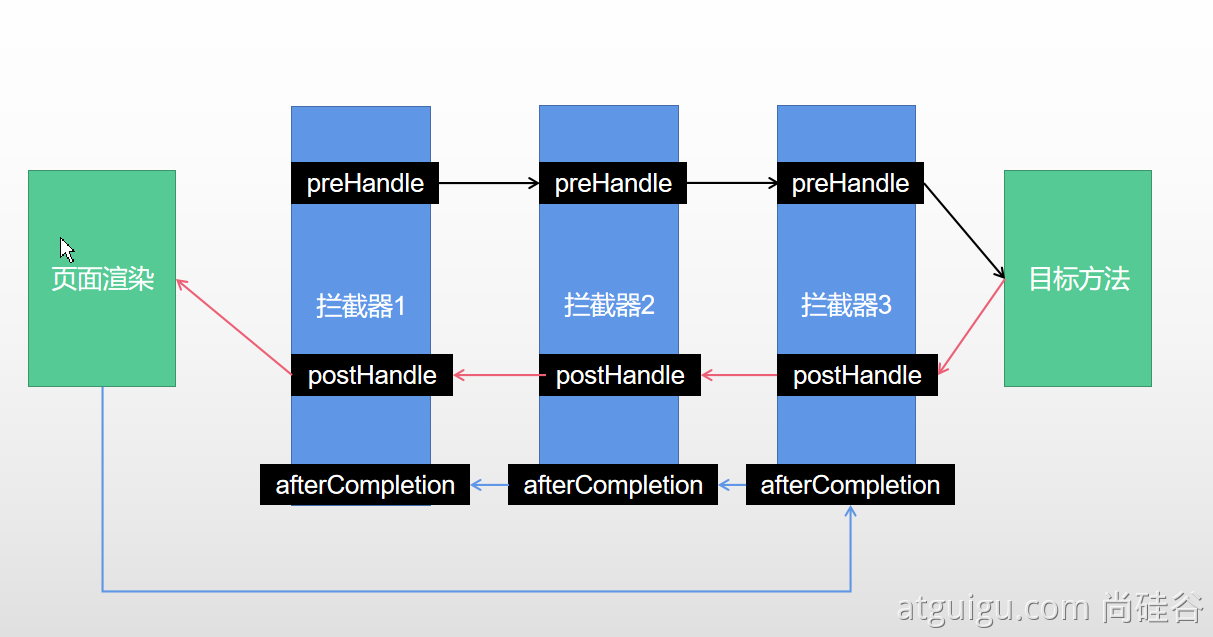
9、文件上传
一个文件上传的过程如下图所示:

- 浏览器发起 HTTP POST 请求,指定请求头:
Content-Type: multipart/form-data - 服务端解析请求内容,执行文件保存处理,返回成功消息。
参考:文件上传原理
9.1 页面表单
<form method="post" action="/upload" enctype="multipart/form-data">
<input type="file" name="file"><br>
<input type="submit" value="提交">
</form>
9.2 限制上传文件大小
spring:
servlet:
multipart:
max-file-size: 10MB # 单个上传文件大小上限
max-request-size: 100MB # 一次请求上传所有文件大小上限
9.3 文件上传代码
// MultipartFile 自动封装上传过来的文件
@PostMapping("/upload")
public String upload(@RequestParam("email") String email,
@RequestParam("username") String username,
@RequestPart("headerImg") MultipartFile headerImg,
@RequestPart("photos") MultipartFile[] photos) throws IOException {
log.info("上传的信息:email={},username={},headerImg={},photos={}",
email, username, headerImg.getSize(), photos.length);
if(!headerImg.isEmpty()){
// 保存到文件服务器,OSS服务器
String originalFilename = headerImg.getOriginalFilename();
headerImg.transferTo(new File("D:\\cache\\"+originalFilename));
}
if(photos.length > 0){
for (MultipartFile photo : photos) {
if(!photo.isEmpty()){
String originalFilename = photo.getOriginalFilename();
photo.transferTo(new File("D:\\cache\\" + originalFilename));
}
}
}
return "main";
}
9.4 自动配置原理
文件上传自动配置类 MultipartAutoConfiguration 自动配置好了文件上传解析器 StandardServletMultipartResolver(使用 Servlet 所提供的功能支持,不需要依赖任何其他的项目) 。
原理步骤:
-
request请求进来使用文件上传解析器判断(isMultipart(request)并封装(resolveMultipart(request)),返回(MultipartHttpServletRequest)文件上传请求; -
参数解析器
RequestPartMethodArgumentResolver来解析请求中的文件内容并封装成MultipartFile(上传文件的详细信息,如原始文件名、内容类型、大小等等); -
将
request中的文件信息封装为一个MultiValueMap<String, MultipartFile>; -
遍历
MultiValueMap对于每一个MultipartFile调用FileCopyUtils.copy()实现文件流的拷贝。
10、异常处理
10.1 默认规则
默认情况下,SpringBoot 提供 /error 处理所有错误的映射。
-
对于浏览器客户端,响应一个 Whitelabel 错误页面(因为浏览器请求头的 Accept 字段默认以 text/html 开头),中包含错误,HTTP 状态和异常消息的详细信息;

-
对于其他客户端(如 Postman),它将生成 json 响应。
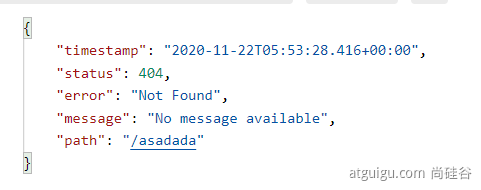
要对其进行自定义,添加 View 解析为 error
要完全替换默认行为,可以实现 ErrorController 并注册该类型的 Bean 定义,或添加 ErrorAttributes 类型的组件以使用现有机制但替换其内容。
10.2 定制异常处理逻辑
error/404.html、error/5xx.html:有精确的错误状态码页面就匹配精确,没有就找 4xx.html,如果都没有就触发白页。
自定义错误页:
-
@ControllerAdvice+@ExceptionHandler处理全局异常,底层是ExceptionHandlerExceptionResolver支持的。 -
自定义实现
HandlerExceptionResolver处理异常,可以作为默认的全局异常处理规则。
-
ErrorViewResolver实现自定义异常处理。
- 自己调用
response.sendError(statusCode, resolvedReason),error 请求就会转给BasicErrorController。 - 如果自己没有调用,并且异常没有处理器能处理,Tomcat 底层调用
response.sendError(statusCode, resolvedReason),error 请求就会转给BasicErrorController。 BasicErrorController要去的页面地址是ErrorViewResolver。
-
@ResponseStatus+ 自定义异常底层是
ResponseStatusExceptionResolver,被ResponseStatus注解的元素会使Tomcat 底层调用response.sendError(statusCode, resolvedReason)。response.sendError(HttpServletResponse.SC_BAD_REQUEST, ex.getMessage());
10.3 异常处理自动配置原理
-
ErrorMvcAutoConfiguration自动配置异常处理规则。-
定义错误页面属性:组件类型为
DefaultErrorAttributes,组件 ID 为errorAttributes。public class DefaultErrorAttributes implements ErrorAttributes, HandlerExceptionResolver。
-
定义页面跳转逻辑:组件类型为
BasicErrorController,组件 ID 为basicErrorController(json + 白页 适配响应)。-
处理默认 /error 路径的请求,页面响应
new ModelAndView("error", model)。@Controller @RequestMapping("${server.error.path:${error.path:/error}}") public class BasicErrorController extends AbstractErrorController { // 产生 html 类型的数据,浏览器发送的请求来到这个方法处理 @RequestMapping(produces = "text/html") public ModelAndView errorHtml(HttpServletRequest request, HttpServletResponse response) { HttpStatus status = getStatus(request); Map<String, Object> model = Collections.unmodifiableMap(getErrorAttributes( request, isIncludeStackTrace(request, MediaType.TEXT_HTML))); response.setStatus(status.value()); // 去哪个页面作为错误页面,包含页面地址和页面内容 ModelAndView modelAndView = resolveErrorView(request, response, status, model); return (modelAndView == null ? new ModelAndView("error", model) : modelAndView); } // 产生 json 数据,其他客户端来到这个方法处理 @RequestMapping @ResponseBody public ResponseEntity<Map<String, Object>> error(HttpServletRequest request) { Map<String, Object> body = getErrorAttributes(request, isIncludeStackTrace(request, MediaType.ALL)); HttpStatus status = getStatus(request); return new ResponseEntity<Map<String, Object>>(body, status); } -
容器中有组件
View,组件 ID 为error(响应默认错误页) -
容器中放组件
BeanNameViewResolver(视图解析器),按照返回的视图名作为组件 ID 去容器中找View对象。
-
-
定义错误页面 html 路径:类型为
DefaultErrorViewResolver,组件 ID 为conventionErrorViewResolver。- 如果发生错误,会以 HTTP 状态码作为视图页地址(
viewName),找到真正的页面。 - error/404.html、error/5xx.html。
- 如果发生错误,会以 HTTP 状态码作为视图页地址(
-
10.4 异常处理流程
-
执行目标方法,目标方法运行期间有任何异常都会被
catch捕捉,而且标志当前请求结束,并且将异常赋值给dispatchException。 -
进入视图解析流程:
processDispatchResult(processedRequest, response, mappedHandler, mv, dispatchException); -
mv = processHandlerException处理 handler 发生的异常,处理完成返回ModelAndView。-
遍历所有的
handlerExceptionResolvers处理器异常解析器,看谁能处理当前异常。 -
系统默认的异常解析器:
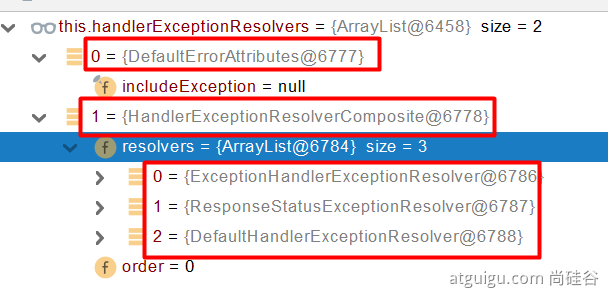
DefaultErrorAttributes先来处理异常,把异常信息保存到 request 域,并且返回null;- 然后交由
HandlerExceptionResolverComposite,遍历其中的异常处理器,默认没有处理器能处理异常,所以异常会被抛出。- 如果异常没有处理器能处理,最终 Tomcat 底层 就会发送
/error请求,会被底层的BasicErrorController处理。 - 解析错误视图:遍历所有的
ErrorViewResolver看谁能解析。 - 默认的
DefaultErrorViewResolver,作用是把响应状态码作为错误页的地址,error/500.html 。 - 模板引擎最终响应这个页面 error/500.html。
- 如果异常没有处理器能处理,最终 Tomcat 底层 就会发送
-
11、Web 原生组件注入(Servlet、Filter、Listener)
11.1 使用 Servlet API
@ServletComponentScan(basePackages = "com.atguigu.admin"):指定原生Servlet组件都放在哪里。@WebServlet(urlPatterns = "/my"):效果,直接响应,没有经过 Spring 的拦截器?@WebFilter(urlPatterns={"/css/*", "/images/*"}):过滤 css、images 静态资源。@WebListener:监听器。
扩展:DispatchServlet 如何注册进来?
-
容器中自动配置了
DispatcherServlet属性绑定到WebMvcProperties,对应的配置文件配置项是spring.mvc。 -
通过
ServletRegistrationBean<DispatcherServlet>把DispatcherServlet配置进来。 -
默认映射的是
/路径。
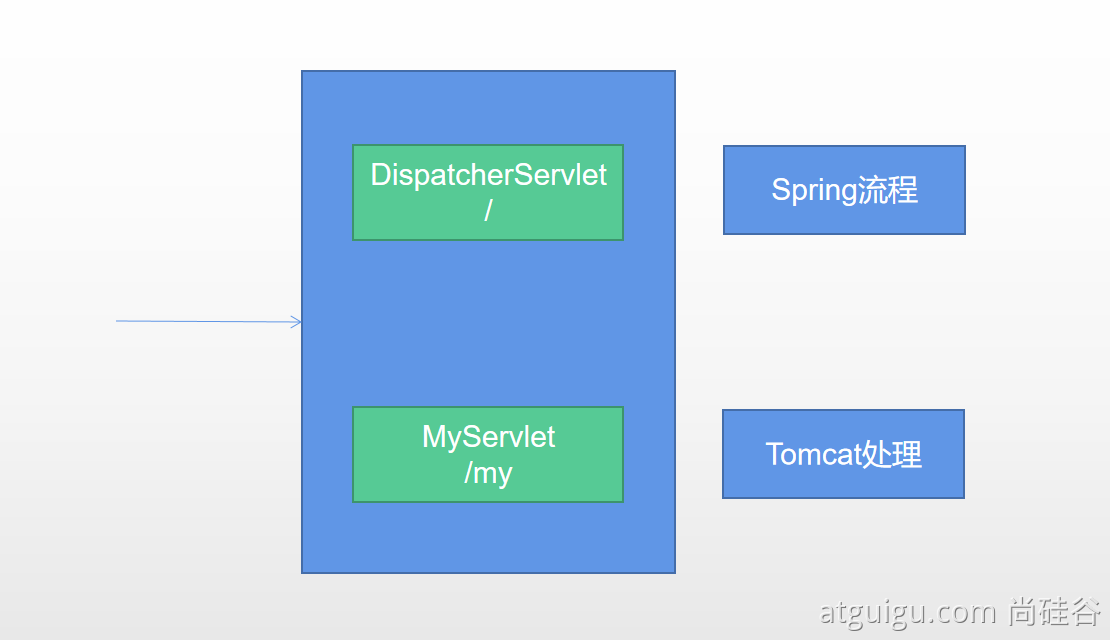
多个 Servlet 都能处理到同一层路径,精确优选原则:
A: /my/
B: /my/1 优先
11.2 使用 RegistrationBean
ServletRegistrationBean, FilterRegistrationBean, and ServletListenerRegistrationBean
@Configuration
public class MyRegistConfig {
@Bean
public ServletRegistrationBean myServlet(){
MyServlet myServlet = new MyServlet();
return new ServletRegistrationBean(myServlet,"/my","/my02");
}
@Bean
public FilterRegistrationBean myFilter(){
MyFilter myFilter = new MyFilter();
// return new FilterRegistrationBean(myFilter,myServlet());
FilterRegistrationBean filterRegistrationBean = new FilterRegistrationBean(myFilter);
filterRegistrationBean.setUrlPatterns(Arrays.asList("/my","/css/*"));
return filterRegistrationBean;
}
@Bean
public ServletListenerRegistrationBean myListener(){
MySwervletContextListener mySwervletContextListener = new MySwervletContextListener();
return new ServletListenerRegistrationBean(mySwervletContextListener);
}
}
12、配置 Servlet 容器
12.1 切换嵌入式Servlet容器
SpringBoot 内置的 WebServer:Tomcat(默认), Jetty, or Undertow。

ServletWebServerApplicationContext 容器启动寻找 ServletWebServerFactory 并引导创建服务器。
切换服务器:在 pom.xml 中排除 Tomcat 依赖,再将目标服务器的 starter 导入即可。
<dependency>
<groupId>org.springframework.boot</groupId>
<artifactId>spring-boot-starter-web</artifactId>
<exclusions>
<exclusion>
<groupId>org.springframework.boot</groupId>
<artifactId>spring-boot-starter-tomcat</artifactId>
</exclusion>
</exclusions>
</dependency>
原理:
SpringBoot 应用启动发现当前是 Web 应用,web-starter 自动导入Tomcat:
-
Web 应用会创建一个 Web 版的
IoC容器ServletWebServerApplicationContext -
ServletWebServerApplicationContext启动的时候寻找ServletWebServerFactory(Servlet的 Web 服务器工厂 --->Servlet的 Web 服务器);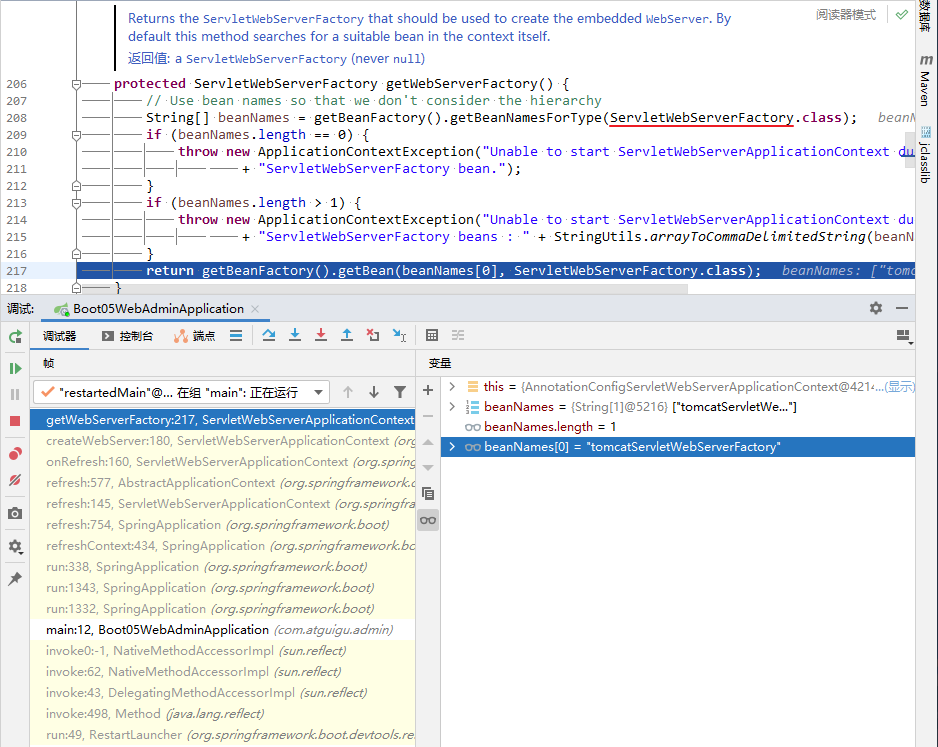
-
SpringBoot 底层默认有很多的 WebServer 工厂:
TomcatServletWebServerFactory,JettyServletWebServerFactory, orUndertowServletWebServerFactory; -
底层直接会有一个 WebServer 工厂自动配置类:
ServletWebServerFactoryAutoConfiguration; -
WebServer 工厂自动配置类
ServletWebServerFactoryAutoConfiguration导入了ServletWebServerFactoryConfiguration配置类; -
ServletWebServerFactoryConfiguration配置类动态判断系统中到底导入了哪个 Web 服务器的包,web-starter默认是导入 Tomcat 包,容器中就有TomcatServletWebServerFactory; -
TomcatServletWebServerFactory创建 Tomcat 对象,然后将 Tomcat 对象传递给TomcatWebServer,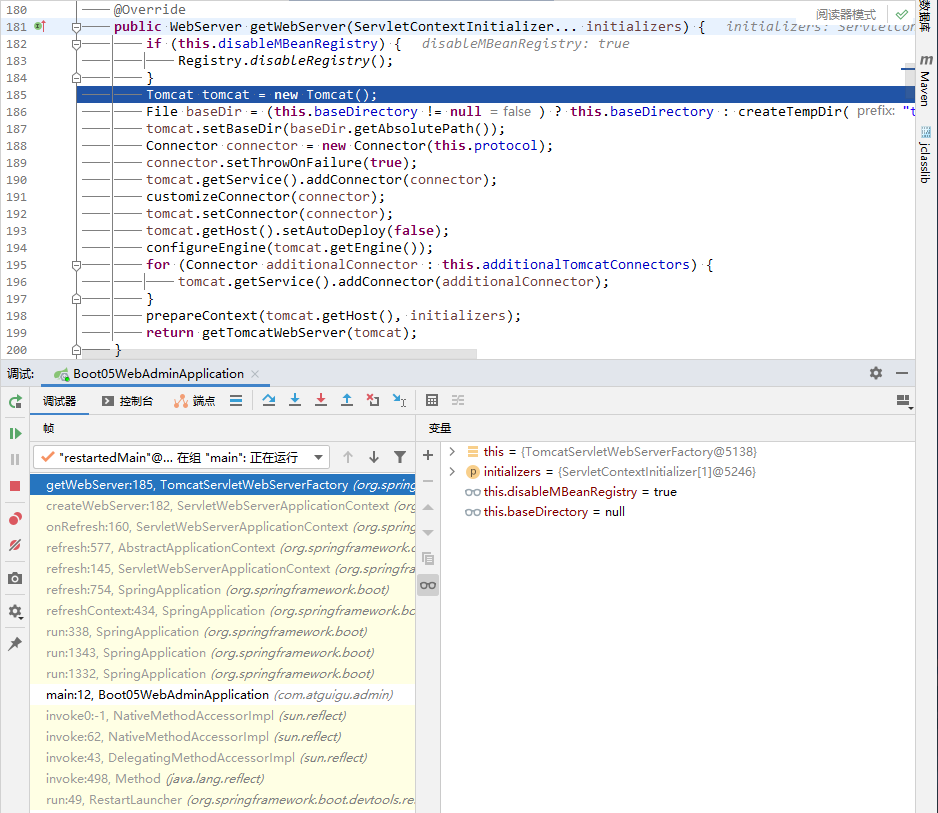
TomcatWebServer的构造器拥有初始化方法initialize(),使用this.tomcat.start();启动 Tomcat(只要 Tomcat 核心 jar 包存在,内嵌服务器就是手动把启动服务器的代码调用)。
12.2 定制 Servlet 容器
- 在 application.properties 中修改和 server 有关的配置(
ServerProperties提供);
server.port=8081
server.context-path=/crud
server.tomcat.uri-encoding=UTF‐8
# 通用的 Servlet 容器设置
server.xxx
# Tomcat 的设置
server.tomcat.xxx
-
实现
WebServerFactoryCustomizer<ConfigurableServletWebServerFactory>-
把配置文件的值和
ServletWebServerFactory进行绑定;@Component public class CustomizationBean implements WebServerFactoryCustomizer<ConfigurableServletWebServerFactory> { @Override public void customize(ConfigurableServletWebServerFactory server) { server.setPort(9000); } }
-
-
直接自定义
ConfigurableServletWebServerFactory@Bean public WebServerFactoryCustomizer configWebServer(){ WebServerFactoryCustomizer webServerFactoryCustomizer = new WebServerFactoryCustomizer<ConfigurableServletWebServerFactory>() { @Override public void customize(ConfigurableServletWebServerFactory factory) { factory.setPort(9000); } }; return webServerFactoryCustomizer; }
六、Docker
1、简介
Docker 是一个开源的应用容器引擎,是一个轻量级容器技术。
Docker 支持将软件编译成一个镜像,然后在镜像中各种软件做好配置,将镜像发布出去,其他使用者可以直接使用这个镜像。
运行中的这个镜像称为容器,容器启动是非常快速的。

Windows 系统镜像与 Docker 镜像:
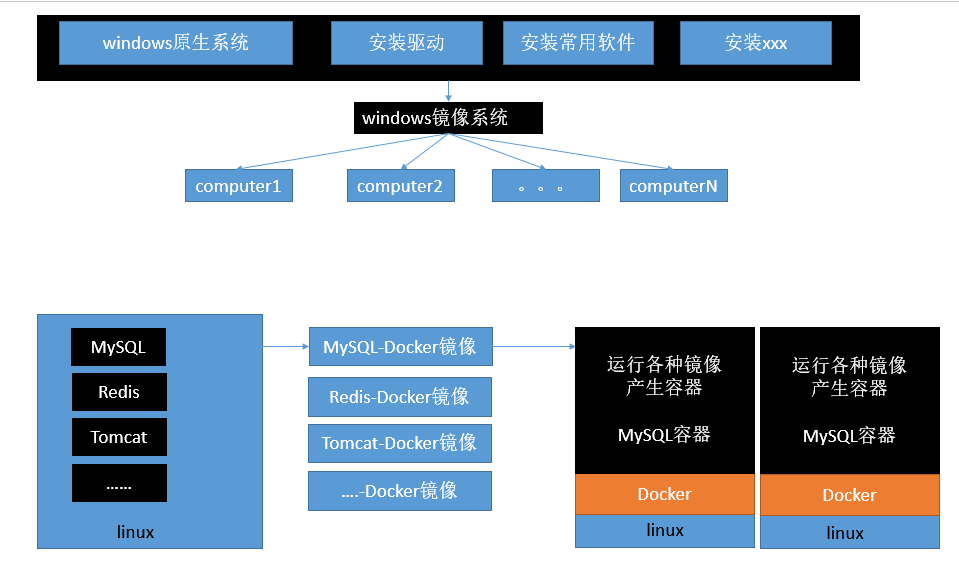
2、核心概念
-
主机(Host):安装了 Docker 程序的机器(Docker 直接安装在 Linux 或 Windows 操作系统之上)。
-
客户端(Client):连接 Docker 主机进行操作。
-
仓库(Registry):用来保存各种打包好的软件镜像。
-
镜像(Images):软件打包好的镜像,放在 Docker 仓库中。
-
容器(Container):镜像启动后的实例称为一个容器,容器是独立运行的一个或一组应用。
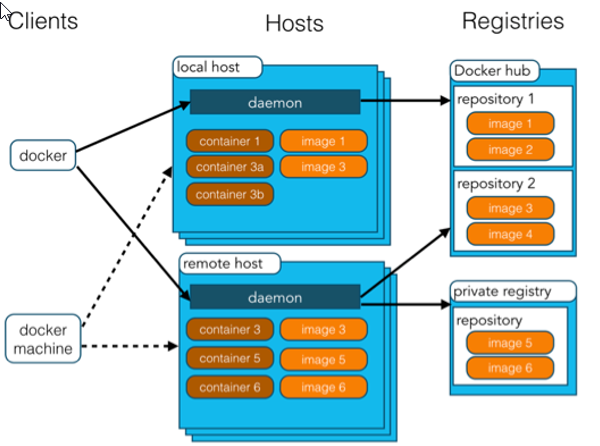
使用 Docker 的步骤:
-
安装 Docker;
-
去 Docker 仓库获取软件对应的镜像;
-
使用 Docker 运行这个镜像,这个镜像就会生成一个 Docker 容器;
-
停止 Docker 容器就是停止软件。
3、安装Docker
3.1 安装 WSL2 版 Linux
3.2 Linux 上安装 Docker
4、Docker 常用命令
4.1 镜像操作
| 操作 | 命令 | 说明 |
|---|---|---|
| 检索 | docker search 镜像名 |
我们经常去 Docker Hub 上检索镜像的详细信息,如镜像的 tag 标签。 |
| 拉取 | docker pull 镜像名:tag |
:tag 是可选的,tag 多为软件的版本,默认是 latest 最新版。 |
| 列表 | docker images |
查看所有本地镜像。 |
| 删除 | docker rmi 容器ID |
删除指定的本地镜像。 |
4.2 容器操作
软件镜像(QQ 安装程序)-> 运行镜像(双击 QQ 图标) -> 产生一个容器(正在运行的软件,如运行的 QQ)。
步骤:
-
搜索镜像
[root@localhost ~]# docker search tomcat -
拉取镜像
[root@localhost ~]# docker pull tomcat -
根据镜像启动容器
[root@localhost ~]# docker run --name myTomcat -d tomcat:latest -
查看运行中的容器
[root@localhost ~]# docker ps -
停止运行中的容器
[root@localhost ~]# docker stop 容器ID
-
查看所有的容器
[root@localhost ~]# docker ps -a -
启动容器
[root@localhost ~]# docker start 容器ID -
删除一个容器
[root@localhost ~]# docker rm 容器ID -
启动一个做了端口映射的 Tomcat
[root@localhost ~]# docker run -d -p 8888:8080 tomcat-d:后台运行-p:将主机的端口映射到容器的端口,主机的端口:容器的端口
-
为了演示简单关闭了
Linux的防火墙- 查看防火墙状态:
[root@localhost ~]# service firewalld status- 关闭防火墙
[root@localhost ~]# service firewalld stop -
查看容器的日志
[root@localhost ~]# docker logs container-name/container-id
更多命令参考:https://docs.docker.com/engine/reference/commandline/docker/
还可以参考每一个镜像的文档。
4.3 安装 MySQL
拉取镜像
[root@localhost ~]# docker pull mysql
错误的启动:
[root@localhost ~]# docker run --name mysql01 -d mysql
42f09819908bb72dd99ae19e792e0a5d03c48638421fa64cce5f8ba0f40f5846
# MySQL 退出了
[root@localhost ~]# docker ps -a
CONTAINER ID IMAGE COMMAND CREATED STATUS PORTS NAMES
42f09819908b mysql "docker-entrypoint.sh" 34 seconds ago Exited (1) 33 seconds ago mysql01
538bde63e500 tomcat "catalina.sh run" About an hour ago Exited (143) About an hour ago compassionate_
goldstine
c4f1ac60b3fc tomcat "catalina.sh run" About an hour ago Exited (143) About an hour ago lonely_fermi
81ec743a5271 tomcat "catalina.sh run" About an hour ago Exited (143) About an hour ago sick_ramanujan
# 根据容器 ID 查看错误日志,下面三个参数必须指定一个
[root@localhost ~]# docker logs 42f09819908b
error: database is uninitialized and password option is not specified
You need to specify one of MYSQL_ROOT_PASSWORD, MYSQL_ALLOW_EMPTY_PASSWORD and MYSQL_RANDOM_ROOT_PASSWORD。
正确的启动:
[root@localhost ~]# docker run --name mysql01 -e MYSQL_ROOT_PASSWORD=123456 -d mysql
b874c56bec49fb43024b3805ab51e9097da779f2f572c22c695305dedd684c5f
[root@localhost ~]# docker ps
CONTAINER ID IMAGE COMMAND CREATED STATUS PORTS NAMES
b874c56bec49 mysql "docker-entrypoint.sh" 4 seconds ago Up 3 seconds 3306/tcp mysql01
端口映射,将主机的端口映射到容器的端口:
[root@localhost ~]# docker run -p 3306:3306 --name mysql02 -e MYSQL_ROOT_PASSWORD=123456 -d mysql
ad10e4bc5c6a0f61cbad43898de71d366117d120e39db651844c0e73863b9434
[root@localhost ~]# docker ps
CONTAINER ID IMAGE COMMAND CREATED STATUS PORTS NAMES
ad10e4bc5c6a mysql "docker-entrypoint.sh" 4 seconds ago Up 2 seconds 0.0.0.0:3306->3306/tcp mysql02
远程 MySQL 连接不上的解决方法:
[root@localhost ~]# docker run -p 3306:3306 --name mysql01 -e MYSQL_ROOT_PASSWORD=123456 -d mysql
18e7e4fc89685c1fb8fac0c999d41f67bcd1c993b6597b1ecd514a121e132c5b
[root@localhost ~]# docker exec -it mysql01 bash
root@18e7e4fc8968:/# mysql -u root -p
Enter password:
Welcome to the MySQL monitor. Commands end with ; or \g.
Your MySQL connection id is 8
Server version: 8.0.19 MySQL Community Server - GPL
Copyright (c) 2000, 2020, Oracle and/or its affiliates. All rights reserved.
Oracle is a registered trademark of Oracle Corporation and/or its
affiliates. Other names may be trademarks of their respective
owners.
Type 'help;' or '\h' for help. Type '\c' to clear the current input statement.
mysql> alter user 'root'@'%' identified with mysql_native_password by 'test1234';
Query OK, 0 rows affected (0.02 sec)
mysql> flush privileges;
Query OK, 0 rows affected (0.00 sec)
# Ctrl+D退出
挂载文件夹:
[root@localhost ~]# docker run --name mysql03 -v /conf/mysql:/etc/mysql/conf.d -e MYSQL_ROOT_PASSWORD=my-secret-pw -d mysql:tag
把主机的 /conf/mysql 文件夹挂载到容器的 /etc/mysql/conf.d 文件夹里面。
修改 MySQL 的配置文件就只需要把 MySQL 配置文件放在主机的 /conf/mysql 文件夹下)。
指定 MySQL 的一些配置参数:
[root@localhost ~]# docker run --name some-mysql -e MYSQL_ROOT_PASSWORD=my-secret-pw -d mysql:tag --character-set-server=utf8mb4 --collation-server=utf8mb4_unicode_ci
4.4 安装 Redis
七、数据访问
1、SQL
1.1 数据源的自动配置
SpringBoot 默认是用 HikariDataSource 数据源(数据库连接池)。
1.1.1 导入 JDBC 场景
<dependency>
<groupId>org.springframework.boot</groupId>
<artifactId>spring-boot-starter-data-jdbc</artifactId>
</dependency>
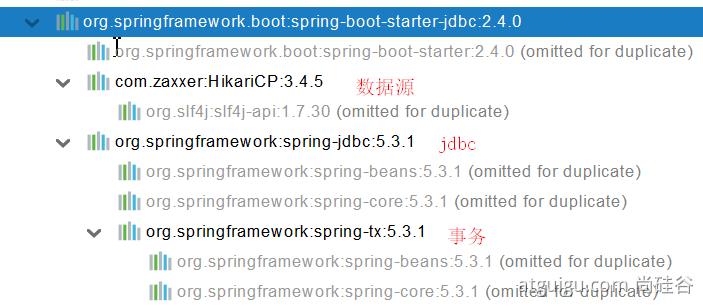
为什么需要显式导入 JDBC 场景,官方不导入数据库驱动?因为官方不知道我们接下要操作什么数据库。
数据库版本和驱动版本对应:
<dependency>
<groupId>mysql</groupId>
<artifactId>mysql-connector-java</artifactId>
<version>5.1.49</version>
</dependency>
<!-- 想要修改版本
1、直接依赖引入具体版本(Maven 的就近依赖原则)
2、重新声明版本(Maven 的属性的就近优先原则) -->
<properties>
<java.version>1.8</java.version>
<mysql.version>5.1.49</mysql.version>
</properties>
1.1.2 分析自动配置
自动配置的类:
DataSourceAutoConfiguration: 数据源的自动配置;- 修改数据源相关的配置:spring.datasource;
- 数据库连接池的配置,是容器中没有
DataSource才自动配置的; - 底层配置好的数据库连接池是:HikariDataSource。
@Configuration(proxyBeanMethods = false)
@Conditional(PooledDataSourceCondition.class)
@ConditionalOnMissingBean({ DataSource.class, XADataSource.class })
@Import({ DataSourceConfiguration.Hikari.class, DataSourceConfiguration.Tomcat.class,
DataSourceConfiguration.Dbcp2.class, DataSourceConfiguration.OracleUcp.class,
DataSourceConfiguration.Generic.class, DataSourceJmxConfiguration.class })
protected static class PooledDataSourceConfiguration
-
JdbcTemplateAutoConfiguration:JdbcTemplate的自动配置,可以来对数据库进行 CRUD;- 可以修改这个配置项
@ConfigurationProperties(prefix = "spring.jdbc")来修改JdbcTemplate; @Bean、@Primary修饰JdbcTemplate,从容器中获取这个组件。
- 可以修改这个配置项
-
JndiDataSourceAutoConfiguration: JNDI 的自动配置; -
DataSourceTransactionManagerAutoConfiguration: 事务管理器的自动配置; -
XADataSourceAutoConfiguration: 分布式事务相关的自动配置。
1.1.3 修改配置项
spring:
datasource:
url: jdbc:mysql://localhost:3306/db_account?serverTimezone=GMT%2B8
username: root
password: 123456
driver-class-name: com.mysql.cj.jdbc.Driver
1.1.4 测试
@Slf4j
@SpringBootTest
class Boot05WebAdminApplicationTests {
@Autowired
JdbcTemplate jdbcTemplate;
@Test
void contextLoads() {
Long aLong = jdbcTemplate.queryForObject("select count(*) from account_tbl", Long.class);
log.info("记录总数:{}",aLong);
}
}
1.2 使用 Druid 数据源
1.2.1 Druid 官方 Github 地址
https://github.com/alibaba/druid
整合第三方技术的两种方式
- 自定义;
- 使用官方 starter。
1.2.2 自定义方式
1、创建数据源
这种方式可能无法使用。
<!-- pom.xml -->
<dependency>
<groupId>com.alibaba</groupId>
<artifactId>druid</artifactId>
<version>1.1.17</version>
</dependency>
<!-- bean.xml -->
<bean id="dataSource" class="com.alibaba.druid.pool.DruidDataSource"
destroy-method="close">
<property name="url" value="${jdbc.url}" />
<property name="username" value="${jdbc.username}" />
<property name="password" value="${jdbc.password}" />
<property name="maxActive" value="20" />
<property name="initialSize" value="1" />
<property name="maxWait" value="60000" />
<property name="minIdle" value="1" />
<property name="timeBetweenEvictionRunsMillis" value="60000" />
<property name="minEvictableIdleTimeMillis" value="300000" />
<property name="testWhileIdle" value="true" />
<property name="testOnBorrow" value="false" />
<property name="testOnReturn" value="false" />
<property name="poolPreparedStatements" value="true" />
<property name="maxOpenPreparedStatements" value="20" />
Spring Boot 2.5.2 版本导入 druid 1.1.17 依赖之后并不能使用监控功能,使用相同版本的 druid-spring-boot-starter 之后可以使用监控功能。
2、StatViewServlet
用途:
- 提供监控信息展示的 HTML 页面;
- 提供监控信息的 JSON API。
<servlet>
<servlet-name>DruidStatView</servlet-name>
<servlet-class>com.alibaba.druid.support.http.StatViewServlet</servlet-class>
</servlet>
<servlet-mapping>
<servlet-name>DruidStatView</servlet-name>
<url-pattern>/druid/*</url-pattern>
</servlet-mapping>
3、StatFilter
用于统计监控信息:如 SQL 监控、URI 监控。
需要给数据源中配置如下属性,可以允许多个 Filter,多个用 , 分割;如:
<property name="filters" value="stat, slf4j" />
系统中的 Filter:
| 别名 | Filter 类名 |
|---|---|
| default | com.alibaba.druid.filter.stat.StatFilter |
| stat | com.alibaba.druid.filter.stat.StatFilter |
| mergeStat | com.alibaba.druid.filter.stat.MergeStatFilter |
| encoding | com.alibaba.druid.filter.encoding.EncodingConvertFilter |
| log4j | com.alibaba.druid.filter.logging.Log4jFilter |
| log4j2 | com.alibaba.druid.filter.logging.Log4j2Filter |
| slf4j | com.alibaba.druid.filter.logging.Slf4jLogFilter |
| commonlogging | com.alibaba.druid.filter.logging.CommonsLogFilter |
使用 slowSqlMillis 定义慢 SQL 的时长:
<bean id="stat-filter" class="com.alibaba.druid.filter.stat.StatFilter">
<property name="slowSqlMillis" value="10000" />
<property name="logSlowSql" value="true" />
</bean>
1.2.3 使用官方 starter 方式
1、引入 druid-starter
<dependency>
<groupId>com.alibaba</groupId>
<artifactId>druid-spring-boot-starter</artifactId>
<version>1.1.17</version>
</dependency>
2、分析自动配置
-
扩展配置项 spring.datasource.druid
-
DruidSpringAopConfiguration.class, 监控 Bean 的配置项:spring.datasource.druid.aop-patterns -
DruidStatViewServletConfiguration.class,默认开启监控页的配置:spring.datasource.druid.stat-view-servlet -
DruidWebStatFilterConfiguration.class,默认开启 Web 监控配置;spring.datasource.druid.web-stat-filter -
DruidFilterConfiguration.class,所有 Druid 自己 Filter 的配置。
private static final String FILTER_STAT_PREFIX = "spring.datasource.druid.filter.stat";
private static final String FILTER_CONFIG_PREFIX = "spring.datasource.druid.filter.config";
private static final String FILTER_ENCODING_PREFIX = "spring.datasource.druid.filter.encoding";
private static final String FILTER_SLF4J_PREFIX = "spring.datasource.druid.filter.slf4j";
private static final String FILTER_LOG4J_PREFIX = "spring.datasource.druid.filter.log4j";
private static final String FILTER_LOG4J2_PREFIX = "spring.datasource.druid.filter.log4j2";
private static final String FILTER_COMMONS_LOG_PREFIX = "spring.datasource.druid.filter.commons-log";
private static final String FILTER_WALL_PREFIX = "spring.datasource.druid.filter.wall";
3、配置示例
spring:
datasource:
url: jdbc:mysql://localhost:3306/db_account?serverTimezone=GMT%2B8
username: root
password: 123456
driver-class-name: com.mysql.cj.jdbc.Driver
druid:
aop-patterns: com.atguigu.admin.* # 监控 Bean
filters: stat,wall # 底层开启功能:stat(sql 监控),wall(防火墙)
stat-view-servlet: # 配置监控页功能
enabled: true
login-username: admin
login-password: admin
resetEnable: false
web-stat-filter: # Web 监控
enabled: true
urlPattern: /*
exclusions: '*.js,*.gif,*.jpg,*.png,*.css,*.ico,/druid/*'
filter:
stat: # 对上面 filters 里面的 stat 的详细配置
slow-sql-millis: 1000
logSlowSql: true
enabled: true
wall:
enabled: true
config:
drop-table-allow: false
SpringBoot 配置示例:
https://github.com/alibaba/druid/tree/master/druid-spring-boot-starter
1.3 整合 MyBatis 操作
引入 MyBatis 的官方 starter:
<dependency>
<groupId>org.mybatis.spring.boot</groupId>
<artifactId>mybatis-spring-boot-starter</artifactId>
<version>2.1.4</version>
</dependency>

1.3.1 配置模式
-
配置 MyBatis 的配置文件,SqlMapConfig.xml(名称不固定);
-
通过配置文件,加载 MyBatis 运行环境,创建
SqlSessionFactory会话工厂,SqlSessionFactory使用单例方式; -
通过
SqlSessionFactory创建SqlSession,SqlSession是一个面向用户的接口(提供操作数据库方法),实现对象是线程不安全的,建议sqlSession应用在方法体内; -
调用
sqlSession的方法去操作数据,如果需要提交事务,需要执行sqlSession的commit()方法; -
释放资源,关闭
sqlSession;
自动配置类:
// 表示这是一个 Spring 配置类
@Configuration
// SqlSessionFactory 和 SqlSessionFactoryBean 存在时才生效
@ConditionalOnClass({SqlSessionFactory.class, SqlSessionFactoryBean.class})
// DataSource 的 Canidate 注册到 Spring 容器中时才生效
@ConditionalOnSingleCandidate(DataSource.class)
// 使 MybatisProperties 注解类生效
@EnableConfigurationProperties({MybatisProperties.class})
// 在 DataSourceAutoConfiguration 和 MybatisLanguageDriverAutoConfiguration 自动配置之后执行
@AutoConfigureAfter({DataSourceAutoConfiguration.class, MybatisLanguageDriverAutoConfiguration.class})
public class MybatisAutoConfiguration implements InitializingBean {
@ConfigurationProperties(prefix = "mybatis")
public class MybatisProperties
-
@Import(AutoConfiguredMapperScannerRegistrar.class); -
Mapper: 我们只要写操作MyBatis的接口,@Mapper就会被自动扫描进来。
修改配置文件:
mybatis:
config-location: classpath:mybatis/mybatis-config.xml # 全局配置文件位置
mapper-locations: classpath:mybatis/mapper/*.xml # sql 映射文件位置
Mapper 接口绑定 xml:
<?xml version="1.0" encoding="UTF-8" ?>
<!DOCTYPE mapper
PUBLIC "-//mybatis.org//DTD Mapper 3.0//EN"
"http://mybatis.org/dtd/mybatis-3-mapper.dtd">
<mapper namespace="com.atguigu.admin.mapper.AccountMapper">
<!-- public Account getAcct(Long id); -->
<select id="getAcct" resultType="com.atguigu.admin.bean.Account">
select * from account_tbl where id = #{id}
</select>
</mapper>
配置 MyBatis 规则:
mybatis:
# config-location: classpath:mybatis/mybatis-config.xml
mapper-locations: classpath:mybatis/mapper/*.xml
configuration:
map-underscore-to-camel-case: true
步骤:
- 导入 MyBatis 官方 starter;
- 编写
Mapper接口,标准@Mapper注解; - 编写 sql 映射文件并绑定
Mapper接口; - 在 **application.yaml **中指定
Mapper配置文件的位置,以及指定全局配置文件的信息 (建议配置在 mybatis.configuration)。
1.3.2 注解模式
@Mapper
public interface CityMapper {
@Select("select * from city where id=#{id}")
public City getById(Long id);
public void insert(City city);
}
1.3.3 混合模式
@Mapper
public interface CityMapper {
@Select("select * from city where id=#{id}")
public City getById(Long id);
public void insert(City city);
}
1.3.4 最佳实践
- 引入 mybatis-starter;
- 配置 application.yaml 中,指定 mapper-location 位置即可;
- 编写
Mapper接口并标注@Mapper注解; - 简单方法直接注解方式;
- 复杂方法编写 mapper.xml 进行绑定映射;
@MapperScan("com.atguigu.admin.mapper")标注在主应用类上,其他的接口就可以不用标注@Mapper注解。
1.4 整合 MyBatis-Plus 完成 CRUD
1.4.1 什么是 MyBatis-Plus
MyBatis-Plus(简称 MP)是一个 MyBatis 的增强工具,在 MyBatis 的基础上只做增强不做改变,为简化开发、提高效率而生。
建议安装 MybatisX 插件。
1.4.2 整合 MyBatis-Plus
<dependency>
<groupId>com.baomidou</groupId>
<artifactId>mybatis-plus-boot-starter</artifactId>
<version>3.4.1</version>
</dependency>
自动配置:
-
MybatisPlusAutoConfiguration配置类,MybatisPlusProperties配置项绑定; -
SqlSessionFactory是自动配置好的,底层是容器中默认的数据源; -
mapperLocations是自动配置好的,有默认值classpath*:/mapper/**/*.xml,任意包的类路径下的所有 mapper 径下的所有 xml 都是 sql 映射文件。 -
容器中也自动配置好了
SqlSessionTemplate; -
@Mapper标注的接口也会被自动扫描,建议直接@MapperScan("com.atguigu.admin.mapper")批量扫描就行。
优点:只需要我们的 Mapper 继承 BaseMapper 就可以拥有 CRUD 能力。
1.4.3 CRUD 功能
@GetMapping("/user/delete/{id}")
public String deleteUser(@PathVariable("id") Long id,
@RequestParam(value = "pn",defaultValue = "1") Integer pn,
RedirectAttributes ra){
userService.removeById(id);
ra.addAttribute("pn", pn);
return "redirect:/dynamic_table";
}
@GetMapping("/dynamic_table")
public String dynamic_table(@RequestParam(value="pn",defaultValue = "1") Integer pn,Model model){
// 表格内容的遍历
// response.sendError
// List<User> users = Arrays.asList(new User("zhangsan", "123456"),
// new User("lisi", "123444"),
// new User("haha", "aaaaa"),
// new User("hehe ", "aaddd"));
// model.addAttribute("users",users);
//
// if(users.size()>3){
// throw new UserTooManyException();
// }
// 从数据库中查出user表中的用户进行展示
// 构造分页参数
Page<User> page = new Page<>(pn, 2);
// 调用page进行分页
Page<User> userPage = userService.page(page, null);
// userPage.getRecords()
// userPage.getCurrent()
// userPage.getPages()
model.addAttribute("users",userPage);
return "table/dynamic_table";
}
@Service
public class UserServiceImpl extends ServiceImpl<UserMapper,User> implements UserService {}
public interface UserService extends IService<User> {}
2、NoSQL
Redis 是一个开源(BSD 许可)的,内存中的数据结构存储系统,它可以用作数据库、缓存和消息中间件。 它支持多种类型的数据结构,如 字符串(strings), 散列(hashes), 列表(lists), 集合(sets), 有序集合(sorted sets) 与范围查询, bitmaps,基数统计(hyperloglogs) 和 地理空间(geospatial) 索引半径查询。 Redis 内置了 复制(replication),LUA脚本(Lua scripting), LRU驱动事件(LRU eviction),事务(transactions) 和不同级别的 磁盘持久化(persistence), 并通过 Redis哨兵(Sentinel)和自动 分区(Cluster)提供高可用性(High Availability)。
2.1 Redis 自动配置
<dependency>
<groupId>org.springframework.boot</groupId>
<artifactId>spring-boot-starter-data-redis</artifactId>
</dependency>
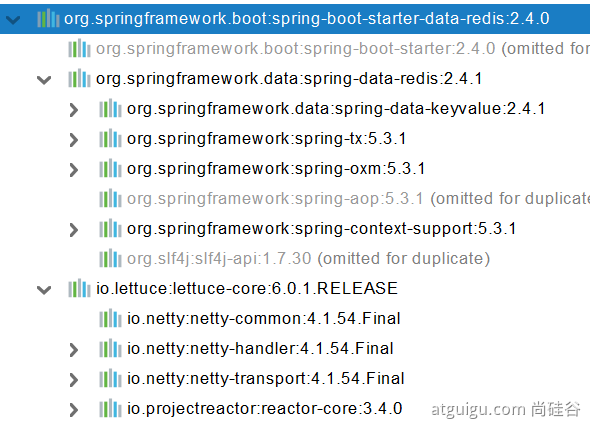
自动配置:
-
RedisAutoConfiguration自动配置类,RedisProperties属性类; -
连接工厂是准备好的,
LettuceConnectionConfiguration、JedisConnectionConfiguration; -
自动注入了
RedisTemplate<Object, Object>; -
自动注入了
StringRedisTemplate,键值都是String; -
我们只要使用
StringRedisTemplate、RedisTemplate就可以操作 Redis。
2.2 RedisTemplate 使用
@Test
void testRedis(){
ValueOperations<String, String> operations = redisTemplate.opsForValue();
operations.set("hello","world");
String hello = operations.get("hello");
System.out.println(hello);
}
2.3 切换至 Jedis
<dependency>
<groupId>org.springframework.boot</groupId>
<artifactId>spring-boot-starter-data-redis</artifactId>
</dependency>
<!-- 导入 Jedis-->
<dependency>
<groupId>redis.clients</groupId>
<artifactId>jedis</artifactId>
</dependency>
redis:
host: 172.20.134.231
port: 6379
client-type: jedis
jedis:
pool:
max-active: 10
八、单元测试
1、JUnit5 的变化
SpringBoot 2.2.0 版本开始引入 JUnit5 作为单元测试默认库。
作为最新版本的 JUnit 框架,JUnit5 与之前版本的 Junit 框架有很大的不同。由三个不同子项目的几个不同模块组成。
JUnit5 = JUnit Platform + JUnit Jupiter + JUnit Vintage
-
JUnit Platform:在 JVM 上启动测试框架的基础,不仅支持 Junit 自制的测试引擎,其他测试引擎也都可以接入。
-
JUnit Jupiter:提供了 JUnit5 的新的编程模型,是 JUnit5 新特性的核心。内部包含了一个测试引擎,用于在 Junit Platform 上运行。
-
JUnit Vintage:由于 JUint 已经发展多年,为了照顾老的项目,JUnit Vintage 提供了兼容 JUnit4.x、Junit3.x 的测试引擎。
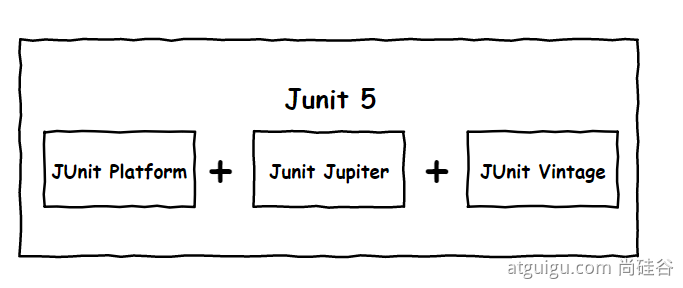
JUnit5:
<dependency>
<groupId>org.springframework.boot</groupId>
<artifactId>spring-boot-starter-test</artifactId>
<scope>test</scope>
</dependency>
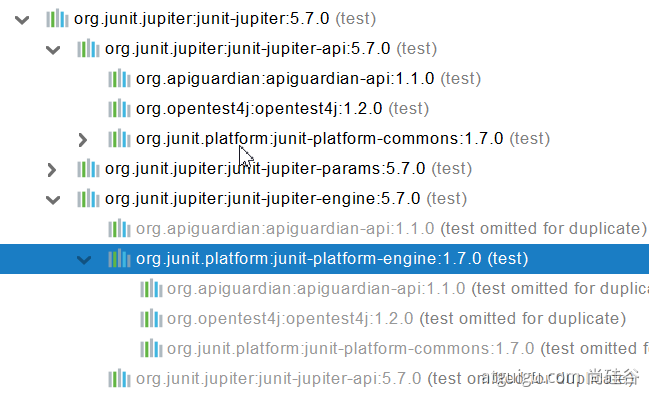
@SpringBootTest
class Boot05WebAdminApplicationTests {
@Test // 注意这里可以没有 public
void contextLoads() {
}
}
JUnit4:
SpringBoot 2.4 以上版本移除了默认对 Vintage 的依赖,如果需要兼容 JUnit4 需要自行引入。
<dependency>
<groupId>org.junit.vintage</groupId>
<artifactId>junit-vintage-engine</artifactId>
<scope>test</scope>
<exclusions>
<exclusion>
<groupId>org.hamcrest</groupId>
<artifactId>hamcrest-core</artifactId>
</exclusion>
</exclusions>
</dependency>
@RunWith(SpringRunner.class)
@SpringBootTest // 如果启动报错,则需要指定启动类的 class
class Boot05WebAdminApplicationTests {
@Test
public void contextLoads() {
}
}
SpringBoot 整合 JUnit 以后。
- 编写测试方法:
@Test标注(注意需要使用 JUnit5 版本的注解); - JUnit 类具有 Spring 的功能,
@Autowired、比如@Transactional标注测试方法,测试完成后自动回滚。
2、JUnit5 常用注解
JUnit5的注解与JUnit4的注解有所变化:
https://junit.org/junit5/docs/current/user-guide/#writing-tests-annotations
-
@Test:表示方法是测试方法。但是与 JUnit4 的@Test不同,他的职责非常单一不能声明任何属性,拓展的测试将会由 Jupiter 提供额外测试; -
@ParameterizedTest:表示方法是参数化测试,下方会有详细介绍; -
@RepeatedTest:表示方法可重复执行,下方会有详细介绍; -
@DisplayName:为测试类或者测试方法设置展示名称; -
@BeforeEach:表示在每个单元测试之前执行; -
@AfterEach:表示在每个单元测试之后执行; -
@BeforeAll:表示在所有单元测试之前执行; -
@AfterAll:表示在所有单元测试之后执行; -
@Tag:表示单元测试类别,类似于 JUnit4 中的@Categories; -
@Disabled:表示测试类或测试方法不执行,类似于 JUnit4 中的@Ignore; -
@Timeout:表示测试方法运行如果超过了指定时间将会返回错误; -
@ExtendWith:为测试类或测试方法提供扩展类引用。
import org.junit.jupiter.api.Test; // 注意这里使用的是 jupiter 的 Test 注解
@SpringBootTest
public class TestDemo {
@Test
@DisplayName("第一次测试")
public void firstTest() {
System.out.println("hello world");
}
3、断言(Assertions)
断言(Assertions)是测试方法中的核心部分,用来对测试需要满足的条件进行验证。这些断言方法都是 org.junit.jupiter.api.Assertions 的静态方法。JUnit5 内置的断言可以分成如下几个类别:
3.1 简单断言
用来对单个值进行简单的验证,如:
| 方法 | 说明 |
|---|---|
assertEquals |
判断两个对象或两个原始类型是否相等 |
assertNotEquals |
判断两个对象或两个原始类型是否不相等 |
assertSame |
判断两个对象引用是否指向同一个对象 |
assertNotSame |
判断两个对象引用是否指向不同的对象 |
assertTrue |
判断给定的布尔值是否为 true |
assertFalse |
判断给定的布尔值是否为 false |
assertNull |
判断给定的对象引用是否为 null |
assertNotNull |
判断给定的对象引用是否不为 null |
@Test
@DisplayName("simple assertion")
public void simple() {
assertEquals(3, 1 + 2, "simple math");
assertNotEquals(3, 1 + 1);
assertNotSame(new Object(), new Object());
Object obj = new Object();
assertSame(obj, obj);
assertFalse(1 > 2);
assertTrue(1 < 2);
assertNull(null);
assertNotNull(new Object());
}
3.2 数组断言
通过 assertArrayEquals 方法来判断两个对象或原始类型的数组内容是否相等:
@Test
@DisplayName("array assertion")
public void array() {
assertArrayEquals(new int[]{1, 2}, new int[] {1, 2});
}
3.3 组合断言
assertAll 方法接受多个 org.junit.jupiter.api.Executable 函数式接口的实例作为要验证的断言,可以通过 lambda 表达式很容易的提供这些断言:
@Test
@DisplayName("assert all")
public void all() {
assertAll("Math",
() -> assertEquals(2, 1 + 1),
() -> assertTrue(1 > 0)
);
}
3.4 异常断言
在 JUnit4 时期,想要测试方法的异常情况时,需要用 @Rule 注解的 ExpectedException 变量还是比较麻烦的。而 JUnit5 提供了一种新的断言方式 Assertions.assertThrows(),配合函数式编程就可以进行使用:
@Test
@DisplayName("异常测试")
public void exceptionTest() { // 扔出断言异常
ArithmeticException exception = Assertions.assertThrows(
ArithmeticException.class, () -> System.out.println(1 % 0));
}
3.5 超时断言
Junit5 还提供了 Assertions.assertTimeout() 为测试方法设置了超时时间:
@Test
@DisplayName("超时测试")
public void timeoutTest() {
// 如果测试方法时间超过 1s 将会异常
Assertions.assertTimeout(Duration.ofMillis(1000), () -> Thread.sleep(500));
}
3.6 快速失败
通过 fail 方法直接使得测试失败:
@Test
@DisplayName("fail")
public void shouldFail() {
fail("This should fail");
}
4、前置条件(Assumptions)
JUnit 5 中的前置条件(Assumptions【假设】)类似于断言,不同之处在于不满足的断言会使得测试方法失败,而不满足的前置条件只会使得测试方法的执行终止。前置条件可以看成是测试方法执行的前提,当该前提不满足时,就没有继续执行的必要。
@DisplayName("前置条件")
public class AssumptionsTest {
private final String environment = "DEV";
@Test
@DisplayName("simple")
public void simpleAssume() {
assumeTrue(Objects.equals(this.environment, "DEV"));
assumeFalse(() -> Objects.equals(this.environment, "PROD"));
}
@Test
@DisplayName("assume then do")
public void assumeThenDo() {
assumingThat(
Objects.equals(this.environment, "DEV"),
() -> System.out.println("In DEV")
);
}
}
assumeTrue 和 assumFalse 确保给定的条件为 true 或 false,不满足条件会使得测试执行终止。assumingThat 的参数是表示条件的布尔值和对应的 Executable 接口的实现对象。只有条件满足时,Executable 对象才会被执行;当条件不满足时,测试执行并不会终止。
5、嵌套测试
JUnit5 可以通过 Java 中的内部类和 @Nested 注解实现嵌套测试,从而可以更好的把相关的测试方法组织在一起。在内部类中可以使用 @BeforeEach 和 @AfterEach 注解,而且嵌套的层次没有限制。
内层的 test 可以驱动外层的 Before(After)Each/All 之类的方法提前/延后运行,外层的不能驱动内层的。
@DisplayName("A stack")
class TestingAStackDemo {
Stack<Object> stack;
@Test
@DisplayName("is instantiated with new Stack()")
void isInstantiatedWithNew() {
new Stack<>();
}
@Nested
@DisplayName("when new")
class WhenNew {
@BeforeEach
void createNewStack() {
stack = new Stack<>();
}
@Test
@DisplayName("is empty")
void isEmpty() {
assertTrue(stack.isEmpty());
}
@Test
@DisplayName("throws EmptyStackException when popped")
void throwsExceptionWhenPopped() {
assertThrows(EmptyStackException.class, stack::pop);
}
@Test
@DisplayName("throws EmptyStackException when peeked")
void throwsExceptionWhenPeeked() {
assertThrows(EmptyStackException.class, stack::peek);
}
@Nested
@DisplayName("after pushing an element")
class AfterPushing {
String anElement = "an element";
@BeforeEach
void pushAnElement() {
stack.push(anElement);
}
@Test
@DisplayName("it is no longer empty")
void isNotEmpty() {
assertFalse(stack.isEmpty());
}
@Test
@DisplayName("returns the element when popped and is empty")
void returnElementWhenPopped() {
assertEquals(anElement, stack.pop());
assertTrue(stack.isEmpty());
}
@Test
@DisplayName("returns the element when peeked but remains not empty")
void returnElementWhenPeeked() {
assertEquals(anElement, stack.peek());
assertFalse(stack.isEmpty());
}
}
}
}
6、参数化测试
参数化测试是 JUnit5 很重要的一个新特性,它使得用不同的参数多次运行测试成为了可能,也为我们的单元测试带来许多便利。
利用 @ValueSource 等注解,指定入参,我们将可以使用不同的参数进行多次单元测试,而不需要每新增一个参数就新增一个单元测试,省去了很多冗余代码。
-
@ValueSource:为参数化测试指定入参来源,支持八大基础类以及String类型,Class类型; -
@NullSource:表示为参数化测试提供一个null的入参; -
@EnumSource:表示为参数化测试提供一个枚举入参; -
@CsvFileSource:表示读取指定 CSV 文件内容作为参数化测试入参; -
@MethodSource:表示读取指定静态方法的返回值作为参数化测试入参,注意方法返回需要是一个Stream。
当然如果参数化测试仅仅只能做到指定普通的入参,还达不到让我觉得惊艳的地步。让我真正感到他的强大之处的地方在于他可以支持外部的各类入参。如 CSV、YAML、JSON 文件甚至方法的返回值也可以作为入参。只需要去实现 ArgumentsProvider 接口,任何外部文件都可以作为它的入参。
@ParameterizedTest
@ValueSource(strings = {"one", "two", "three"})
@DisplayName("参数化测试1")
public void parameterizedTest1(String string) {
System.out.println(string);
Assertions.assertTrue(StringUtils.isNotBlank(string));
}
@ParameterizedTest
@MethodSource("method") // 指定方法名
@DisplayName("方法来源参数")
public void testWithExplicitLocalMethodSource(String name) {
System.out.println(name);
Assertions.assertNotNull(name);
}
static Stream<String> method() {
return Stream.of("apple", "banana");
}
7、迁移指南
在进行迁移的时候需要注意如下的变化:
-
注解在 org.junit.jupiter.api 包中,断言在 org.junit.jupiter.api.
Assertions类中,前置条件在 org.junit.jupiter.api.``Assumptions` 类中; -
把
@Before和@After替换成@BeforeEach和@AfterEach; -
把
@BeforeClass和@AfterClass替换成@BeforeAll和@AfterAll; -
把
@Ignore替换成@Disabled; -
把
@Category替换成@Tag; -
把
@RunWith、@Rule和@ClassRule替换成@ExtendWith。
九、指标监控
1、SpringBoot Actuator
1.1 简介
未来每一个微服务在云上部署以后,我们都需要对其进行监控、追踪、审计、控制等。SpringBoot 就抽取了 Actuator 场景,使得我们每个微服务快速引用即可获得生产级别的应用监控、审计等功能。
<dependency>
<groupId>org.springframework.boot</groupId>
<artifactId>spring-boot-starter-actuator</artifactId>
</dependency>

1.2 1.x 与 2.x 的不同
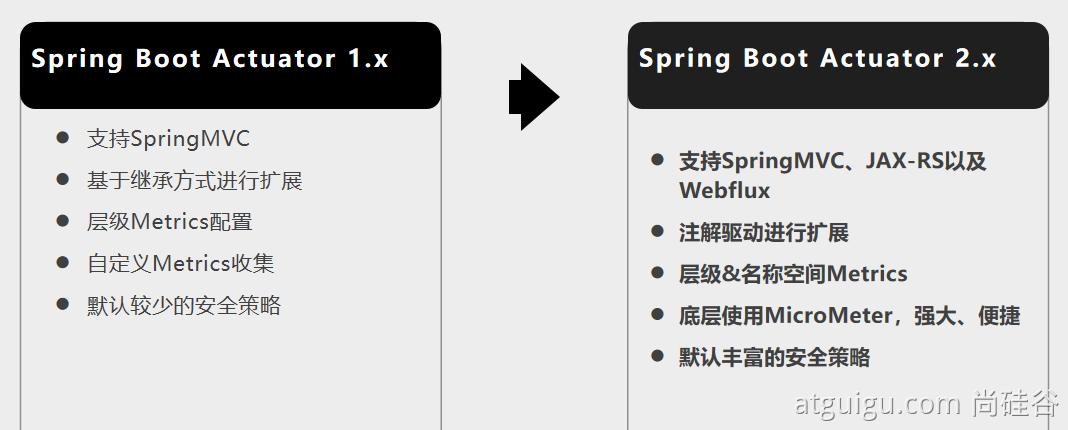
1.3 如何使用
-
引入场景 starter;
-
暴露所有监控信息为 HTTP;
management:
endpoints:
enabled-by-default: true # 暴露所有端点信息
web:
exposure:
include: '*' # 以 Web 方式暴露
- 测试。
http://localhost:8080/actuator/beans
http://localhost:8080/actuator/configprops
http://localhost:8080/actuator/metrics
http://localhost:8080/actuator/metrics/jvm.gc.pause
http://localhost:8080/actuator/endpointName/detailPath
1.4 可视化
https://github.com/codecentric/spring-boot-admin
2、Actuator Endpoint
2.1 最常使用的 Endpoint
| ID | 描述 |
|---|---|
auditevents |
暴露当前应用程序的审核事件信息。需要一个 AuditEventRepository 组件。 |
beans |
显示应用程序中所有 Bean 的完整列表。 |
caches |
暴露可用的缓存。 |
conditions |
显示自动配置的所有条件信息,包括匹配或不匹配的原因。 |
configprops |
显示所有 @ConfigurationProperties。 |
env |
暴露 Spring 的属性 ConfigurableEnvironment。 |
flyway |
显示已应用的所有 Flyway 数据库迁移, 需要一个或多个 Flyway 组件。 |
health |
显示应用程序运行状况信息。 |
httptrace |
显示 HTTP 跟踪信息(默认情况下,最近 100 个 HTTP 请求-响应)。需要一个 HttpTraceRepository 组件。 |
info |
显示应用程序信息。 |
integrationgraph |
显示Spring integrationgraph 。需要依赖 spring-integration-core。 |
loggers |
显示和修改应用程序中日志的配置。 |
liquibase |
显示已应用的所有 Liquibase 数据库迁移。需要一个或多个Liquibase组件。 |
metrics |
显示当前应用程序的指标信息。 |
mappings |
显示所有 @RequestMapping 路径列表。 |
scheduledtasks |
显示应用程序中的计划任务。 |
sessions |
允许从 Spring Session 支持的会话存储中检索和删除用户会话。需要使用 Spring Session 的基于 Servlet 的 Web 应用程序。 |
shutdown |
使应用程序正常关闭,默认禁用。 |
startup |
显示由 ApplicationStartup 收集的启动步骤数据。需要使用 SpringApplication 进行配置 BufferingApplicationStartup。 |
threaddump |
执行线程转储。 |
如果您的应用程序是 Web 应用程序(Spring MVC,Spring WebFlux 或 Jersey),则可以使用以下附加端点:
| ID | 描述 |
|---|---|
heapdump |
返回 hprof 堆转储文件。 |
jolokia |
通过 HTTP 暴露 JMX Bean(需要引入 Jolokia,不适用于 WebFlux)。需要引入依赖 jolokia-core。 |
logfile |
返回日志文件的内容(如果已设置 logging.file.name 或 logging.file.path 属性)。支持使用 HTTP Range 标头来检索部分日志文件的内容。 |
prometheus |
以 Prometheus 服务器可以抓取的格式公开指标。需要依赖 micrometer-registry-prometheus。 |
最常用的 Endpoint:
-
Health:监控状况 -
Metrics:运行时指标 -
Loggers:日志记录
2.2 Health Endpoint
健康检查端点,我们一般用于在云平台,平台会定时的检查应用的健康状况,我们就需要 Health Endpoint 可以为平台返回当前应用的一系列组件健康状况的集合。
重要的几点:
-
Health Endpoint 返回的结果,应该是一系列健康检查后的一个汇总报告;
-
很多的健康检查默认已经自动配置好了,比如数据库、Redis 等;
-
可以很容易的添加自定义的健康检查机制。

2.3 Metrics Endpoint
提供详细的、层级的、空间指标信息,这些信息可以被 pull(主动推送)或者 push(被动获取)方式得到;
-
通过 Metrics 对接多种监控系统;
-
简化核心 Metrics 开发;
-
添加自定义 Metrics 或者扩展已有 Metrics。
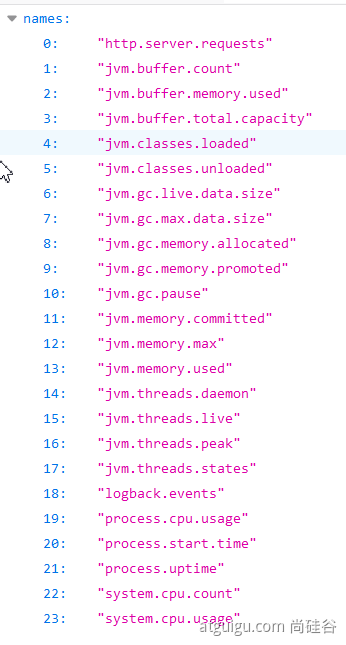
2.4 管理 Endpoints
2.4.1 开启与禁用 Endpoints
- 默认所有的 Endpoint 除了
shutdown都是开启的; - 需要开启或者禁用某个 Endpoint。配置模式为
management.endpoint.<endpointName>.enabled = true;
management:
endpoint:
beans:
enabled: true
- 或者禁用所有的 Endpoint 然后手动开启指定的 Endpoint。
management:
endpoints:
enabled-by-default: false
endpoint:
beans:
enabled: true
health:
enabled: true
2.4.2 暴露 Endpoints
支持的暴露方式
-
HTTP:默认只暴露 Health 和Info Endpoint;
-
JMX:默认暴露所有 Endpoint,JConsole 就是通过 JMX 实现的;
-
除了 Health 和 Info,剩下的 Endpoint 都应该进行保护访问。如果引入
SpringSecurity,则会默认配置安全访问规则。
| ID | JMX | Web |
|---|---|---|
auditevents |
Yes | No |
beans |
Yes | No |
caches |
Yes | No |
conditions |
Yes | No |
configprops |
Yes | No |
env |
Yes | No |
flyway |
Yes | No |
health |
Yes | Yes |
heapdump |
N/A | No |
httptrace |
Yes | No |
info |
Yes | Yes |
integrationgraph |
Yes | No |
jolokia |
N/A | No |
logfile |
N/A | No |
loggers |
Yes | No |
liquibase |
Yes | No |
metrics |
Yes | No |
mappings |
Yes | No |
prometheus |
N/A | No |
scheduledtasks |
Yes | No |
sessions |
Yes | No |
shutdown |
Yes | No |
startup |
Yes | No |
threaddump |
Yes | No |
3、定制 Endpoint
3.1 定制 Health 信息
@Component
public class MyHealthIndicator implements HealthIndicator {
@Override
public Health health() {
int errorCode = check(); // perform some specific health check
if (errorCode != 0) {
return Health.down().withDetail("Error Code", errorCode).build();
}
return Health.up().build();
}
}
// 构建 Health
Health build = Health.down()
.withDetail("msg", "error service")
.withDetail("code", "500")
.withException(new RuntimeException())
.build();
management:
health:
enabled: true
show-details: always # 总是显示详细信息,可显示每个模块的状态信息
@Component
public class MyComHealthIndicator extends AbstractHealthIndicator {
// 真实的检查方法
@Override
protected void doHealthCheck(Health.Builder builder) throws Exception {
// MongoDB,获取连接进行测试
Map<String,Object> map = new HashMap<>();
// 检查完成
if(1 == 2){
// builder.up(); // 健康
builder.status(Status.UP);
map.put("count",1);
map.put("ms",100);
}else {
// builder.down();
builder.status(Status.OUT_OF_SERVICE);
map.put("err","连接超时");
map.put("ms",3000);
}
builder.withDetail("code",100).withDetails(map);
}
}
3.2 定制info信息
常用两种方式:
3.2.1 编写配置文件
info:
appName: boot-admin
version: 2.0.1
mavenProjectName: @project.artifactId@ #使用@@可以获取maven的pom文件值
mavenProjectVersion: @project.version@
3.2.2 编写 InfoContributor
@Component
public class ExampleInfoContributor implements InfoContributor {
@Override
public void contribute(Info.Builder builder) {
builder.withDetail("example",
Collections.singletonMap("key", "value"));
}
}
http://localhost:8080/actuator/info:会输出以上方式返回的所有 Info 信息。
3.3 定制 Metrics 信息
3.3.1 SpringBoot 支持自动适配的 Metrics
-
JVM metrics, report utilization of:
-
Various memory and buffer pools
-
Statistics related to garbage collection
-
Threads utilization
-
Number of classes loaded/unloaded
-
CPU metrics
-
File descriptor metrics
-
Kafka consumer and producer metrics
-
Log4j2 metrics: record the number of events logged to Log4j2 at each level
-
Logback metrics: record the number of events logged to Logback at each level
-
Uptime metrics: report a gauge for uptime and a fixed gauge representing the application’s absolute start time
-
Tomcat metrics (
server.tomcat.mbeanregistry.enabledmust be set totruefor all Tomcat metrics to be registered) -
Spring Integration metrics
3.2.2 增加定制 Metrics
class MyService{
Counter counter;
public MyService(MeterRegistry meterRegistry){
counter = meterRegistry.counter("myservice.method.running.counter");
}
public void hello() {
counter.increment();
}
}
// 也可以使用下面的方式
@Bean
MeterBinder queueSize(Queue queue) {
return (registry) -> Gauge.builder("queueSize", queue::size).register(registry);
}
3.4定制 Endpoint
@Component
@Endpoint(id = "container")
public class DockerEndpoint {
@ReadOperation
public Map getDockerInfo(){
return Collections.singletonMap("info","docker started...");
}
@WriteOperation
private void restartDocker(){
System.out.println("docker restarted....");
}
}
场景:开发 ReadinessEndpoint 来管理程序是否就绪,或者 **Liveness Endpoint **来管理程序是否存活。
十、原理解析
10.1 Profile 功能
为了方便多环境适配,SpringBoot 简化了 Profile 功能。
10.1.1 application-profile 功能
-
默认配置文件 application.yaml 任何时候都会加载;
-
环境配置文件 application-{env}.yaml;
-
激活指定环境;
- 配置文件激活;
- 命令行激活:``java -jar xxx.jar --spring.profiles.active=prod --person.name=haha`。
- 优先级:命令行 > 环境配置文件 > 默认配置文件
-
默认配置与环境配置同时生效;
-
同名配置项,Profile 配置优先;
10.1.2 @Profile 条件装配功能
@Configuration(proxyBeanMethods = false)
@Profile("production")
public class ProductionConfiguration {
// ...
}
10.1.3 Profile 分组
spring.profiles.group.production[0]=proddb
spring.profiles.group.production[1]=prodmq
# 使用:--spring.profiles.active=production 激活
10.2 外部化配置
Spring Boot uses a very particular PropertySource order that is designed to allow sensible overriding of values. Properties are considered in the following order (with values from lower items overriding earlier ones):
- Default properties (specified by setting
SpringApplication.setDefaultProperties). @PropertySourceannotations on your@Configurationclasses. Please note that such property sources are not added to theEnvironmentuntil the application context is being refreshed. This is too late to configure certain properties such aslogging.*andspring.main.*which are read before refresh begins.- Config data (such as
application.propertiesfiles) - A
RandomValuePropertySourcethat has properties only inrandom.*. - OS environment variables.
- Java System properties (
System.getProperties()). - JNDI attributes from
java:comp/env. ServletContextinit parameters.ServletConfiginit parameters.- Properties from
SPRING_APPLICATION_JSON(inline JSON embedded in an environment variable or system property). - Command line arguments.
propertiesattribute on your tests. Available on@SpringBootTestand the test annotations for testing a particular slice of your application.@TestPropertySourceannotations on your tests.- Devtools global settings properties in the
$HOME/.config/spring-bootdirectory when devtools is active.
Config data files are considered in the following order:
- Application properties packaged inside your jar (
application.propertiesand YAML variants). - Profile-specific application properties packaged inside your jar (
application-{profile}.propertiesand YAML variants). - Application properties outside of your packaged jar (
application.propertiesand YAML variants). - Profile-specific application properties outside of your packaged jar (
application-{profile}.propertiesand YAML variants).
10.2.1 外部配置源
常用:Java 属性文件、环境变量、命令行参数、**YAML **文件。
10.2.2 配置文件查找位置
越往下优先级越高,会覆盖上面的配置:
- classpath 根路径;
- classpath 根路径下 config 目录;
- jar 包当前目录;
- jar 包当前目录的 config 目录;
- /config 子目录的直接子目录。
10.2.3 配置文件加载顺序:
- 当前jar包内部的application.properties和application.yml
- 当前jar包内部的application-{profile}.properties 和 application-{profile}.yml
- 引用的外部jar包的application.properties和application.yml
- 引用的外部jar包的application-{profile}.properties 和 application-{profile}.yml
10.2.4 指定环境优先,外部优先,后面的可以覆盖前面的同名配置项
10.3 自定义 starter
10.3.1 starter 启动原理
- starter-pom 引入 autoconfigurer 包;
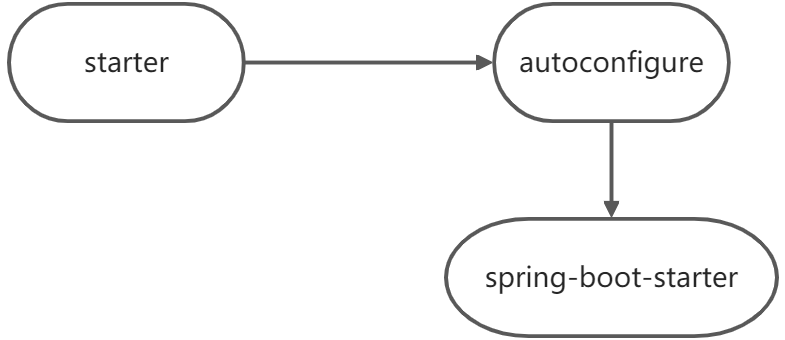
- autoconfigure 包中配置使用 META-INF/spring.factories 中
EnableAutoConfiguration的值,使得项目启动时加载指定的自动配置类; - 编写自动配置类
xxxAutoConfiguration->xxxxProperties; - 编写业务:``@Configuration
、@Conditional、@EnableConfigurationProperties、@Bean`......
引入 starter --- xxxAutoConfiguration --- 容器中放入组件 ---- 绑定 xxxProperties ---- 配置项
10.3.2 自定义 starter
atguigu-hello-spring-boot-starter(启动器)
atguigu-hello-spring-boot-starter-autoconfigure(自动配置包)
10.4 SpringBoot 原理
Spring原理【Spring注解】、SpringMVC 原理、自动配置原理
10.4.1 SpringBoot 启动过程
- 创建
SpringApplication;- 保存一些信息;
- 用工具类
ClassUtils获取到应用类型为Servlet、还可能为 Reactive 或 None; - 去 spring.factories 找
Bootstrapper;List<Bootstrapper> bootstrappers
- 去 spring.factories 找
ApplicationContextInitializer;List<ApplicationContextInitializer<?>> initializers
- 去 spring.factories 找
ApplicationListenerList<ApplicationListener<?>> listeners
- 运行
SpringApplication。StopWatch用于监听整个应用的启动停止;- 记录应用的启动时间;
- 调用
createBootstrapContext()创建引导上下文(Context环境);- 获取到所有之前的
bootstrappers挨个执行intitialize()来设置引导启动器上下文环境
- 获取到所有之前的
- 让当前应用进入 java.awt.
headless模式(自力更生模式); - 获取所有
RunListener(运行监听器),为了方便所有Listener进行事件感知;getSpringFactoriesInstances()去 spring.factories 找SpringApplicationRunListener
- 遍历
SpringApplicationRunListener调用starting()方法;- 相当于通知所有感兴趣系统正在启动过程的人,项目正在 starting
- 保存命令行参数
ApplicationArguments; - 准备环境
prepareEnvironment();- 返回或者创建基础环境信息对象
StandardServletEnvironment; - 配置环境信息对象;
- 读取所有的配置源的配置属性值
- 绑定环境信息;
- 监听器调用 `listener.environmentPrepared() 通知所有的监听器当前环境准备完成。
- 返回或者创建基础环境信息对象
- 创建 IOC 容器
createApplicationContext;- 根据项目类型(
Servlet)创建容器; - 当前会创建
AnnotationConfigServletWebServerApplicationContext。
- 根据项目类型(
- 准备
ApplicationContext容器的基本信息prepareContext()- 保存环境信息;
- IOC容器的后置处理流程;
- 应用初始化器
applyInitializers();- 遍历所有的
ApplicationContextInitializer,调用initialize()来对容器进行初始化扩展功能; - 遍历所有的
listener调用contextPrepared()。通知所有的监听器EventPublishRunListenr上下文准备完成。
- 遍历所有的
- 所有的监听器调用
contextLoaded(),通知所有的监听器上下文加载完成;
- 刷新容器
refreshContext();- 创建容器中的所有组件(Spring 注解)
- 容器刷新完成后工作
afterRefresh(); - 所有监听器调用
listeners.started(context)通知所有的监听器启动完成; - 调用所有
callRunners();- 获取容器中的
ApplicationRunner; - 获取容器中的
CommandLineRunner(执行数据初始化等操作); - 合并所有 runner 并且按照
@Order进行排序; - 遍历所有的 runner 调用
run()方法。
- 获取容器中的
- 如果以上有异常;
- 调用
Listener的failed()方法通知所有的监听器 failed
- 调用
- 调用所有监听器的
listeners.running(context)通知所有的监听器正在运行; - running 如果有问题,继续调调用
Listener的failed()方法通知所有的监听器 failed。
Spring 的核心方法实际调用的是抽象类
ApplicationContext.refresh()方法。该方法是一种模版方法的设计模式,定义了方法的执行顺序和骨架,其中onRefresh()是一个抽象方法,由具体子类实现。因为启动的是 Web 版的容器因此执行的是
ServletWebServerApplicationContext.refresh()方法。该方法从容器中获得一个ServletWebServerFactory工厂(如果有多个工厂,则抛异常),根据工厂对象获得WebServer对象。因为内嵌 Tomcat,所以是
TomcatWevServer后续通过new Tomcat()并执行start()启动 Tomcat 服务器。
public interface Bootstrapper {
/**
* Initialize the given {@link BootstrapRegistry} with any required registrations.
* @param registry the registry to initialize
*/
void intitialize(BootstrapRegistry registry);
}
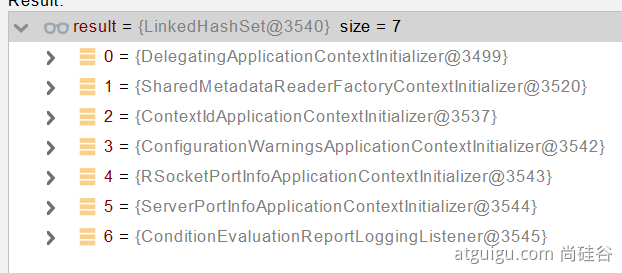
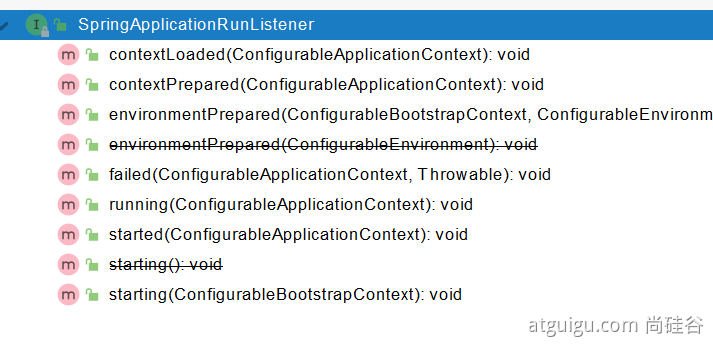

@FunctionalInterface
public interface ApplicationRunner {
/**
* Callback used to run the bean.
* @param args incoming application arguments
* @throws Exception on error
*/
void run(ApplicationArguments args) throws Exception;
}
@FunctionalInterface
public interface CommandLineRunner {
/**
* Callback used to run the bean.
* @param args incoming main method arguments
* @throws Exception on error
*/
void run(String... args) throws Exception;
}
10.4.2 Application Events and Listeners
ApplicationContextInitializer
ApplicationListener
SpringApplicationRunListener



